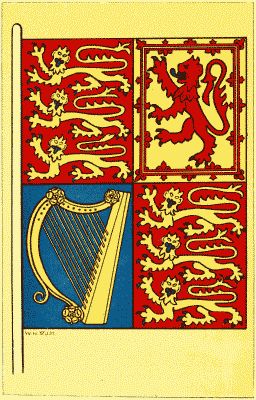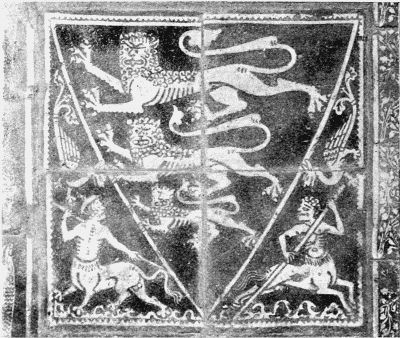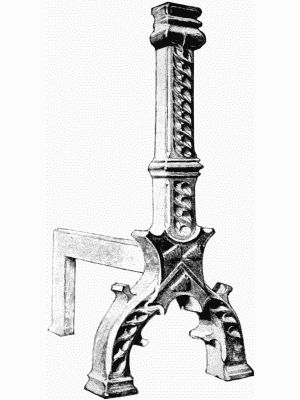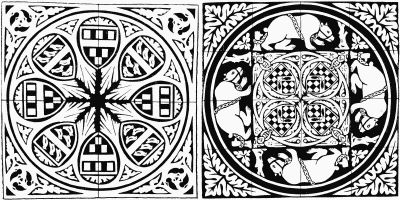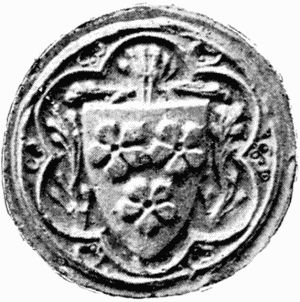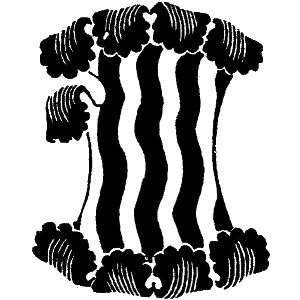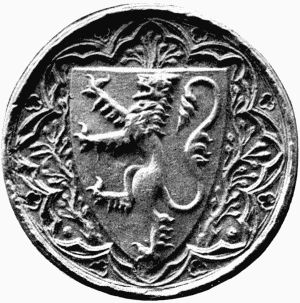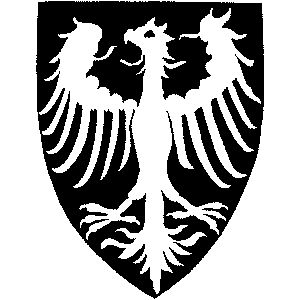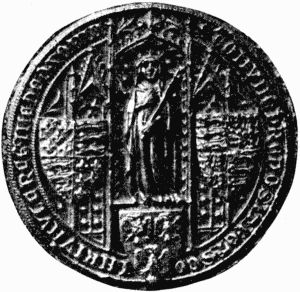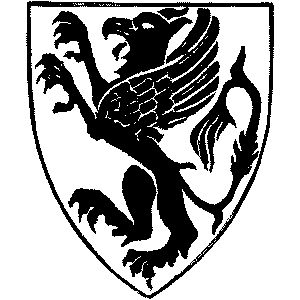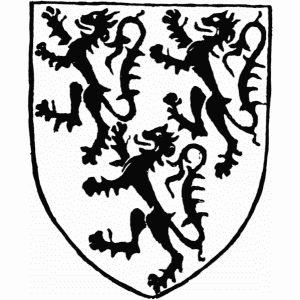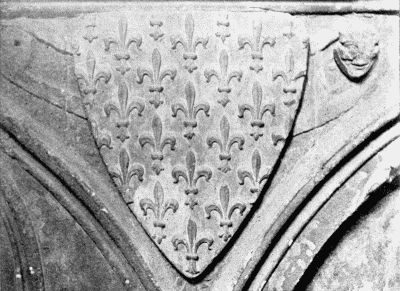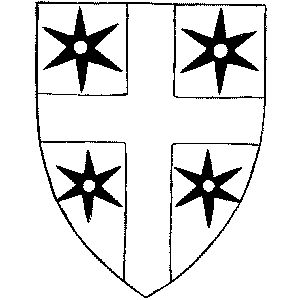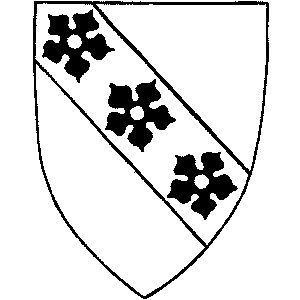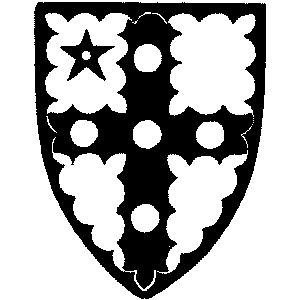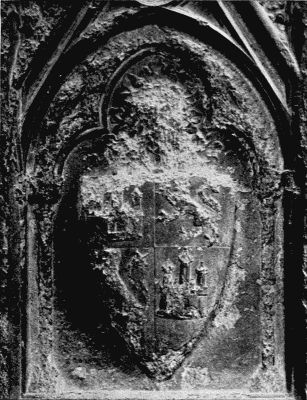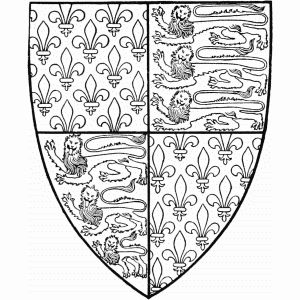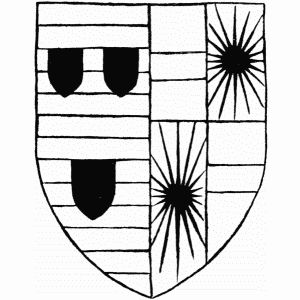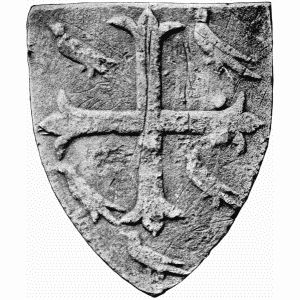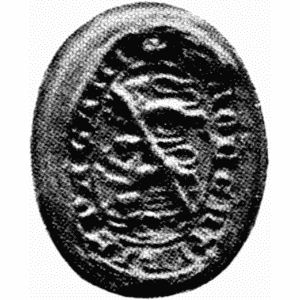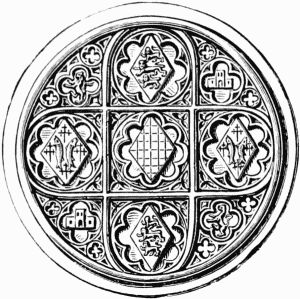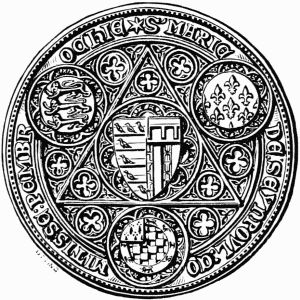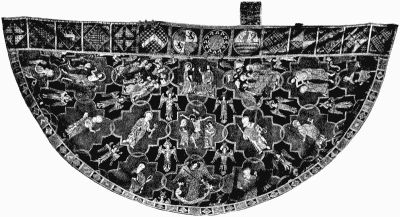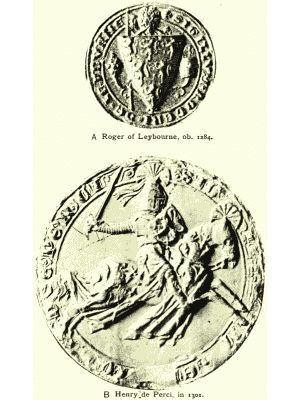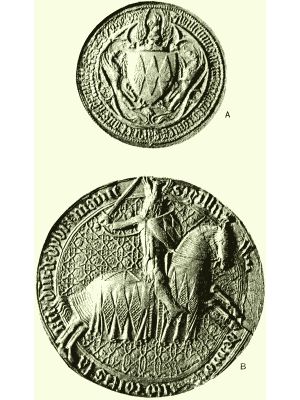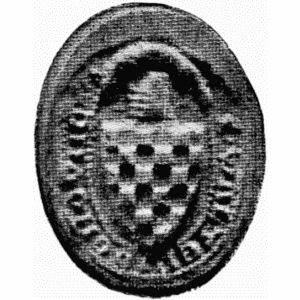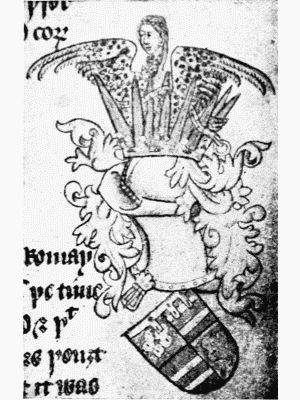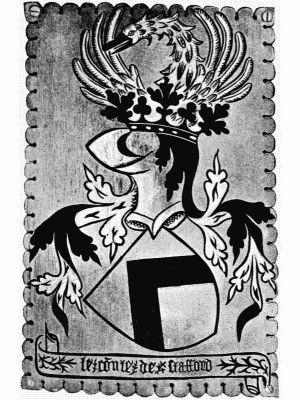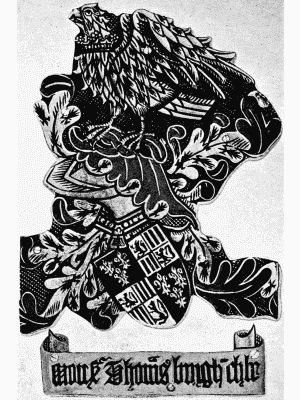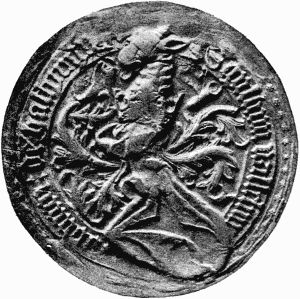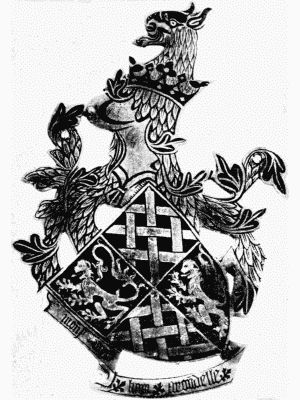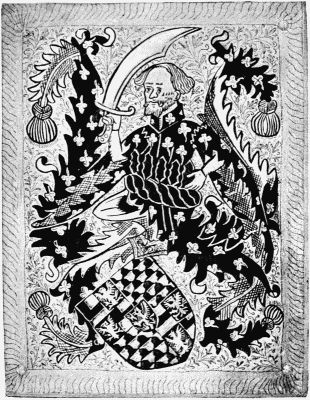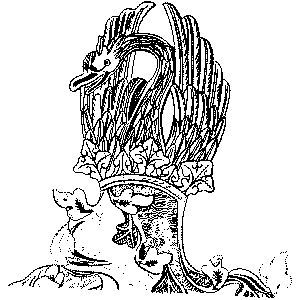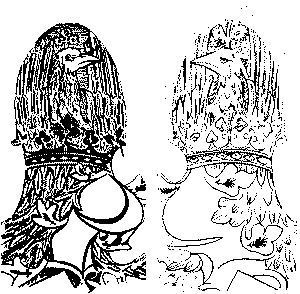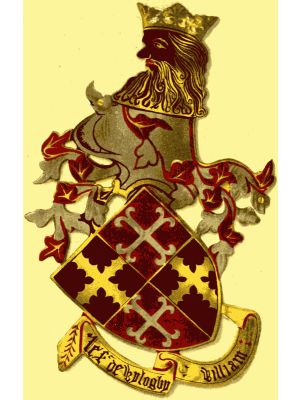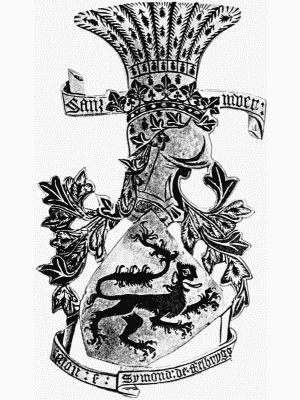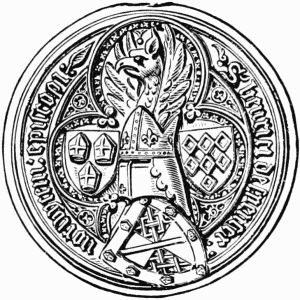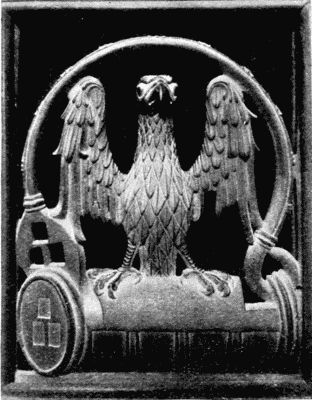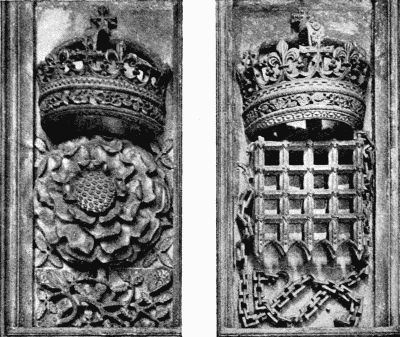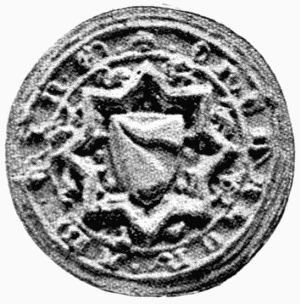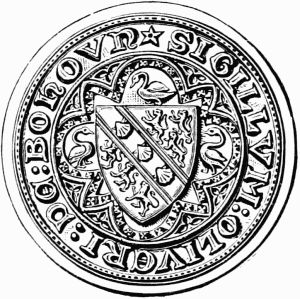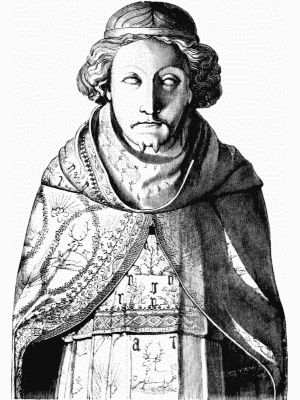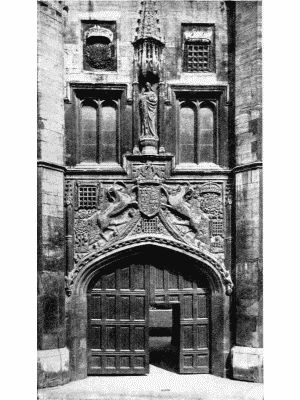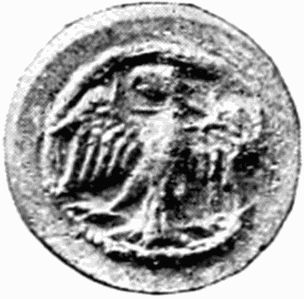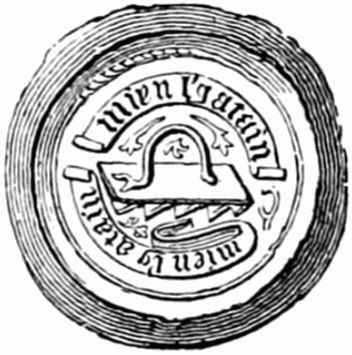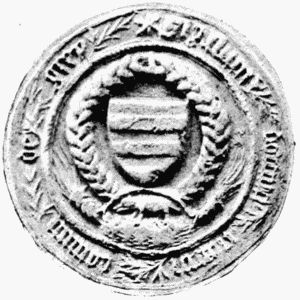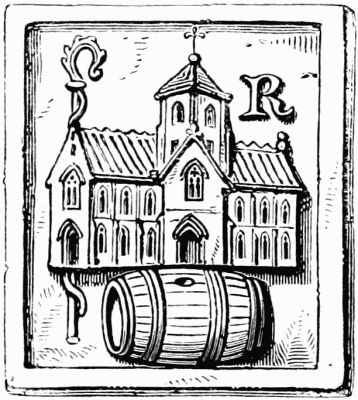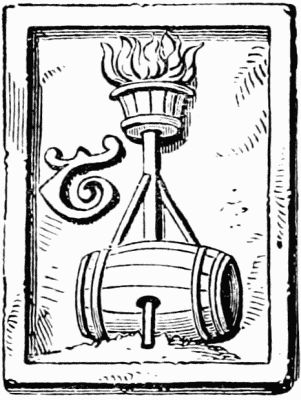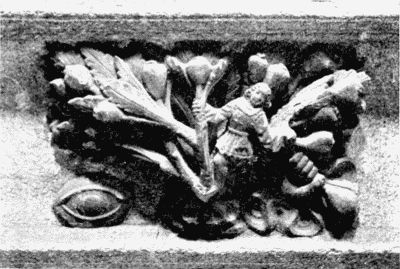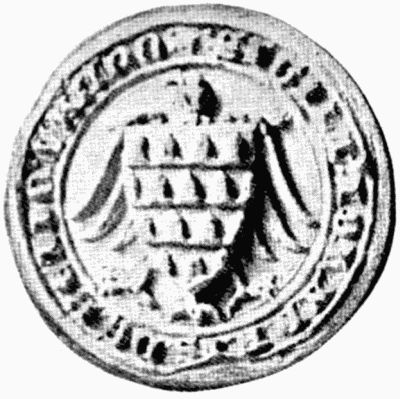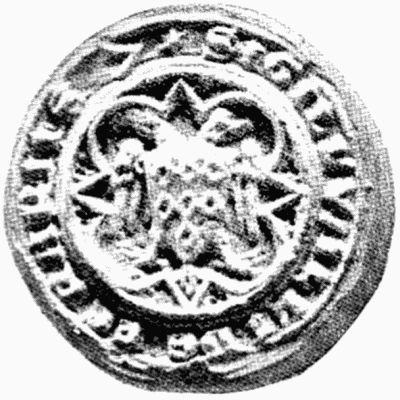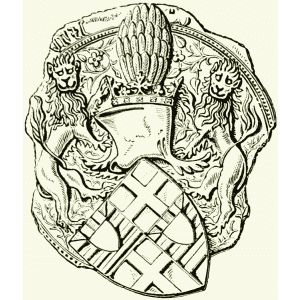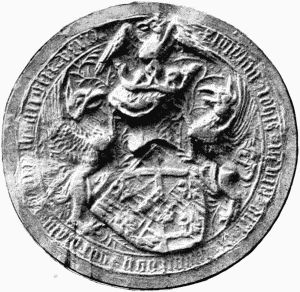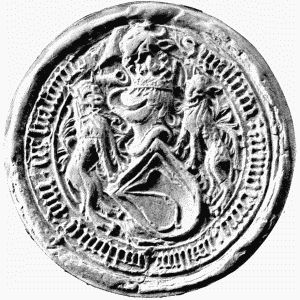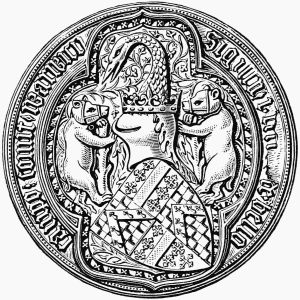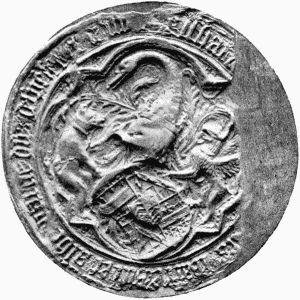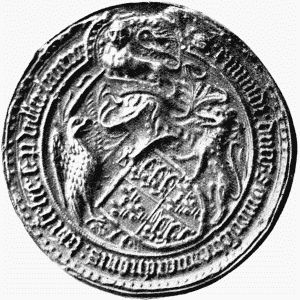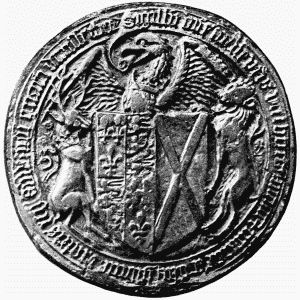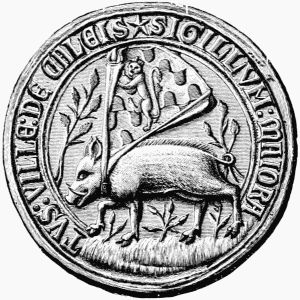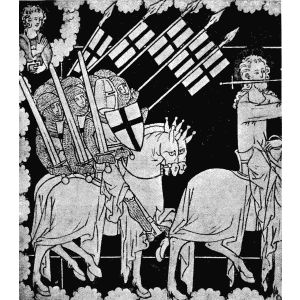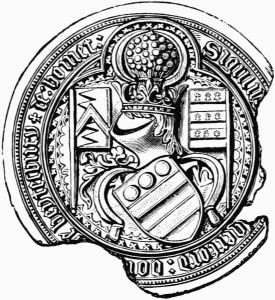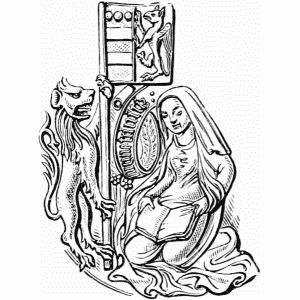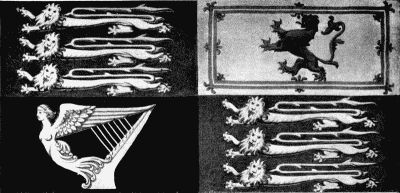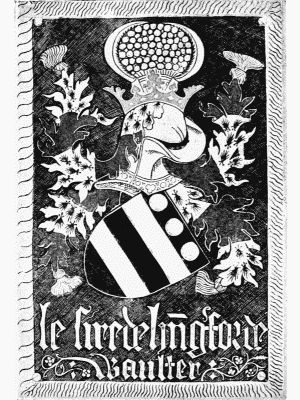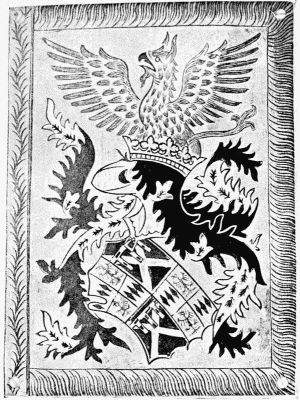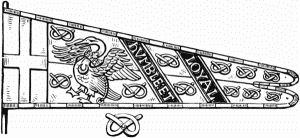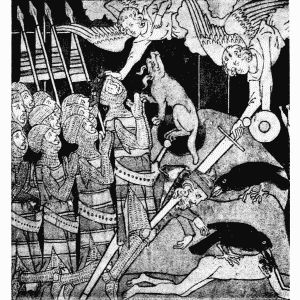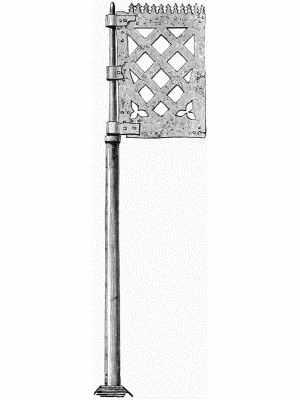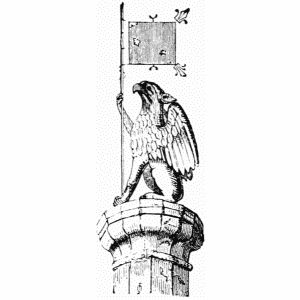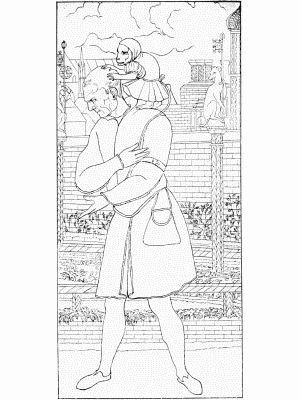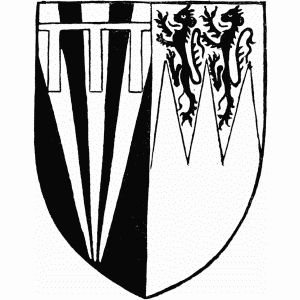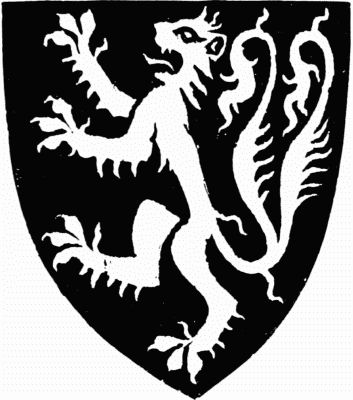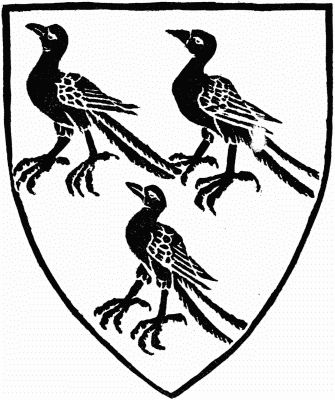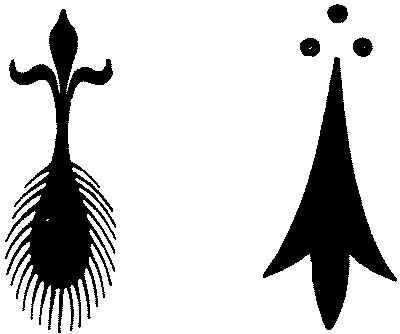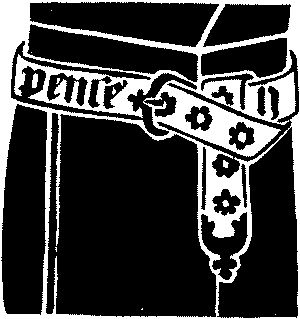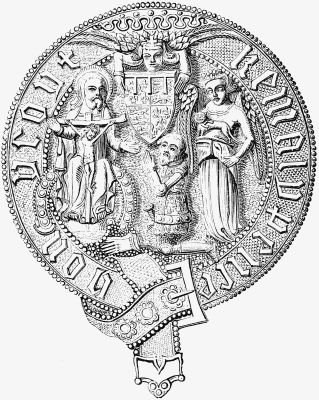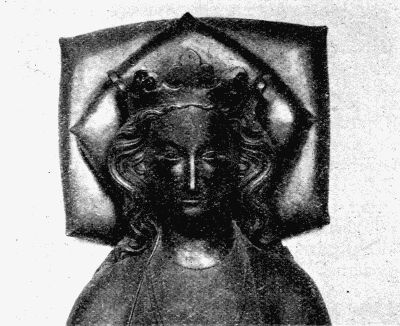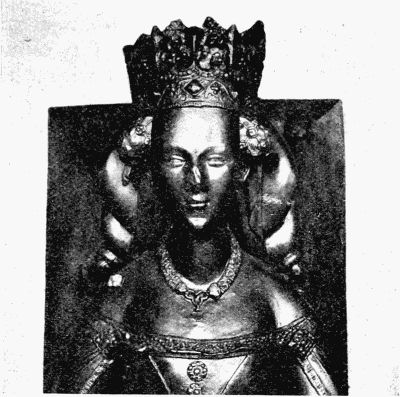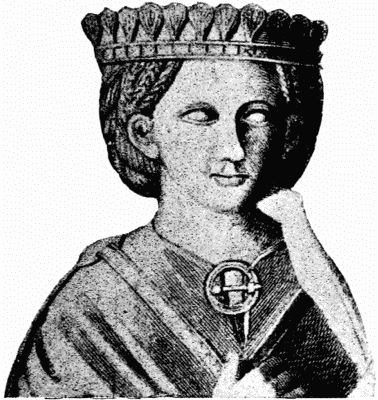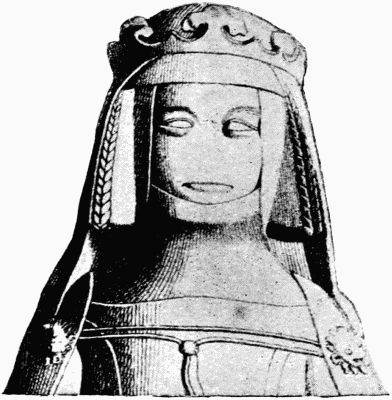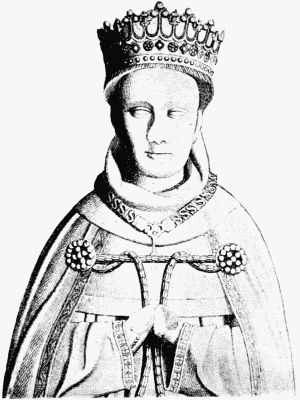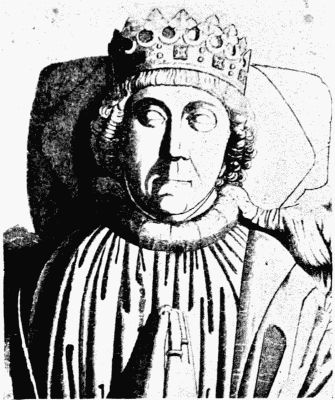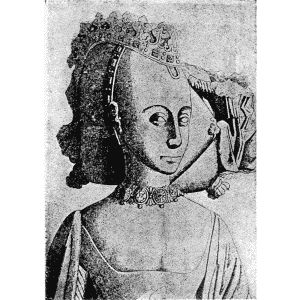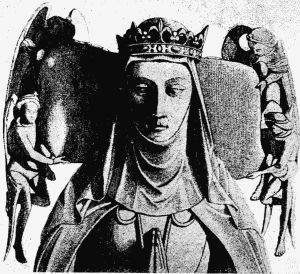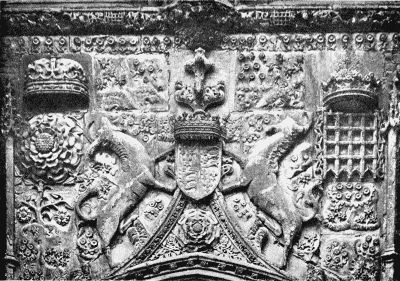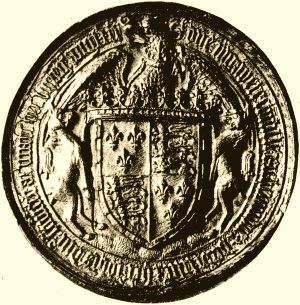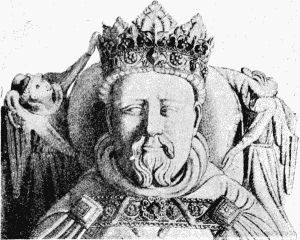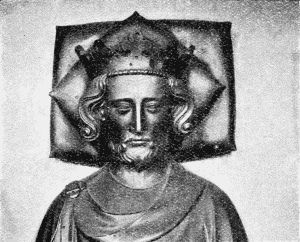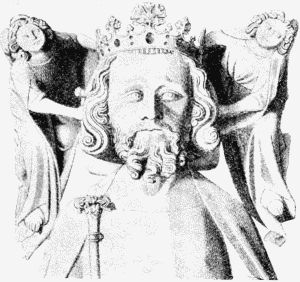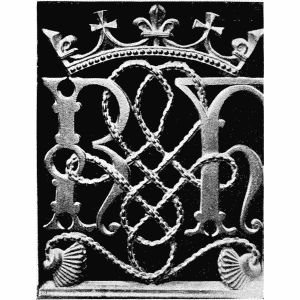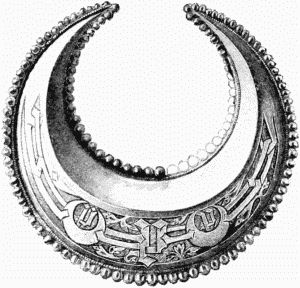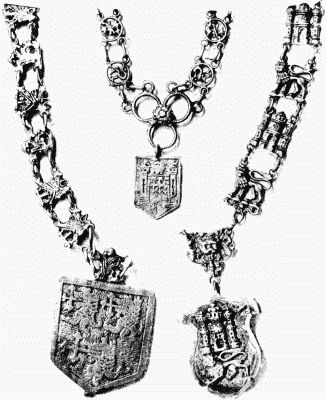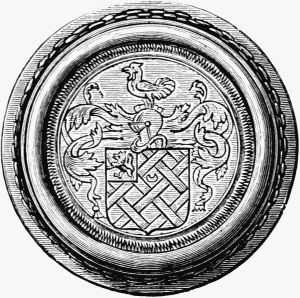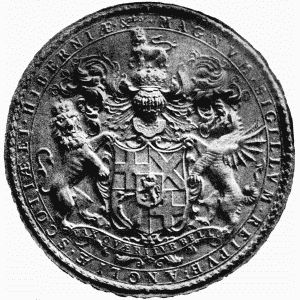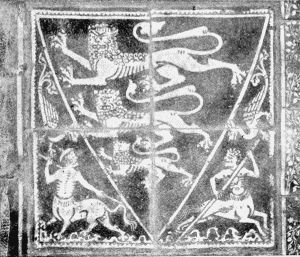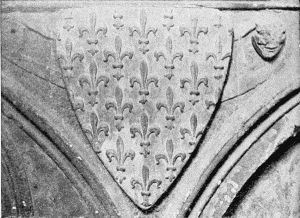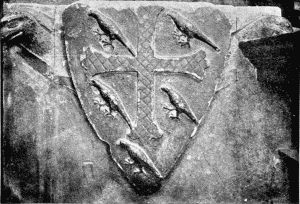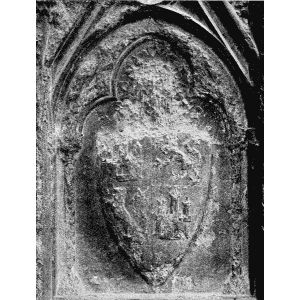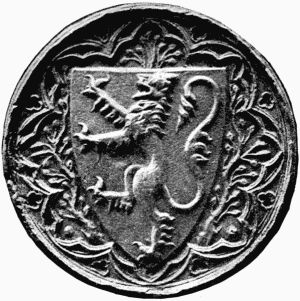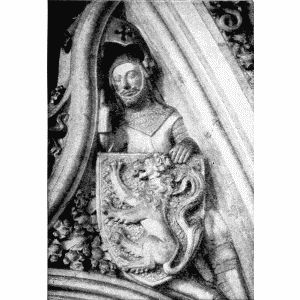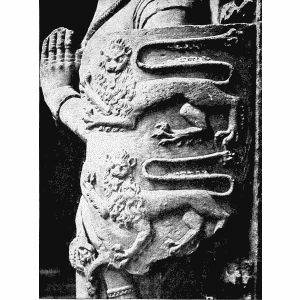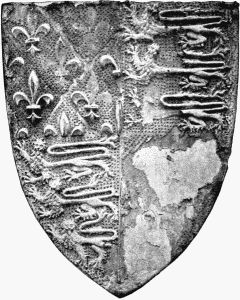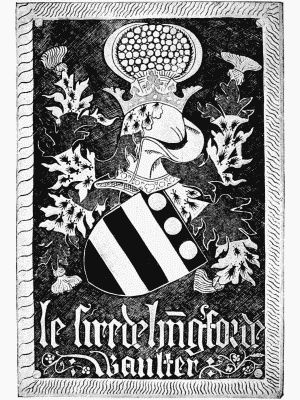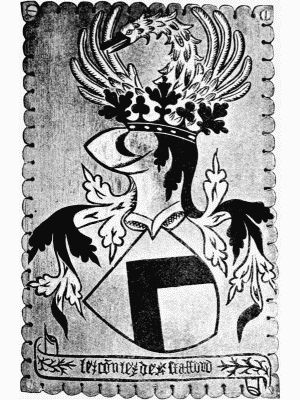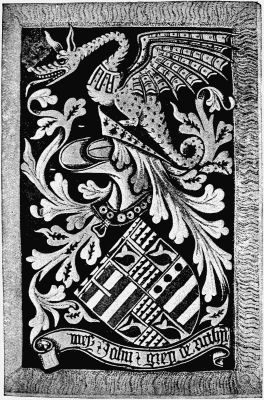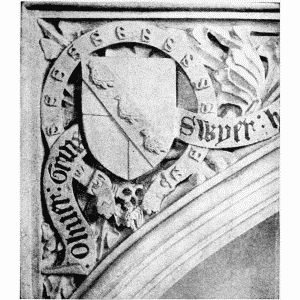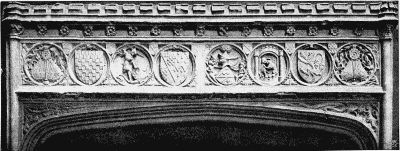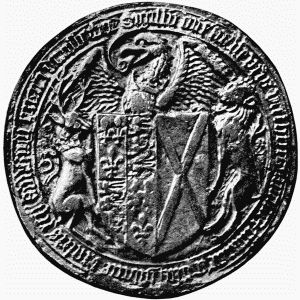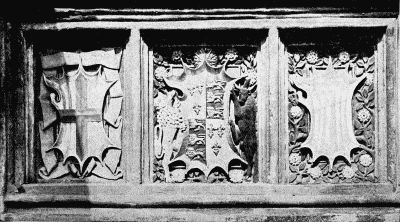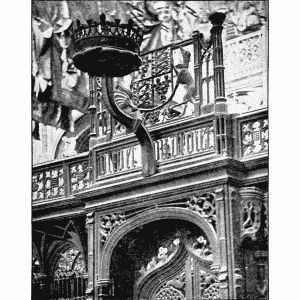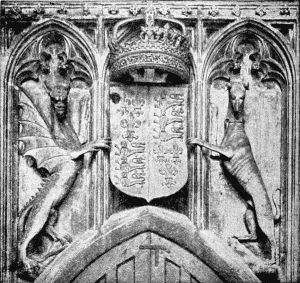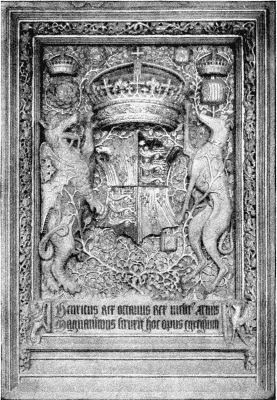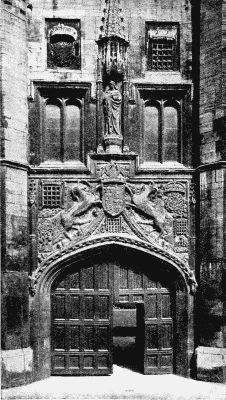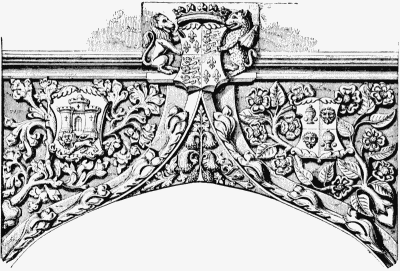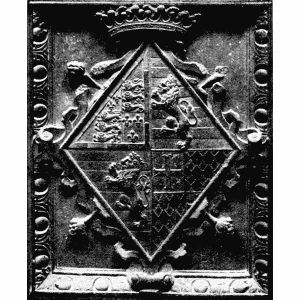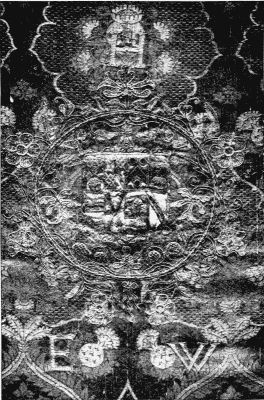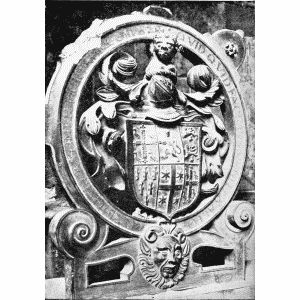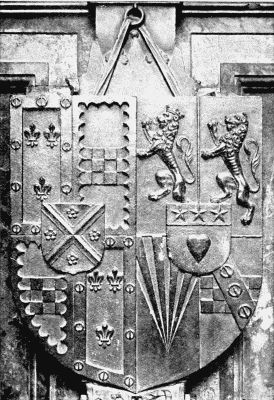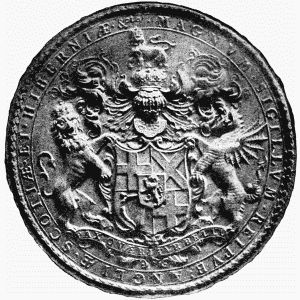.
THE ARTISTIC CRAFTS SERIES
OF TECHNICAL HANDBOOKS
EDITED BY W. R. LETHABY
HERALDRY
HERALDRY FOR
CRAFTSMEN & DESIGNERS
BY W. H. ST. JOHN HOPE
LITT.D., D.C.L., WITH DIAGRAMS
BY THE AUTHOR AND
NUMEROUS ILLUSTRATIONS
COLOURED LITHOGRAPHS
AND COLLOTYPE REPRODUCTIONS
FROM ANCIENT
EXAMPLES
PUBLISHED BY JOHN HOGG
13 PATERNOSTER ROW
LONDON 1913
Printed by Ballantyne & Company Ltd London
EDITOR'S PREFACE
In issuing this volume of a series of Handbooks on the Artistic Crafts, it will be well to state what are our general aims.
In the first place, we wish to provide trustworthy text-books of workshop practice, from the points of view of experts who have critically examined the methods current in the shops, and, putting aside vain survivals, are prepared to say what is good workmanship and to set up a standard of quality in the crafts which are more especially associated with design. Secondly, in doing this, we hope to treat design itself as an essential part of good workmanship. During the last century most of the arts, save painting and sculpture of an academic kind, were little considered, and there was a tendency to look on 'design' as a mere matter of appearance. Such 'ornamentation' as there was was usually obtained by following in a mechanical way a drawing provided by an artist who often knew little of the technical processes involved in production. With the critical attention given to the crafts by Ruskin and Morris, it came to be seen that it was impossible to detach design from craft in this way, and that, in the widest sense, true design is an inseparable element of good quality, involving as it does the selection of good and suitable material, contrivance for special purpose, expert workmanship,[Pg 8] proper finish and so on, far more than mere ornament, and, indeed, that ornamentation itself was rather an exuberance of fine workmanship than a matter of merely abstract lines. Workmanship when separated by too wide a gulf from fresh thought—that is, from design—inevitably decays, and, on the other hand, ornamentation, divorced from workmanship, is necessarily unreal, and quickly falls into affectation. Proper ornamentation may be defined as a language addressed to the eye; it is pleasant thought expressed in the speech of the tool.
In the third place, we would have this series put artistic craftsmanship before people as furnishing reasonable occupations for those who would gain a livelihood. Although within the bounds of academic art the competition, of its kind, is so acute that only a very few per cent. can fairly hope to succeed as painters and sculptors, yet as artistic craftsmen there is some probability that nearly every one who would pass through a sufficient period of apprenticeship to workmanship and design would reach a measure of success.
In the blending of handwork and thought in such arts as we propose to deal with, happy careers may be found as far removed from the dreary routine of hack labour as from the terrible uncertainty of academic art. It is desirable in every way that men of good education should be brought back into the productive crafts: there are more than enough of us 'in the City,' and it is probable that more consideration will be given in this century than in the last to Design and Workmanship.
Designers have at times to deal with some matters which are almost common to all the arts, matters which they either know or do not know, and in which the genius they are apt to trust in goes for little apart from knowledge. They must learn lettering for inscriptions much like they once learnt the multiplication table, and they should learn the elements of heraldry in the same way. This it has been difficult to do, as most of the books on heraldry, in seeking to be complete, so effectually muddle up the few important points with the vast number of things unimportant, or worse, that the art student is likely to give it up in despair. Many books on heraldry, which in itself is surely a gay thing, have been made to resemble grammars and dictionaries of a meaningless jargon.
Any student, however, who has become interested in a single shield, or in the look of the thing as seen in a collection of fine examples of heraldry such as are illustrated in this volume, should be able to master the main principles in an hour or two. The curious terms are only old-fashioned; they are used, so far as they are necessary, not of malice, but because it is of the essence of heraldry that everything shall be so strictly defined that a few words may represent a shield of arms as surely as a picture. Hence everything has a name, everything is clear, sharp, and bright, the colours are few, the forms must be large and simple. Even the seemingly arbitrary dictum that 'no colour must be put on colour or metal on metal' may probably have arisen from the fact that when gilding or silvering was used on a shield it would form a perfect foil for[Pg 10] colours, but as they reflected light in the same way, they could not be distinguished if used one on the other. Even yellow pigment on white would not tell clearly at any distance; the maxim is merely a rule for the sake of distinctness. Again, the curious vigorous drawing of beasts and birds with the eyes staring and the feet spread out was not the result of a desire to be quaint, but arose naturally from the same need of being clear. A good naturalistic drawing of a lion would be useless on a flag. Granted the special needs of heraldry, it developed in a perfectly understandable way.
On the question of heraldic drawing I should like to caution the student against thinking that it is so easy as it looks. Elementary and exaggerated, it may seem as if any child might do it, but in truth it is terribly difficult. The old shields were designed by experts with great experience; they placed the charge perfectly on the field and so distributed the parts that they were balanced in 'weight'; there were no weak lines and nothing was crowded for lack of room. Much practice made them perfect, and perfection is still difficult.
The present volume seems to me exactly what artists have wanted.
W. R. LETHABY
March 1913
AUTHOR'S PREFACE
This book is an attempt to place before designers and craftsmen such an account of the principles of the art of Heraldry as will enable them to work out for themselves the many and various applications of it that are possible to-day.
To that end the different usages which have prevailed from time to time are dealt with in detail, and are illustrated as far as may be from ancient sources.
Should it be thought that undue stress has been laid upon the pre-Tudor heraldry, to the comparative exclusion of that of later times, it may be pointed out that until the principles of the earlier heraldry have been grasped and appreciated, it is impossible to get rid of the cast-iron uniformity and stupid rules that bound the heraldry of to-day, and tend to strangle all attempts to raise it to a higher level.
To what extent these chilling ideas prevail, and how necessary it is to get rid of them, cannot better be illustrated than by two letters written to the author, after most of the following chapters were in type, by a critical friend who has not read any of them.
He points out in his first letter that on the very day of his writing there had been brought to his[Pg 12] notice, not for the first time, the great need that exists for a book in which sculptors and painters may find out what they legitimately may and what they may not do as regards heraldry. What, for example, may be left out from an achievement of arms, and how the different elements composing it may be varied, or even rearranged.
He instances the case of a sculptor who had been supplied with a drawing, 'brilliant in emerald green and powder blue,' of the arms that had been granted to a famous Englishman whose memory was about to be honoured by the setting up of a statue with his arms, etc. carved upon the pedestal.
The arms in the drawing did not present any difficulties, but the crest was not shown upon the helm, and the whole was surrounded by a series of trophies which to this unenlightened sculptor were as heraldic as the arms and crest. Out of all this, asked the sculptor, what could lawfully be omitted? If any of the trophies were supporters, must they be shown? And must the crest be used? Ought the crest to be on a helm? And should the helm be shown in profile or full-faced?
The contents of the drawing, if all were sculptured, would, in my friend's opinion, 'either come so small as to be unmonumental, or so large as to dwarf the statue into a doll.'
It will be seen from the principles enunciated in the present work that the answers to the foregoing questions were obviously as follows:
I. That the sculptor might use the arms alone if he thought fit, and he might vary the shape and size of the shield according to his fancy.
II. That he could omit the crest if he wished, but if he elected to use it, the crest ought certainly to be set upon a helm, which should face the same way as the crest; the crested helm might also be flourished about with such mantling as the sculptor thought proper.
III. That in the particular drawing none of the trophies was heraldic. The sculptor accordingly could omit the whole, if he were so minded, or could dispose about the arms and crested helm any such other trophies of like character as would in his judgment look well or be appropriate.
In a further letter my friend enumerates other difficulties that vex poor artists. Must a shield always be surmounted by a crested helm? Should the helm face any special way according to the degree of the bearer thereof? What are the ordinary relative proportions which helm and crest should bear to the shield? May a shield be set aslant as well as upright? Should a torse be drawn with a curved or a straight line? Is it necessary to represent the engraved dots and lines indicative of the tinctures? What are supporters to stand upon? Are they to plant their feet on a ribbon or scroll, or on a flowering mound, or what? May arms entitled to have supporters be represented without them? What are the simplest elements to which a shield of arms may be reduced?—as, for example, in a panel some 60 or 70 feet above the eye, and when but a small space is available.
To a craftsman or designer who has grasped the principles of heraldry these further questions will present no difficulty, and most of them can be[Pg 14] answered by that appeal to medieval usage which the nature of the illustrations renders possible.
These illustrations, it will be seen, are largely selected from heraldic seals, and for the particular reason that seals illustrate so admirably and in a small compass such a number of those usages to which appeal may confidently be made. Examples of heraldry in conjunction with buildings, monuments, and architectural features generally, have also been given, and its application to the minor arts has not been overlooked.
In order, too, to enable full advantage to be taken of the long period covered by the illustrations, the most typical of these have been collected into a chronological series at the end of the book. It is thus possible to show the gradual rise and decline of heraldic art from the thirteenth to the seventeenth century, beyond which it is hardly necessary to go.
The only modern illustrations that have been tolerated are those showing the formation of the Union Jack, and the degraded condition of the so-called Royal Standard. The coloured frontispiece is an attempt to show a more effective way of displaying with equal heraldic 'correctness' the arms of our Sovereign Lord King George the Fifth.
W. H. ST. JOHN HOPE
My thanks are due to the Society of Antiquaries of London for leave to reproduce the coloured illustrations in pls. I and II, for the loan of blocks or drawings of figs. 7, 13, 33, 64, 65, 101, 129, 153, 186, 187, 190, and 193, and for leave to photograph the[Pg 15] numerous casts of seals figured in pls. V-XIV and XVII-XXX and throughout the book; to the Royal Archæological Institute for loan of figs. 20 and 107; to the Sussex Archæological Society for the loan of fig. 142; to the Society of Arts for figs. 6, 15, 17, 28, 30, 41, 45, 46, 48, 51, 55, 73, 74, 86, 92, 114, 126, 127, 150, 154, 155, and 199; to the Royal Institute of British Architects for figs. 8, 93, and 199; to Messrs. Cassell & Co. for figs. 21, 53, 54, 56, 63, 81, 84, 85, 91, 108, 109, 117, 118, 124, 132, 133, 139, 151; to Messrs. Constable & Co. for figs. 9, 14, 43, 67, 68, 72, 75, 76, 77, 78, 83, 136, 137, 138; to Messrs. Parker & Co. for fig. 143; and to Messrs. Longmans & Co. for figs. 177, 183. Also to Mr. T. W. Rutter for lending the drawings reproduced in pls. II and III; to Mr. R. W. Paul for the drawing of fig. 184; to Mr. Mill Stephenson for the loan of the brass rubbings reproduced in figs. 19, 26, 27, 29, 31, 32, 35-39, 42, 146-148; to the Rev. T. W. Galpin, Mr. E. M. Beloe, and Mr. Aymer Vallance for the photographs of figs. 47, 149, and 191 respectively; and to the Rev. Severne Majendie for leave to photograph the effigies of the Duke and Duchess of Exeter (figs. 167, 168) in St. Katharine's chapel in Regent's Park.
I wish also to thank, among others, Mr. David Weller, head verger of Westminster Abbey, for leave to reproduce the photographs shown in figs. 1, 2, 4, 34, 40, 87, 104, 110, 134, 156, 176, 194, 195; Mr. T. W. Phillips, of Wells, for those forming figs. 23 and 111; Mr. Charles Goulding, of Beverley, for those forming figs. 49, 50; Mr. T. Palmer Clarke, of Cambridge, for those forming figs. 88, 96, 128, 170, 171, and 172; and Mr. Fred Spalding, of Chelmsford, for the photograph of the New Hall panel in fig. 189.
CONTENTS
| CHAP. | page | |
|---|---|---|
| I. | INTRODUCTION | 33 |
| Defects of Modern Heraldic Decoration; Appeal to First Principles; English versus Foreign Sources; Definition of Heraldry; Modes of Display; Colours and Furs; Formation of Arms; Divisions of the Shield; Early Authorities: Seals, Monuments, Buildings, Wills and Inventories, Rolls of Arms. | ||
| II. | THE SHIELD AND ITS TREATMENT | 65 |
| Early Forms of Shields; Later Forms; Shields of Irregular Outline and Surface; The Filling of a Shield; Apparent versus Absolute Uniformity; Modern Rules as to Proportion; The Use and Abuse of Quartering: its Origin and Growth; Differencing of Arms; The Scutcheon of Ulster; Diapering. | ||
| III. | THE SHIELD AND ITS TREATMENT (cont.) | 109 |
| Armorial Bearings of Ladies; Use of Lozenges and Roundels as variant forms of Shields; Arms of Men on Lozenges; Combinations of Shields with Lozenges and Roundels of Arms on Seals and in Embroideries. | ||
| IV. | THE TREATMENT OF CRESTS | 123 |
| Origin of Crests; Earliest examples of Crests; Ways of wearing Crests; The Helm and its treatment; Modern use of Helms; Absurd Crests; Use of Crests other than by individuals; The comparative sizes of Helms and Crests. | ||
| V. | MANTLINGS | 139 |
| Origin of Mantlings; Simple early forms; Colours of Mantlings; Medieval usage as to colours of Mantlings. | ||
| VI.[Pg 17] | CRESTS AND CROWNS, CAPS OF ESTATE, AND WREATHS | 148 |
| Crests within Crowns; Nature and Treatment of Crowns; Caps of Estate: Their possible origin and introduction into Heraldry; The colour of Caps; The placing of Crests upon Caps; Wreaths or Torses; Their Colour; Crests and Mottoes; Use of Crests by Bishops; The ensigning of Arms with Mitres, Cardinals' and Doctors' Hats, and Caps of Estate. | ||
| VII. | THE USE OF BADGES, KNOTS, AND THE REBUS | 165 |
| Definition of a Badge; Difference between Crests and Badges; Examples of Badges; The Ostrich-Feather Badge; The White Hart, etc.; Introduction of Badges into Heraldry; Their Prevalence; Allusive Badges; Badges of obscure Origin; Knots and Badges; The Rebus. | ||
| VIII. | SUPPORTERS | 193 |
| The probable Origin of Supporters; Quasi-Supporters; True Supporters: their Introduction; Supporters of Crested Helms; Pairs of Supporters; Dissimilar Supporters; The use of Supporters by Ladies; Other ways of Supporting Shields. | ||
| IX. | BANNERS OF ARMS | 219 |
| The Royal Banner of Arms; The Banner of the Arms of the City of London; Shapes of Banners; Sizes of certain Banners; Upright versus Long Banners; Advantages of the upright form; Banners with Achievements of Arms; Modern Use of Banners. | ||
| X. | MARSHALLING OF ARMS | 251 |
| Arms of husband and wife; Dimidiating; Impaling; Scutcheons of Pretence; Impalement with Official Arms; Arms of ladies; Heraldic Drawing; Mottoes; Use and Misuse of the Garter; Lettering and Mottoes. | ||
| XI. | CROWNS, CORONETS, AND COLLARS | 269 |
| Crowns and Coronets; Introduction of Coronets; Coronets of Princes, Dukes, and Earls; Bequests of Coronets; Illustrations of Coronets and Crowns; Collars and Chains; Collars of Orders; Lancastrian Collars of SS; Yorkist Collars of Suns and Roses;[Pg 18] Tudor Collars of SS; Other Livery Collars; Waits' Collars; Collars and Chains of Mayors, Mayoresses, and Sheriffs; The Revival of Collars; Inordinate Length of modern Collars. | ||
| XII. | HERALDIC EMBROIDERIES | 319 |
| The introduction of armorial insignia in embroidered Vestments: on Robes: on Beds, etc. | ||
| XIII. | TUDOR AND LATER HERALDRY | 331 |
| Decorative Heraldry of the Reign of Henry VIII; The Decadent Change in the Quality of Heraldry; Examples of Elaborated Arms; Survival of Tradition in Heraldic Art; Elizabethan Heraldry; Heraldry in the Seventeenth Century and Under the Commonwealth; Post-Restoration Heraldry. | ||
| CHRONOLOGICAL SERIES OF ILLUSTRATIONS | 354 | |
| INDEX | 411 | |
LIST OF ILLUSTRATIONS
PLATES
| PLATE | Facing page | ||
|---|---|---|---|
| Banner of the arms of King George the Fifth (Frontispiece) | Title | ||
| I. | Arms of Milton Abbey from a window in Ibberton church, Dorset, c. 1475. (From "Archæologia," vol. xlvii.) | 48 | |
| II. | } | Shields in stained glass of the 14th century in the Victoria and Albert Museum. (From coloured drawings by Mr. T. W. Rutter) | 54 |
| III. | 56 | ||
| IV. | Part (reduced) of an early Roll of Arms belonging to the Society of Antiquaries of London | 64 | |
| V. | Examples of shaped shields | 70 | |
| VI. | Various shapes of shields | 73 | |
| VII. | Examples of quartering | 89 | |
| VIII. | Examples of diapered shields | 104 | |
| IX. | Use of lozenges and roundels of arms | 112 | |
| X. | Use of lozenges and roundels of arms | 114 | |
| XI. | Early examples of crests | 123 | |
| XII. | Early uses of crests, on seals of William Montagu earl of Salisbury, 1337-44 | 125 | |
| XIII. | Various treatments of crests | 129 | |
| XIV. | Examples of crests and mantlings | 130 | |
| XV. | Stall-plate (reduced) of Hugh Stafford lord Bourchier, c. 1421 | 151 | |
| XVI. | Stall-plate (reduced) of William lord Willoughby, c. 1421 | 154 | |
| XVII. | Crests with mottoes | 161 | |
| XVIII.[Pg 20] | Examples of supporters | 188 | |
| XIX. | Origin of supporters | 193 | |
| XX. | Shields with supporters | 198 | |
| XXI. | Shields accompanied by badges | 199 | |
| XXII. | Quasi-supporter | 200 | |
| XXIII. | Shields accompanied by badges | 202 | |
| XXIV. | Shields accompanied by badges | 203 | |
| XXV. | Arms with crown and supporters of Elizabeth Wydville, queen of Edward IV | 208 | |
| XXVI. | Arms, supporters, and badges of the lady Margaret Beaufort, 1455 | 209 | |
| XXVII. | Methods of arranging shields | 214 | |
| XXVIII. | Examples of banners of arms | 216 | |
| XXIX. | Ways of upholding shields | 218 | |
| XXX. | Crowned shield with supporters and badges of the lady Margaret Beaufort, 1485 | 288 | |
| XXXI. | Right and wrong versions of the Union Jack | 248 | |
ILLUSTRATIONS IN TEXT
| FIG. | page | |
|---|---|---|
| 1. | Tile with the arms of King Henry III, c. 1255, from the chapter-house of Westminster abbey. (From a photograph by Mr. David Weller) | 36 |
| 2. | Shield of the arms of St. Edward, c. 1259, in the quire of Westminster abbey church. (From a photograph by Mr. David Weller) | 37 |
| 3. | Heraldry on the gatehouse of Kirkham priory, Yorkshire, built between 1289 and 1296. (From a photograph by Mr. C. C. Hodges) | 38 |
| 4. | Shield with curved bend or baston of Henry de Laci earl of Lincoln, c. 1259, in the quire of Westminster abbey church. (From a photograph by Mr. David Weller) | 44 |
| 5. | Arms of Clopton, from a brass c. 1420 at Long Melford in Suffolk | 46 |
| 6. | Heraldic candle-holder, etc. from the latten grate about the tomb of King Henry VII at Westminster. (From "Journal of the Society of Arts," vol. xlv. p. 238) | 55 |
| 7.[Pg 21] | Firedog with armorial bearings. (From a drawing by Mr. C. Prætorius, F.S.A.) | 56 |
| 8. | Chimney-piece in Tattershall castle, Lincolnshire, built by Ralph lord Cromwell between 1433 and 1455. (From "Journal of the Royal Institute of British Architects," 3rd S. vol. iv. 241) | 57 |
| 9. | Paving tiles with arms and badges of the Beauchamps, from Tewkesbury abbey church. (From "The Ancestor," vol. ix.) | 58 |
| 10. | Seal of Richard duke of Gloucester, as admiral of England in Dorset and Somerset (1462) | 59 |
| 11. | Heraldic buckle from the effigy of Robert lord Hungerford (ob. 1459) in Salisbury cathedral church. (From Stothard's "Monumental Effigies") | 60 |
| 12. | Heraldic buckle from the effigy of William lord Bardolf (ob. 1441) in Dennington church, Suffolk. (From Stothard's "Monumental Effigies") | 60 |
| 13. | Enamelled shield with the arms of Ballard on the print of a mazer at All Souls college, Oxford, c. 1445. (From "Archæologia," vol. l. 151) | 61 |
| 14. | Heraldic paving tiles from Tewkesbury abbey. (From "The Ancestor," vol. ix.) | 63 |
| 15. | Shield with rounded corners (c. 1259) of Richard earl of Cornwall in the quire of Westminster abbey church. (From "Journal of the Society of Arts," vol. xlv. 231) | 66 |
| 16. | Shields of English work from the tomb of William earl of Pembroke, ob. 1296, in Westminster abbey church. (From Stothard's "Monumental Effigies") | 67 |
| 17. | Seal of Hugh Bardolf showing shield with square corners. From the Barons' Letter. (From "Journal of the Society of Arts," vol. xlv. 228) | 68 |
| 18. | Seal and counterseal of Simon lord of Montagu, with shield supported by two bearded men and surmounted by the castle of Corfe, of which Simon became governor in 1298. From the Barons' Letter | 69 |
| 19. | Shield of ornate form, from a brass at Stoke Poges, Bucks, 1476 | 70 |
| 20. | Head of a doorway, now in Norwich Guildhall, with arms of King Henry VIII, the City of Norwich, and the Goldsmiths' Company. (From the Norwich volume of the Archæological Institute, p. 173) | 72 |
| 21. | Shield with engrailed edges, c. 1520, from the chantry chapel of abbot Thomas Ramryge in St. Albans abbey church. (From Boutell's "English Heraldry," No. 210) | 73 |
| 22.[Pg 22] | Shields with ridged charges, from the monument of Guy lord Bryen, ob. 1390, in Tewkesbury abbey church. (From Stothard's "Monumental Effigies") | 74 |
| 23. | Armorial panels from the George Inn at Glastonbury. (From a photograph by Mr. T. W. Phillips) | 75 |
| 24. | Shield with curved surface from an effigy of a Pembridge at Clehonger, Herefordshire. (From Stothard's "Monumental Effigies") | 76 |
| 25. | Shield from the seal of Henry Percy (from the Barons' Letter) with well-drawn lion | 77 |
| 26. | Shield with a leaping lion, from a brass c. 1380 at Felbrigge in Norfolk | 78 |
| 27. | Shield with an eagle from a brass at Great Tew, Oxon, c. 1410 | 79 |
| 28. | Seal of Queen's College, Oxford, 1341, with well-filled shields. (From "Journal of the Society of Arts," vol. xlv. 230) | 80 |
| 29. | Shield with a griffin, from a brass of 1405, at Boughton-under-Blean, Kent | 81 |
| 30. | Seal of Peter de Mauley IV (from the Barons' Letter) showing a simple well-balanced shield. (From "Journal of the Society of Arts," vol. xlv. 234) | 82 |
| 31. | Shield with a bend counter-flowered from the brass of Sir Thomas Bromfleet, 1430, at Wymington, Beds. | 82 |
| 32. | Shield with three lions, from a brass at Stanford Dingley, Berks, 1444 | 83 |
| 33. | Shield of the royal arms done in boiled leather, from the tomb of Edward prince of Wales at Canterbury, 1376. (Reduced from "Vetusta Monumenta," vol. vii.) | 84 |
| 34. | Shield of the King of France, c. 1259, in the quire of Westminster abbey church. (From a photograph by Mr. David Weller) | 85 |
| 35 and 36. | Shields with uncharged ordinaries: from the brass of bishop Robert Wyvil at Salisbury, 1375; and the brass of William Holyngbroke at New Romney in Kent, 1375 | 87 |
| 37. | Shield with a charged bend from a brass at Kidderminster, 1415 | 88 |
| 38 and 39. | Shields with engrailed borders, plain and charged: from the brass of William Grevel, 1401, at Chipping Campden in Gloucestershire; and the brass of Thomas Walysel, c. 1420, at Whitchurch, Oxon. | 90 |
| 40. | Quartered shield of Queen Eleanor of Castile, from her [Pg 23]tomb at Westminster, 1291. (From a photograph by Mr. David Weller) | 91 |
| 41. | Arms of King Edward III from his tomb at Westminster. (From "Journal of the Society of Arts," vol. xlv. 230) | 92 |
| 42. | Shield with impaled quarters from the brass of Peter Halle, ob. 1420, at Herne in Kent | 93 |
| 43. | Arms of St. Edward, from the tomb of Edmund duke of York, ob. 1402, at King's Langley. (From "The Ancestor," vol. ii.) | 94 |
| 44. | Seal of Humphrey Stafford earl of Buckingham, Hereford, Stafford, Northampton, and Perche, as captain of Calais and lieutenant of the Marches, 1442 | 95 |
| 45. | Shield of Sir Hugh Hastings from the Elsing brass (1347), with diapered maunch and a label of three pieces. (From "Journal of the Society of Arts," vol. xlv. 231) | 100 |
| 46. | Part of the gilt-latten effigy of Edward prince of Wales at Canterbury, showing labels over both the arms and the crest. (From "Journal of the Society of Arts," vol. xlv. 232) | 102 |
| 47. | Diapered shield of the arms of Vere, from an effigy in Hatfield Broadoak church, Essex. (From a photograph by the Rev. T. W. Galpin) | 104 |
| 48. | Diapered shield from the seal of Robert Waldby archbishop of York, 1390, for the Regality of Hexham. (From "Journal of the Society of Arts," vol. xlv. 231) | 105 |
| 49. | Diapered shield of the arms of Clun, from the monument of the lady Eleanor Percy (ob. 1337) in Beverley Minster. (From a photograph by Mr. C. Goulding) | 106 |
| 50. | Diapered shield of the arms of Percy, from the monument of the lady Eleanor Percy (ob. 1337) in Beverley Minster. (From a photograph by Mr. C. Goulding) | 107 |
| 51. | Lozenge of arms from the monument at Westminster of Frances Brandon duchess of Suffolk, ob. 1559. (From "Journal of the Society of Arts," vol. xlv. 229) | 110 |
| 52. | Seal of Robert FitzPain, with arms in an oval. From the Barons' Letter | 112 |
| 53. | Seal of Joan de Barre, wife of John de Warenne earl of Surrey, 1306. (From Boutell's "English Heraldry," No. 318) | 113 |
| 54. | Seal of Mary de Seynt-Pol, wife of Aymer of Valence earl of Pembroke, 1322. (From Boutell's "English Heraldry," No. 319) | 116 |
| 55. | Seal of Maud Badlesmere, wife of John de Vere earl of Oxford, 1336. (From "Journal of the Society of Arts," vol. xlv. 228) | 118 |
| 56. | Seal of Maud of Lancaster, wife of William of Burgh earl of[Pg 24] Ulster, and of Sir Ralph Ufford, 1343-4. (From Boutell's "English Heraldry," No. 320) | 119 |
| 57. | The Syon Cope, now in the Victoria and Albert Museum | 121 |
| 58. | Seal of Thomas de Moulton, with fan-shaped crest on helm and horse's head. From the Barons' Letter | 124 |
| 59. | Seal of Thomas earl of Lancaster, Leicester, and Ferrers, showing wiver crest on his helm and horse's head. From the Barons' Letter | 126 |
| 60. | Seal of Henry of Lancaster, lord of Monmouth, with wiver crest and quasi-supporters. From the Barons' Letter | 127 |
| 61. | Seal of Robert de la Warde, with fan crest. From the Barons' Letter | 128 |
| 62. | Seal of Walter de Mounci, with helm surmounted by a fox as a crest. From the Barons' Letter | 128 |
| 63. | Seal of Sir Robert de Marni, 1366, with crested helms flanking the shield. (From Boutell's "English Heraldry," No. 381) | 130 |
| 64. | Crest, etc. of Sir John Astley, from a MS. c. 1420. (From "Archæologia," vol. lvii.) | 131 |
| 65. | Crest of Edward prince of Wales, 1376, of leather and stamped gesso. (Reduced from "Vetusta Monumenta," vol. vii.) | 132 |
| 66. | Funeral helm and wooden crest of George Brooke lord Cobham, ob. 1558, in Cobham church, Kent | 133 |
| 67. | Stall-plate of Humphrey duke of Buckingham as earl of Stafford, c. 1429. (From "The Ancestor," vol. iii.) | 135 |
| 68. | Stall-plate of Sir Thomas Burgh, K.G., c. 1483. (From "The Ancestor," vol. iii.) | 136 |
| 69. | Seal of Richard Nevill with separate crests and supporters for his earldoms of Salisbury and Warwick | 137 |
| 70. | Seal of William lord Hastings, c. 1461 | 140 |
| 71. | Seal of William de la Pole earl of Suffolk, 1415 | 141 |
| 72. | Stall-plate of Ralph lord Bassett, showing simple form of mantling. (From "The Ancestor," vol. iii.) | 142 |
| 73. | Stall-plate of Sir Sanchet Dabrichecourt, K.G., c. 1421. (From "Journal of the Society of Arts," vol. xlv. 233) | 143 |
| 74. | Stall-plate of Sir William Arundel, K.G., c. 1421. (From "Journal of the Society of Arts," vol. xlv. 233) | 145 |
| 75. | Stall-plate of Richard Beauchamp earl of Warwick, after 1423. (From "The Ancestor," vol. iii.) | 146 |
| 76.[Pg 25] | Stall-plate of Richard Wydville lord Rivers, c. 1450. (From "The Ancestor," vol. iii.) | 147 |
| 77. | Stall-plate of Hugh lord Burnell, c. 1421. (From "The Ancestor," vol. iii.) | 149 |
| 78. | Arms of St. Edmund, from the tomb of Edmund duke of York, ob. 1402, at King's Langley. (From "The Ancestor," vol. ii.) | 150 |
| 79. | Crest from the stall-plate of Hugh Stafford lord Bourchier | 152 |
| 80. | Two forms of the same crest. From the stall-plate of Richard lord Grey of Codnor | 153 |
| 81. | Helm with crest and wreath from the Hastings brass at Elsing, 1347. (From Boutell's "English Heraldry," No. 385) | 157 |
| 82. | Helm with crest and torse and simple form of mantling, from the Harsick brass at Southacre, 1384 | 159 |
| 83. | Stall-plate of Sir Simon Felbrigge, c. 1421. (From "The Ancestor," vol. iii.) | 160 |
| 84. | Privy seal of Henry le Despenser bishop of Norwich, 1370-1406. (From Boutell's "English Heraldry," No. 351) | 162 |
| 85. | Shield with ostrich-feather badge from the tomb of Edward prince of Wales (ob. 1376) at Canterbury. (From Boutell's "English Heraldry," No. 401) | 167 |
| 86. | Seal of Thomas of Woodstock duke of Gloucester with ostrich-feather and Bohun swan badges. (From "Journal of the Society of Arts," vol. xlv. 240) | 168 |
| 87. | Fetterlock-and-falcon badge of the house of York, from Henry VII's chapel at Westminster. (From a photograph by Mr. David Weller) | 169 |
| 88. | Crowned rose and portcullis from King's college chapel at Cambridge. (From a photograph by Mr. J. Palmer Clarke) | 170 |
| 89. | Seal of Robert de Clifford, with arms surrounded by rings in allusion to his mother Isabel Vipont. (From the Barons' Letter) | 171 |
| 90. | Seal of Robert de Toni as CHEVALER AU CING with the arms encircled by swans and talbots. (From the Barons' Letter) | 171 |
| 91. | Seal of Oliver Bohun with swans about the shield. (From Boutell's "English Heraldry," No. 321) | 172 |
| 92. | Gilt-latten effigy at Westminster of King Richard II, pounced with badges, etc. (From "Journal of the Society of Arts," vol. xlv. 240) | 173 |
| 93. | Piers and arches in Wingfield church, Suffolk, with badges[Pg 26] of Michael de la Pole earl of Suffolk (ob. 1415) and his wife Katharine Stafford. (From a photograph by the Rev. W. Marshall in "Journal of the Royal Institute of British Architects," 3rd. S. vol. iv. 245) | 176 |
| 94. | Chimney-piece in the Bishop's Palace at Exeter with the arms and badges of bishop Peter Courtenay, 1478-87. (From a photograph by Heath and Bradnee) | 177 |
| 95. | Gateway to the Deanery at Peterborough. Built by Robert Kirkton, abbot 1497-1526. (From a photograph by Mr. A. Nicholls) | 178 |
| 96. | The gatehouse of Christ's College, Cambridge. (From a photograph by Mr. J. Palmer Clarke) | 179 |
| 97. | Bronze door with badges of York and Beaufort from the Lady chapel of Westminster abbey church. (From a photograph by Mr. Emery Walker, F.S.A.) | 180 |
| 98. | Signet with badge and crested helm of Lewis lord Bourchier, 1420 | 181 |
| 99. | Seal of Hugh de Vere with boar badge and two wivers as supporters. From the Barons' Letter | 181 |
| 100. | Signet of William lord Bardolf (c. 1410) with eagle badge derived from his arms | 182 |
| 101. | Signet with flote badge and word of Sir William Oldhalle in 1457. (From "Archæologia," vol. xxxvii. 337) | 182 |
| 102. | Seal with badge (a gray or badger) of Richard lord Grey of Codnor, 1392 | 183 |
| 103. | Seal of Thomas lord Stanley as earl of Derby and seneschal of Macclesfield, 1485, with the eagle's claw badge of Stanley and the legs of the Isle of Man | 183 |
| 104. | Daisy plant (marguerite) badge of the Lady Margaret Beaufort, from Henry VII's chapel at Westminster. (From a photograph by Mr. David Weller) | 184 |
| 105. | Part of the brass at Exeter of canon William Langeton, kinsman of Edward Stafford bishop of Exeter, 1413, in cope with an orphrey of X's and Stafford knots | 185 |
| 106. | Elbow-piece and Bourchier knot from the brass of Sir Humphrey Bourchier, ob. 1471, in Westminster abbey church | 186 |
| 107. | Alabaster tomb and effigy of Edward Stafford earl of Wiltshire, ob. 1498, in Lowick church, Northamptonshire. (From the "Archæological Journal," vol. lxi. 233) | 187 |
| 108. | Rebus of abbot Robert Kirkton from the Deanery Gate at Peterborough. (From Boutell's "English Heraldry," No. 295) | 188 |
| 109.[Pg 27] | Rebus of Thomas Beckington bishop of Bath and Wells, 1477. (From Boutell's "English Heraldry," No. 296) | 188 |
| 110. | Rebus of John Islip abbot of Westminster, from his chantry chapel. (From a photograph by Mr. David Weller) | 189 |
| 111. | Oriel window in the Deanery at Wells with badges of King Edward IV, and badges and rebuses of Dean Gunthorpe. (From a photograph by Mr. T. W. Phillips) | 190 |
| 112. | Arms and rebus of Sir John Pechy, ob. 1522, from painted glass in Lullingstone church, Kent. (From Stothard's "Monumental Effigies") | 191 |
| 113. | Seal of John de Moun slung from an eagle and flanked by two leopards. From the Barons' Letter | 195 |
| 114. | Seal of Alan la Souche in 1301. From the Barons' Letter. (From "Journal of the Society of Arts," vol. xlv. 228) | 196 |
| 115. | Seal of John Beauchamp of Hacche, with shield on breast of an eagle. From the Barons' Letter | 197 |
| 116. | Seal of William de Ferrers with shield upon an eagle with two heads. From the Barons' Letter | 197 |
| 117. | Seal of Edmund Mortimer earl of March and Ulster, 1400, with rampant leopard supporters. (From Boutell's "English Heraldry," No. 407) | 201 |
| 118. | Seal of Sir William Windsor, 1381, with eagle supporters. (From Boutell's "English Heraldry," No. 382) | 201 |
| 119. | Seal of William de la Pole duke of Suffolk, 1448 | 202 |
| 120. | Seal of John Nevill lord Montagu, 1461 | 203 |
| 121. | Seal of William lord Hastings, c. 1461 | 204 |
| 122. | Seal of John lord Talbot and Furnival, 1406 | 205 |
| 123. | Seal of George duke of Clarence and lord of Richmond, 1462, with black bulls of Clare supporting his crested helm | 207 |
| 124. | Seal of Richard Beauchamp earl of Warwick, 1401. (From Boutell's "English Heraldry," No. 448) | 208 |
| 125. | Seal of Richard Beauchamp earl of Warwick and of Albemarle and lord Despenser, 1421 | 209 |
| 126. | Seal of Edmund duke of Somerset for the town of Bayeux, c. 1445. (From "Journal of the Society of Arts," vol. xlv. 234) | 210 |
| 127. | Seal of Cecily Nevill, wife of Richard duke of York and mother of King Edward IV, 1461. (From "Journal of the Society of Arts," vol. xlv. 235) | 212 |
| 128. | Arms and supporters, a dragon and a greyhound, of King [Pg 28]Henry VII in King's College chapel at Cambridge. (From a photograph by Mr. J. Palmer Clarke) | 213 |
| 129. | Seal of the Mayoralty of Calais. (From "Archæologia," vol. liii. 327) | 215 |
| 130. | Seal of Walter lord Hungerford with banners of Heytesbury and Hussey or Homet, c. 1420 | 216 |
| 131. | Knights with banners, from an illumination | 220 |
| 132. | Seal of Walter lord Hungerford with banners. (From Boutell's "English Heraldry," No. 391) | 221 |
| 133. | Part of the seal of Margaret lady Hungerford, with impaled banner held up by a lion. (From Boutell's "English Heraldry," No. 406) | 222 |
| 134. | Tomb of Lewis Robsart lord Bourchier, K.G. ob. 1431, in Westminster abbey church, with banners of arms upheld by supporters. (From a photograph by Mr. David Weller) | 223 |
| 135. | The King's banner or "royal standard" as now borne | 227 |
| 136. | Stall-plate, as a banner, of Walter lord Hungerford, after 1426. (From "The Ancestor," vol. iii.) | 230 |
| 137. | Stall-plate, as a banner, of Richard Nevill earl of Salisbury, c. 1436. (From "The Ancestor," vol. iii.) | 231 |
| 138. | Stall-plate, as a banner, of Sir John Grey of Ruthin, c. 1439. (From "The Ancestor," vol. iii.) | 232 |
| 139. | Standard of Sir Henry Stafford, K.G. c. 1475. (From Boutell's "English Heraldry" No. 415) | 234 |
| 140. | Knights with pennons, from an illumination | 236 |
| 141. | Armed Knights carrying pennons, from an illumination | 237 |
| 142. | Armorial vane on Etchingham church, Sussex. (From "Sussex Archæological Collections," vol. ix. 349) | 240 |
| 143. | Vane formerly upon the finial of the kitchen roof, Stanton Harcourt, Oxon. (From "A Glossary of ... Gothic Architecture," vol. i. 505) | 241 |
| 144. | Part of King Henry VIII's garden at Hampton Court, from a contemporary picture. | 246 |
| 145. | Part of King Henry VIII's garden at Hampton Court, from a contemporary picture. | 247 |
| 146. | Shield of Bryen impaling Bures, from a brass in Acton church, Suffolk | 252 |
| 147. | Lion with a forked tail, from a brass at Spilsby in Lincolnshire, 1391 | 255 |
| 148. | Shield with three pheasants, from a brass at Checkendon, Oxon, 1404 | 256 |
| 149.[Pg 29] | Shield of the arms of Sir Humphrey Littlebury, from his effigy at Holbeach in Lincolnshire, c. 1360, with fine examples of heraldic leopards. (From a photograph by Mr. E. M. Beloe, F.S.A.) | 257 |
| 150. | Early and modern versions of ermine-tails. (From "Journal of the Society of Arts," vol. xlv. 236) | 258 |
| 151. | Early and modern versions of vair. (From Boutell's "English Heraldry," Nos. 61, 62) | 258 |
| 152. | The Garter, from the brass of Thomas lord Camoys, K.G. at Trotton in Sussex | 261 |
| 153. | Pewter medallion with Edward prince of Wales, now in the British Museum. (From "Archæologia," vol. xxxi. 141) | 262 |
| 154. | Shield of arms encircled by the Garter, from the brass of Thomas lord Camoys, ob. 1419. (From "Journal of the Society of Arts," vol. xlv. 237) | 264 |
| 155. | Shields encircled by the Garter and a scroll, from the brass of bishop Hallam (ob. 1416) at Constance. (From "Journal of the Society of Arts," vol. xlv. 237) | 265 |
| 156. | Royal arms of King Henry VII within the Garter, of English work, from the King's tomb by Torregiano at Westminster. (From a photograph by Mr. David Weller) | 266 |
| 157. | Arms of St. George within the Garter, from the brass of Sir Thomas Bullen, K.G. earl of Wiltshire and Ormond, 1538, at Hever in Kent | 267 |
| 158. | Crowned effigy of Queen Eleanor at Westminster | 270 |
| 159. | Crowned effigy of Queen Joan at Canterbury | 271 |
| 160.[Pg 30] | Helm and crest, and bust, of Richard Beauchamp earl of Warwick, ob. 1439, from his gilt-latten effigy at Warwick. (From Stothard's "Monumental Effigies") | 274 |
| 161. | Effigy of a lady, c. 1250, in Scarcliffe church, Derbyshire. (From Stothard's "Monumental Effigies") | 275 |
| 162. | Effigy of a lady in Staindrop church, Durham. (From Stothard's "Monumental Effigies") | 276 |
| 163. | Thomas earl of Arundel, ob. 1416, from his alabaster effigy at Arundel. (From Stothard's "Monumental Effigies") | 277 |
| 164. | Joan Beaufort countess of Westmorland, ob. 1440, from her alabaster effigy in Staindrop church, Durham. (From Stothard's "Monumental Effigies") | 278 |
| 165. | William FitzAlan earl of Arundel (ob. 1487) from his effigy at Arundel. (From Stothard's "Monumental Effigies") | 279 |
| 166. | Joan countess of Arundel, from her effigy at Arundel. (From Stothard's "Monumental Effigies") | 280 |
| 167. | John Holand duke of Exeter, ob. 1447, from his effigy at St. Katharine's hospital, Regent's Park | 282 |
| 168. | Head of a duchess of Exeter, from the monument at St. Katharine's hospital, Regent's Park | 283 |
| 169. | Alice duchess of Suffolk, ob. 1475, from her alabaster effigy in Ewelme church, Oxon. (From Hollis's "Monumental Effigies") | 284 |
| 170. | Armorial ensigns and badges of the lady Margaret Beaufort from the gatehouse of her foundation of Christ's college, Cambridge. (From a photograph by Mr. J. Palmer Clarke) | 286 |
| 171. | Arms of the foundress, the lady Margaret Beaufort, with yale supporters, from the base of an oriel in Christ's college, Cambridge. (From a photograph by Mr. J. Palmer Clarke) | 287 |
| 172. | Armorial panel on the gatehouse of St. John's college, Cambridge. (From a photograph by Mr. J. Palmer Clarke) | 289 |
| 173. | King Henry IV from his alabaster effigy in Canterbury cathedral church. (From Stothard's "Monumental Effigies") | 291 |
| 174. | King Henry III from his gilt-latten effigy at Westminster | 292 |
| 175. | King Edward II from his alabaster effigy at Gloucester. (From Stothard's "Monumental Effigies") | 293 |
| 176. | Crowned initials of King Henry VII from his Lady chapel at Westminster. (From a photograph by Mr. David Weller) | 294 |
| 177. | Thomas Howard third duke of Norfolk (1473?-1554) with the collar of the Order of the Garter, from the picture by Holbein at Windsor Castle. (From Gardiner's "Student's History of England," p. 410) | 295 |
| 178. | Collars of SS | 296 |
| 179. | Collar of SS from the effigy of William lord Bardolf, ob. 1441, at Dennington in Suffolk. (From Stothard's "Monumental Effigies") | 297 |
| 180. | Spandrel of the tomb of Oliver Groos, esquire (ob. 1439), in Sloley church, Norfolk, with collar of SS | 301 |
| 181. | Collars of SS from the effigy of Queen Joan at Canterbury, and of Robert lord Hungerford at Salisbury. (From Stothard's "Monumental Effigies") | 303 |
| 182. | Collars of suns and roses from the effigy of a knight at [Pg 31]Aston, Warwickshire, and the effigy of Sir Robert Harcourt, K.G. 1471 at Stanton Harcourt, Oxon. (From Hollis's "Monumental Effigies") | 305 |
| 183. | Sir Thomas More wearing the collar of SS: from an original portrait painted by Holbein in 1527, belonging to the late Mr. Edward Huth. (From Gardiner's "Student's History of England," p. 387) | 307 |
| 184. | Head of the effigy in Ripon Minster of Sir Thomas Markenfield with livery collar of park-palings. (From a drawing by Mr. Roland Paul, F.S.A.) | 310 |
| 185. | Thomas lord Berkeley (ob. 1417) with a collar of mermaids, from his brass at Wotton-under-Edge, Gloucestershire. (From Hollis's "Monumental Effigies") | 311 |
| 186. | Silver badge belonging to the duke of Northumberland. (From a drawing by Mr. C. Prætorius, F.S.A.) | 312 |
| 187. | Waits' Collars of Exeter, King's Lynn, and Norwich | 314 |
| 188. | Part of an embroidered altar frontal with a rebus at Baunton in Gloucestershire. (From a photograph by Mr. G. Clinch) | 320 |
| 189. | Carved panel with the crowned arms, supporters, and badges of King Henry VIII at New Hall in Essex. (From a photograph by Mr. Fred Spalding) | 333 |
| 190. | Paving tile with arms and initials of John Lyte (c. 1535), from Marten church, Wilts. (From a drawing by Mr. C. Prætorius, F.S.A.) | 334 |
| 191. | Arms with crested helm and badge (a blazing ragged-staff) of, apparently, Sir John Guldeford of Benenden, ob. 1565, in East Guldeford church, Sussex. (From a photograph by Mr. Aymer Vallance, M.A., F.S.A.) | 339 |
| 192. | Part of a bed-hanging embroidered with the arms of Henry and Elizabeth Wentworth, c. 1560, formerly in the possession of Sir A. W. Franks, K.C.B. | 342 |
| 193. | Arms of Cotes, from a mazer print of 1585-6. (From "Archæologia," vol. l. 174) | 343 |
| 194. | Shield from the tomb of Margaret countess of Lennox, ob. 1578, in Westminster abbey church. (From a photograph by Mr. David Weller) | 344 |
| 195. | Achievement of arms from the monument of Sir Richard Pecksall, ob. 1571, in Westminster abbey church. (From a photograph by Mr. David Weller) | 345 |
| 196.[Pg 32] | Obverse of the Great Seal of the Republic of England, Scotland, and Ireland, 1655 (reduced) | 348 |
| 197. | Arms, etc. of the Trinity House, London. From a wood-carving c. 1670 in the Victoria and Albert Museum | 349 |
| 198. | Limewood carving with the arms and crest of the Trevor family, c. 1700, in the Victoria and Albert Museum | 351 |
| 199. | Part of the carved oak ceiling of the chapel, formerly the hall, of Auckland castle, Durham, with the arms of bishop John Cosin. Date 1662-4. (From a photograph by Mr. H. Kilburn in "Journal of the Royal Institute of British Architects," 3rd S. vol. iv. 272) | 352 |
CHRONOLOGICAL SERIES OF ILLUSTRATIONS |
||
| pp. 354-407 | ||
CHAPTER I
INTRODUCTION
Defects of Modern Heraldic Decoration; Appeal to First Principles; English versus Foreign Sources; Definition of Heraldry; Modes of Display; Colours and Furs; Formation of Arms; Divisions of the Shield; Early Authorities: Seals, Monuments, Buildings, Wills and Inventories, Rolls of Arms.
To those who have given attention to the study of ancient heraldry few things are more surprising than the imperfect understanding of its true principles displayed in their works by so many artists and craftsmen of every degree. Year after year, in paintings and sculpture at the Royal Academy and other exhibitions, in the architecture and decorations of our churches and public buildings, on monuments, on plate, jewellery, and ornaments of all kinds, the attempt to introduce armorial accessories, even by some of our best artists, is almost always a failure.
In so recent a work as the national memorial to Queen Victoria before[Pg 34] Buckingham Palace, the shields for Scotland in the frieze of the pedestal bear the rampant lion only, and the distinctive double tressure is again omitted in the Scottish quarter of the royal arms behind the figure of Victory. The sides of the pedestal also bear fanciful shields of arms, in the one case with three lamps, in the other with some allegorical device, charged on bends sinister!
It is only fair to say that the fault appears to be not altogether that of the artist or craftsman, but should rather be ascribed to the disregard of the principles and usages of true armory that pervades so much of the printed literature to which men naturally turn for information.
He, however, who would know something about heraldic art must go behind the books to better sources of information, and rid himself once and for all of the modern cast-iron rules that cramp all attempts to improve matters. He will then soon find himself revelling in the delightful freedom and playful common-sense of medieval armory when it was still a living art, and a science too, utilized for artistic purposes by every class of worker and unencumbered by the ridiculous conceits of Tudor and later times.
The appeal, moreover, should largely be confined, if one would have what is best, to our own land. In the beginning heraldry was much the same in most European countries, but in course of time foreign armory became complicated by needless subdivisions and new methods of expression and combination. It would indeed be foolish to maintain that nothing can be learnt from foreign sources, but in the earlier stages of study English heraldry should come first. Not only is it characterized by a beautiful simplicity which continued practically unchanged until the beginning of the sixteenth century, but no other country outside England possesses such a wealth of examples of its various applications, and they lie immediately to hand for purposes of study and comparison. Moreover, English heraldry so fully illustrates the general principles followed in other countries that it is unnecessary at first to go further afield.
Heraldry, or armory as it was anciently called, is a symbolical and pictorial language of uncertain and disputed origin, which, by the beginning of the thirteenth century, had already been reduced to a science with a system, classification, and nomenclature[Pg 36] of its own. The artistic devices known as arms, which may be formed by proper combinations of the colours, ordinaries, and figures that represent the letters of this language, had each their significance, and soon came to be regarded as the hereditary possession of some person, family, dignity, or office.
The display of arms was restricted[Pg 37] primarily to shields and banners, but occasionally to horse-trappers (pls. XI B and XII B) and such garments as jupes, gowns, and mantles. Later on heraldry came also to be used ornamentally, either upon shields or without them, in all kinds of ways, in architecture and on monuments, on tiles and in glazing, in woodcarvings and in paintings, in woven stuffs and embroideries, in jewellery and on seals.

Fig. 2. Shield of the arms of St. Edward, c. 1259, in the quire of Westminster abbey church. An early instance of the use of heraldry in architecture.
The colours used in heraldry are red, blue, green, purple, and black, or, to[Pg 38] give them their old names, gules, azure, vert, purpure, and sable; combined with the yellow of gold and the whiteness of silver. Orange was never used, probably on account of the difficulty of finding a stable pigment. It was soon found that for brilliancy of effect the use of gold or silver with a colour was preferable to that[Pg 39] of colour with colour or metal with metal; two colours are therefore found together or superposed only under certain conditions, and the same applies to the two metals.
Imitations of two furs, ermine and vair, were also used: the one of white flecked with little black tails; the other of alternating oblong patches of white and blue, square at the top and rounded at the bottom, to represent grey squirrels' skins. (See figs. 151, 152.) If vair were coloured other than white and blue, the resultant was called vairy. There is also known a black fur with silver ermine-tails.
There were never any exact rules as to the particular tint of the colour employed, that being simply a matter of taste. Thus blue may range from a full indigo almost to Cambridge-blue, and red from a bright scarlet, through vermilion, to a dull brick colour, and so on; and it is surprising to find how well quiet colours blend together.
In the formation of arms the mere combinations of colours and metals produced by vertical, horizontal, or other divisions of the shield were soon exhausted, as were quarters, checkers, etc. There accordingly[Pg 40] grew quite naturally the further use of applied strips or bands based upon such divisions.
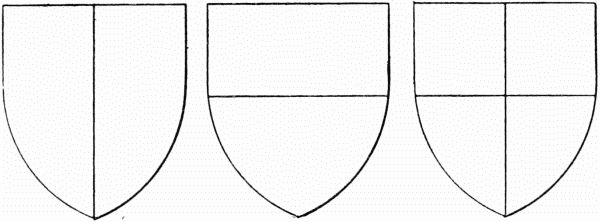
Party — Party-fessewise — Quarterly

Pale — Fesse — Cross
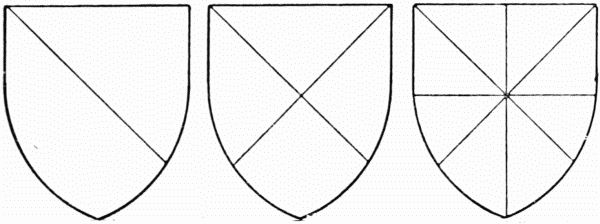
Party-bendwise — Party-saltirewise — Gyronny
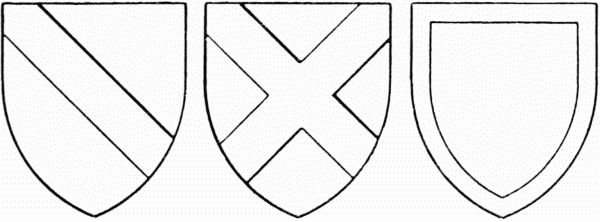
Bend — Saltire — Border

Chief — Quarter — Cheveron

Pile — Orle — Flanches
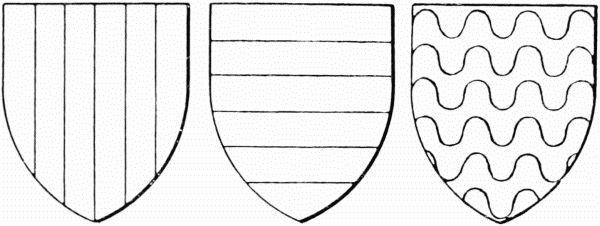
Paly — Barry — Wavy

Bendy — Checky — Lozengy
Thus the vertical parting of a metal and a colour known as party produced the pale, and a horizontal division the fesse or bar, and these combined to form the cross suggested by the quarterly lines. An oblique or slanting parting gave rise to the bend, and the crossing of two such produced the St. Andrew's cross or saltire. A combination[Pg 41] of the lines of a saltire with a quarterly division produced the varied field called gyronny. The border almost suggested itself. A cutting off of the upper half or head of the shield yielded the chief, and of a fourth part the quarter. One other of these applied pieces, or ordinaries as they were called, was the cheveron, formed of two strips issuing from the lower edges of the shield and meeting in a point in the middle, like the cheverons forming the roof[Pg 42] timbers of a house. Another ordinary was the pile, which was often threefold with lines converging towards the base as in fig. 72. Sometimes a shield was charged with one of smaller size called a scutcheon, and the middle of this was occasionally cut out to form a voided scutcheon or orle. Flanches, as they are called, are very rarely found; they are formed by drawing incurving lines within each side of the shield. An even series of pales yielded a vertical[Pg 43] striping called paly, and of piles, pily, while an even number of bars became barry. Undulated or waved bars formed wavy, and sometimes paly and pily stripes were also waved (fig. 19). In early examples the bend was often bended or curved. Bends are so represented in one of the shields in Westminster abbey (fig. 4), in some of the shields over the nave arcades in York minster, and on a number of monumental effigies. A narrower bend which overlaid[Pg 44] everything was known as a baston (see fig. 60). A number of narrow bends produced bendy, but the lines were then straight. A field divided into squares or checkers formed checky, and when divided into what are now called lozenges it became lozengy. Pales, fesses, crosses, saltires, borders, and cheverons sometimes had their edges engrailed by taking out of them, as it were, a continuous series of bites separated by sharp points, and the lower edge of a[Pg 45] chief or the inner margin of a border was often indented like the edge of a saw; but in early heraldry engrailing and indenting were interchangeable terms. An indented fesse was anciently called a daunce. Cheverons, fesses, bars, etc. were occasionally battled, through the upper line being formed into battlements. A fesse was often placed between two cheverons, as in the well-known arms of FitzWalter; or between two very narrow bars called cotises, or pairs of cotises called gemell bars. Cheverons, bends, and pales were also sometimes cotised. Cotises were often of a tincture different from that of the ordinary which they accompanied, and sometimes indented or dancetty as in the arms of Clopton (fig. 5) and Gonvile. The ground or field could be relieved by the use of vair or ermine, or by the addition of fretting or trellis-work or other simple means. It was also not unfrequently powdered with small crosses, fleurs-de-lis, or billets; often in conjunction with a larger charge like a cinqfoil or a lion.
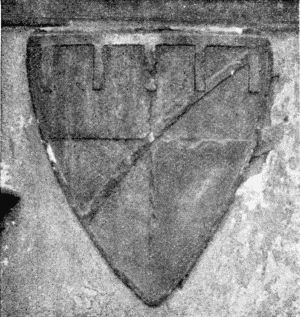
Fig. 4. Shield with curved bend or baston of Henry de Laci earl of Lincoln, c. 1259, in the quire of Westminster abbey church.
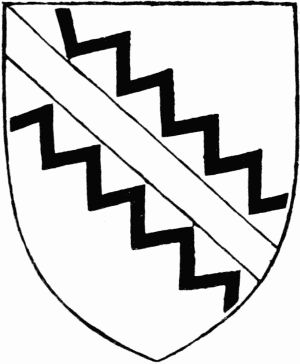
Fig. 5. Arms of Clopton, sable a bend silver and two cotises dancetty gold, from a brass c. 1420 at Long Melford in Suffolk.
Almost from the beginning every kind of device was charged or painted upon shields, either singly or in multiple, and upon or about such ordinaries as crosses,[Pg 46] cheverons, and fesses. Birds, beasts, and fishes, and parts of them like heads, or feet, or wings; flowers, fruits, and leaves; suns, moons or crescents, and stars; fleurs-de-lis, crosses, billets, roundels, rings, etc.—all were pressed into the service. The great rule as to colour held good as regards charges, and it was not permissible to paint a red rose upon blue or a gold star upon silver; but a red rose upon gold or a silver star upon blue was quite right.
It has however been lawful at all times to place an ordinary, such as a fesse or a[Pg 47] cheveron, and whether charged or not, upon a parti-coloured field like quarterly, checky, paly, or barry, or upon vair or vairy. A quarter, or a chief, or a border, without reference to its colour, can also be added to any such field.
Conversely, a parti-coloured cross, fesse, or charge of any kind is allowable upon a plain field.
In the Great Roll of arms, temp. Edward II, are instances of two shields, in the one case of a red lion, and in the other of a red fer-de-moline, on fields party gold and vert; also of a silver leopard upon a field party gold and gules, and of three red lions upon party gold and azure. Likewise of a shield with three lions ermine upon party azure and gules, and of another with wavy red bars upon a field party gold and silver.
In the arms, too, of Eton College granted by King Henry VI in 1448-9 three silver lilies on a black field are combined with a chief party azure and gules, with a gold leopard on the red half and a gold fleur-de-lis on the blue half. King Henry also granted in 1449 these arms, party cheveronwise gules and sable three gold keys, to Roger Keys, clerk, for his services[Pg 48] in connexion with the building of Eton College, and to his brother Thomas Keys and his descendants.
Shields with quarterly fields often had a single charge in the quarter, like the well-known molet of the Veres, or the eagle of Phelip.
Arms were sometimes counter-coloured, by interchanging the tinctures of the whole or parts of an ordinary or charge or charges overlying a parti-coloured field. This often has a very striking effect, as in the arms of St. Bartholomew's Hospital, which are party silver and sable a cheveron counter-coloured, or those of Geoffrey Chaucer, who bore party silver and gules a bend counter-coloured. Sir Robert Farnham bore quarterly silver and azure four crescents counter-coloured, or, as the Great Roll describes them, 'de l'un en l'autre.' The town of Southampton likewise bears for its arms gules a chief silver with three roses counter-coloured.
In drawing parti-coloured fields it is as well to consider what are the old rules with regard to them. In the early rolls a field barry of silver and azure, or of gold and sable, is often described as of six pieces, that is, with three coloured bars alternating with three of the metal, though barry[Pg 49] of eight and even ten pieces is found. Paly of six pieces is also a normal number. But the number of pieces must always be even, or the alternate pieces will become bars or pales. The number of squares in each line of a checkered field or ordinary is also another important matter. Six or eight form the usual basis for the division of a field, but the seven on the seal of the earl of Warenne and Surrey attached to the Barons' Letter of 1300-1 is not without its artistic advantages. On an ordinary, such as a fesse or cross, there should be at least two rows of checkers. Here, however, as in other cases, much depends upon the size of the shield, and a large one could obviously carry with advantage either on field or ordinary more squares than a small one without infringing any heraldic law.
Besides the plain cross familiar to most of us in the arms of St. George, and the similar form with engrailed edges, there is a variety known as the ragged cross, derived from two crossed pieces of a tree with lopped branches. This is often used in the so-called arms of Our Lord, showing the instruments of His Passion, or in compositions associated therewith, as in the[Pg 50] cross with the three crowned nails forming the arms of the town of Colchester.
Several other forms of cross have also been used. The most popular of these is that with splayed or spreading ends, often split into three divisions, called the cross paty, which appears in the arms of St. Edward (see figs. 2 and 43). It is practically the same as the cross called patonce, flory, or fleury, these being names applied to mere variations of drawing. The cross with les chefs flurettes of the Great Roll seems to have been one flowered, or with fleurs-de-lis, at the ends.
Another favourite cross was that with forked or split ends, formed of a fer-de-moline or mill-rind, sometimes called a cross fourchée, or, when the split ends were coiled, a cross recercelée. The arms of Antony Bek bishop of Durham (1284-1310) and patriarch of Jerusalem were gules a fer-de-moline ermine, and certain vestments 'woven with a cross of his arms which are called ferrum molendini' passed to his cathedral church at his death. On his seal of dignity the bishop is shown actually wearing such a vestment of his arms.
The tau or St. Anthony's cross also occurs in some late fifteenth century arms.
The small crosses with which the field of a shield was sometimes powdered were usually what are now called crosslets, but with rounded instead of the modern squared angles, as in the Beauchamp arms (fig. 14), and a field powdered with these was simply called crusily. But the powdering sometimes consisted of crosses paty, or formy as they were also styled, as in the arms of Berkeley, or of the cross with crutched ends called a cross potent, like that in the arms of the Kingdom of Jerusalem. These crosses often had a spiked foot, as if for fixing them in the ground, and were then further described as fitchy or crosses fixable.
Since the elucidation of the artistic rather than the scientific side of heraldry is the object of this present work, it is advisable to show how it may best be studied.
The artistic treatment of heraldry can only be taught imperfectly by means of books, and it is far better that the student should be his own teacher by consulting such good examples of heraldic art as may commonly be found nigh at hand. He may, however, first equip himself to advantage with a proper grasp of the subject by reading carefully the admirable article[Pg 52] on Heraldry, by Mr. Oswald Barron, in the new (eleventh) edition of the Encyclopædia Britannica.
The earliest and best of artistic authorities are heraldic seals. These came into common use towards the end of the twelfth century, much at the same time that armory itself became a thing of life, and they were constantly being engraved for men, and even for women, who bore and used arms, and for corporate bodies entitled to have seals.
Moreover, since every seal was produced under the direction of its owner and continually used by him, the heraldry displayed on seals has a personal interest of the greatest value, as showing not only what arms the owner bore, but how they were intended to be seen.
From seals may be learnt the different shapes of shields, and the times of their changes of fashion; the methods of depicting crests; the origin and use of supporters; the treatment of the 'words' and 'reasons' now called mottoes; the various ways of combining arms to indicate alliances, kinships, and official connexions; and the many other effective ways in which heraldry may be treated artistically without breaking the rigid rules of its scientific side.
Seals, unfortunately, owing to their inaccessibility, are not so generally available for purposes of study as some other authorities. They are consequently comparatively little known. Fine series, both of original impressions and casts, are on exhibition in the British and the Victoria and Albert Museums, and in not a few local museums also,[1] but the great collection in the British Museum is practically the only public one that can be utilized to any extent by the heraldic student, and then under the limitation of applying for each seal by a separate ticket.
The many examples of armorial seals illustrated in the present work will give the student a good idea of their importance and high artistic excellence.
Next to the heraldry on seals, that displayed on tombs and monuments, and in combination with architecture, may be studied, and, of course, with greater ease, since such a number of examples is available. Many a village church is comparatively as rich in heraldry as the abbey[Pg 54] churches of Westminster and St. Albans, or the minsters of Lincoln and York and Beverley.
It is to the country church, too, that we may often look for lovely examples of old heraldic glass, which has escaped the destruction of other subjects that were deemed more superstitious (pls. I, II, and III).

PLATE I. ARMS OF MILTON ABBEY FROM A WINDOW IN IBBERTON CHURCH DORSET, C. 1475 (FROM ARCHAEOLOGIA, VOL. XLVII.)

PLATE II. SHIELDS IN STAINED GLASS OF THE 14TH CENTURY WITH THE ARMS OF (1) JOHN, EARL OF KENT (2) JOHN OF GAUNT AS KING OF CASTILE, AND (3) SIR WILLIAM ARUNDEL, K.G.: IN THE VICTORIA AND ALBERT MUSEUM.
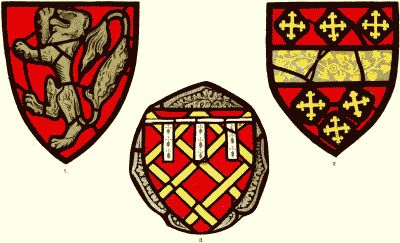
PLATE III. SHIELDS IN STAINED GLASS OF THE 14TH CENTURY WITH THE ARMS OF (1) MOWBRAY (2) BEAUCHAMP, AND (3) AUDLEY: IN THE VICTORIA AND ALBERT MUSEUM.
But the student is not restricted to ecclesiastical buildings in his search for good examples of heraldry.
Inasmuch as there never was such a thing as an ecclesiastical style, it was quite immaterial to the medieval master masons whether they were called in to build a church or a gatehouse, a castle or a mansion, a barn or a bridge. The master carpenter worked in the same way upon a rood loft or a pew end as upon the screen or the coffer in the house of the lord; the glazier filled alike with his coloured transparencies the bay of the hall, the window of the chapel, or that of the minster or the abbey; and the tiler sold his wares to sacrist, churchwarden, or squire alike.
The applications of heraldry to architecture are so numerous that it is not easy to deal with them in any degree of connexion.
Shields of arms, badges, crests, and[Pg 55] supporters are freely used in every conceivable way, and on every reasonable place: on gatehouses (figs. 3, 95, 96) and towers, on porches and doorways, in windows and[Pg 56] on walls, on plinths, buttresses, and pinnacles, on cornice, frieze, and parapet, on chimney-pieces (figs. 8, 94) and spandrels, on vaults and roofs, on woodwork, metalwork (figs. 6, 7), and furniture of all kinds, on tombs, fonts, pulpits, screens, and[Pg 57]
[Pg 58]
[Pg 59] coffers, in painting, in glass, and on the tiles of the floor (figs. 1, 9, 14).

Fig. 6. Heraldic candle-holder, etc. from the latten grate about the tomb of King Henry VII at Westminster.
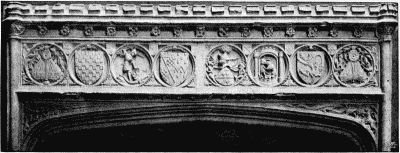
Fig. 8. Chimney-piece in Tattershall castle, Lincolnshire, built by Ralph lord Cromwell between 1433 and 1455, with shields of arms and treasurer's purse and motto'
Though actual examples are now rare, we know from pictures and monuments, and the tantalizing descriptions in inventories, to how large an extent heraldry was used in embroidery and woven work, on carpets and hangings, on copes and[Pg 60] frontals, on gowns, mantles, and jupes, on trappers and in banners, and even on the sails of ships (fig. 10).
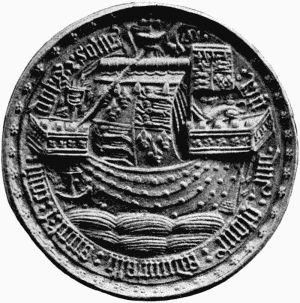
Fig. 10. Seal of Richard duke of Gloucester, as admiral of England in Dorset and Somerset (1462), with arms on the mainsail of the ship.
Wills and inventories also tell us that in jewellery and goldsmiths' work (see figs. 11 and 12) heraldry played a prominent part, and by the aid of enamel it appeared in its proper colours, an ad[Pg 61]vantage not always attainable otherwise (fig. 13). Beautiful examples of heraldic shields bright with enamel occur in the abbey church of Westminster on the tombs of King Edward III and of William of Valence, and on the tombs at Canterbury and Warwick respectively of Edward prince of Wales and Richard Beauchamp[Pg 62] earl of Warwick; while in St. George's chapel in Windsor castle there are actually nearly ninety enamelled stall-plates of Knights of the Garter of earlier date than Tudor times, extending from about 1390 to 1485, and forming in themselves a veritable heraldic storehouse of the highest artistic excellence. (See pls. XV, XVI.)
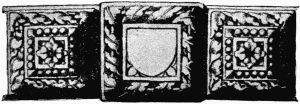
Fig. 11. Heraldic buckle from the effigy of Robert lord Hungerford (ob. 1459) in Salisbury cathedral church.

Fig. 12. Heraldic buckle from the effigy of William lord Bardolf (ob. 1441) in Dennington church, Suffolk.

Fig. 13. Enamelled shield with the arms of Ballard on the print of a mazer (c. 1445) at All Souls college, Oxford.
Another source of coloured heraldry is to be found in the so-called rolls of arms.
While heraldry was a living art, it obviously became necessary to keep some record of the numerous armorial bearings which were already in use, as well as of those that were constantly being invented. This seems to have been done by entering the arms on long rolls of parchment. In the earliest examples these took the form of rows of painted shields, with the owners' names written over (pl. IV); but in a few rare cases the blazon or written description of the arms is also given, while other rolls consist wholly of such descriptions, as in the well-known Great and Boroughbridge Rolls. These have a special value in supplying the terminology of the old heraldry, but this belongs to the science or grammar and not the art of it. The pictured rolls, on the other hand, clearly[Pg 63]
[Pg 64] belong to the artistic side, and as they date from the middle of the thirteenth century onwards, they show how the early heralds from time to time drew the arms they wished to record.
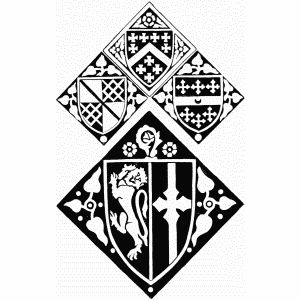
Fig. 14. Heraldic paving tiles from Tewkesbury abbey. The three uppermost bear the arms of Despenser, Berkeley, and Beauchamp, and the large one the arms of Robert FitzHamon, the founder, impaled with the singular cross of the abbey.

PLATE IV. PART (REDUCED) OF AN EARLY ROLL OF ARMS BELONGING TO THE SOCIETY OF ANTIQUARIES OF LONDON.
[1] It would surely not be a matter of much difficulty or expense to equip the leading schools of art in this country with sets of casts of these beautiful objects.
CHAPTER II
THE SHIELD AND ITS TREATMENT
Early Forms of Shields; Later Forms; Shields of Irregular Outline and Surface; The Filling of a Shield; Apparent versus Absolute Uniformity; Modern Rules as to Proportion; The Use and Abuse of Quartering: its Origin and Growth; Differencing of Arms; The Scutcheon of Ulster; Diapering.
From these preliminary remarks we may pass to the practical consideration of the principles of heraldic art.
And first as to shields and their treatment.
The form of a shield is in itself entirely arbitrary and void of meaning. Although it varied from time to time, this was simply a matter of fashion, like the shape of an arch or the pattern of a window. Such changes must not, however, be overlooked, for it would be absurd in actual practice to use an ornate shield of the style of the fifteenth or sixteenth century for a lion of (say) the thirteenth century type, or to fill a shield of early form with charges characteristic of a later date.
During the twelfth century shields were more or less kite-shaped, like those that were actually used, but in the thirteenth century they began to be shorter and straighter across the top. Good examples of this type may be found on seals. In the aisles behind the quire of Westminster abbey church, the beautiful shields in the spandrels of the wall arcade, of a date not later than 1259, retain their rounded upper corners. (See figs. 2 and 15.) The next[Pg 67] form, with the upper corners square (figs. 16, 17), came into vogue in the second half of the thirteenth century, and has continued always in use. Owing to the elastic way in which its curves can be slightly altered when required, it may safely be adopted in general practice. In the earliest examples the curves begin at the top, or just below, but later on they were so struck as to increase the area[Pg 68] of the lower part of the shield in order to make more room for the charges. In some fourteenth century instances the sides continue straight nearly to the bottom, so that the shield is practically an oblong with rounded lower corners, like the shields of the royal arms on our coinage to-day (fig. 18 and pl. VI A). A tendency in the same direction is not uncommon throughout the fifteenth century. About the middle of the same century the fashion began to prevail, alongside the other, of representing a man's arms on the same irregularly shaped shield that he was wont to carry in the jousts. This is as wide at the bottom as the top, with its outline worked into curves, and has on the dexter, or right-hand side as borne, a deep notch[Pg 69] for the lance to rest in during tilting; the top and bottom of the shield are often subdivided into three or more lobes or shallow[Pg 70] curves. Good examples occur on seals and monuments, and some of the Garter stall-plates. (See pls. V A and B; VI B; XVII; and XXIII A.) Shields of a more ornate form are occasionally to be met with, like an example (fig. 19) on a brass at Stoke Poges of the date 1476, with graceful leaf-work curling over at the top and bottom. Shields similarly ornamented occur on the door[Pg 71]way of a citizen's house now built into the Guildhall at Norwich (fig. 20).
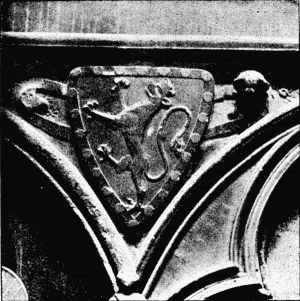
Fig. 15. Shield with rounded corners (c. 1259) of Richard earl of Cornwall in the quire of Westminster abbey church.

Fig. 16. Shields of English work from the tomb of William earl of Pembroke (ob. 1296) in Westminster abbey church.
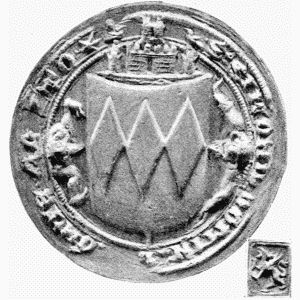
Fig. 18. Seal and counterseal of Simon lord of Montagu, with shield of unusual form supported by two bearded men and surmounted by the castle of Corfe, of which Simon became governor in 1298. The quadrangular signet displays a griffin. From the Barons' Letter.
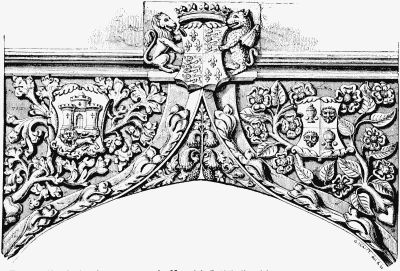
Fig. 20. Head of a doorway, now in Norwich Guildhall, with arms of King Henry VIII, the City of Norwich, and the Goldsmiths' Company.
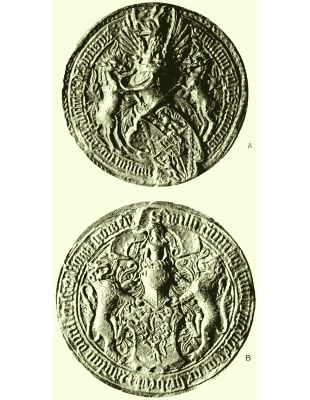
PLATE V.—Examples of shaped shields.
- A John Tiptoft earl of Worcester, 1449.
- B William Herbert earl of Huntingdon, 1479.
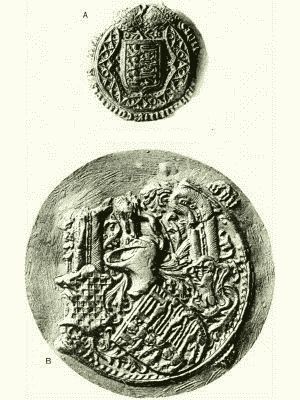
PLATE VI.—Various shapes of shields.
- A John earl of Kent 1351.
- B John Mowbray, duke of Norfolk and earl marshal, 1442.
In the simpler forms the field of a shield in painted representations is invariably shown flat; but in carvings, and occasionally on seals, a slight convexity, or even concavity, is often met with, the artistic advantages of which it is unnecessary to enlarge upon. In some of the later ornate forms, like those described above, the incurved or engrailed edge is accompanied by a field worked with a series of ridges and furrows (figs. 21 and 23). The effect of this may be good, but there is a danger of carrying it to excess and so injuring the appearance of the charges. If the shield be well covered by the bearings on it, it is generally better to use one of simple form than one with an irregular outline and ridged surface; but there is, of course, no reason why both forms should not be used concurrently in architectural or other works, as they sometimes were of old.

Fig. 21. Shield with engrailed edges (c. 1520), from the chantry chapel of abbot Thomas Ramryge in St. Albans abbey church.
The same principle as the ridging of a shield to relieve the plain surface was also applied to the ordinaries upon it. An early example may be seen upon the tomb of queen Eleanor at Westminster, which has the bends in the shields of Ponthieu ridged[Pg 72]
[Pg 73] along the middle line. The shield borne by Brian FitzAlan (ob. 1302) in his effigy at Bedale has the alternate bars of his arms (barry of eight pieces gold and gules) treated in the same way. Another instance may be seen on the effigy of Sir Richard Whatton (c. 1325) at Whatton, Notts, in which a bend, though charged, is ridged. The shields on the tomb of Guy lord Bryen (ob. 1390) at Tewkesbury (fig. 22) furnish typical later examples, while during the fifteenth and early sixteenth centuries instances are as common as the curved and[Pg 74] ridged shields described above, especially as regards crosses and saltires, as at St. Albans, the George Inn at Glastonbury (fig. 23), and elsewhere.
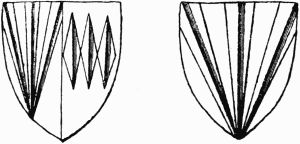
Fig. 22. Shields with ridged charges, from the monument of Guy lord Bryen (ob. 1390) in Tewkesbury abbey church.
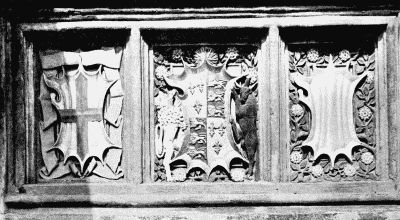
Fig. 23. Armorial panels, the middlemost with the arms, supporters, and badges of King Edward IV, from the George Inn at Glastonbury.
In monumental effigies the shield borne by a knight often has a convex or rounded surface (fig. 24), and in late fifteenth century and Tudor architecture otherwise flat shields sometimes have the middle swelled out, as on dean Gunthorpe's oriel at Wells, in a manner very popular in Renaissance work. (See figs. 111 and 195.)
A reference to a number of good ancient examples of heraldic shields or banners will disclose the care that has been taken to occupy the field, as far as possible, with whatever is placed upon it (figs. 25, 26, 27). A lion or an eagle, for instance, will[Pg 75]
[Pg 76] have the limbs and extremities so spread out as to fill every available space; and the same will be found in every group or combination of objects capable of arrangement or extension.
Even with most unpromising combinations, or a group that cannot be extended or[Pg 77] modified at all, or with a single charge like a fleur-de-lis, or ordinary such as a bend, (fig. 30), pale, or cheveron (pl. VIII A), a judicious adjustment of proportions, or some equally common-sense method, enabled a medieval artist to make his shield look well.
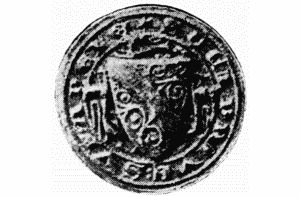
Fig. 30. Seal of Peter de Mauley IV (from the Barons' Letter), showing a simple well-balanced shield.
Another point that may be noticed in all old work is that in shields containing several similar objects no two are exactly[Pg 78] alike. If the charges be, for example, three roses or three roundels or three lions (fig. 32), two will be placed in the upper and the third in the lower part of the shield. But the latter will often be somewhat larger than the others, and these, in turn, will differ slightly the one from the other as they do in nature. So, too,[Pg 79] in a case like the three leopards of the King of England, whether displayed on shield or in banner, no two are exactly alike, but each differs somewhat from another in pose or in size (fig. 32). Even when the same charge is repeated many times, like the fleurs-de-lis in the old arms[Pg 80] of France, any possible chance of mechanical monotony is avoided by a trifling variation in the shape of each, as in the shield of the King of France in the early series at Westminster (fig. 34).
Another fact is that in the old work lines and curves are hardly ever quite true, but drawn by hand instead of with pen or compasses. The modern artist, on the contrary, usually draws his lines and curves with mechanical precision; his charges are exact copies one of another; the fact that they do not fill the field (pace the royal arms on the coinage) is to him quite unimportant, and the final result is that under no circumstances will his work look well.[Pg 81] Even in old stencilling a pleasing effect never seen in modern work of the kind was produced through a not too rigid adherence to a regularity of application.
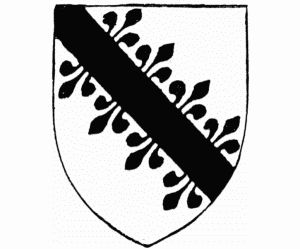
Fig. 31. Shield with a bend counter-flowered, from the brass of Sir Thomas Bromfleet (1430) at Wymington, Beds.
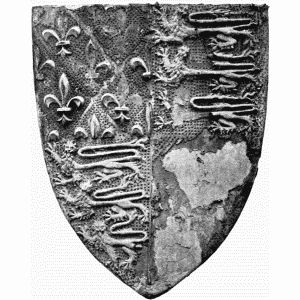
Fig. 33. Shield of the royal arms done in boiled leather, from the tomb of Edward prince of Wales at Canterbury, 1376.
Another cause of the bad effect of much modern heraldry is the unnecessary adherence to the rules laid down in some of the textbooks and manuals as to the relative[Pg 82] widths of ordinaries and subordinaries. The old heralds certainly did not fetter[Pg 83] themselves with such shackles. A cheveron, a bend, a fesse, or a cross was drawn of the best proportion to look well (figs. 35, 36). If charged it would be wider than when plain. If placed between charges it was drawn narrower, if itself uncharged, and thus took its proper relative position with regard to the size and arrangement or the charges. So, too, with a border; if uncharged or merely gobony (i.e. formed of short lengths of alternate colours) or[Pg 84]
[Pg 85] engrailed, it was drawn very narrow, and even if charged it was not allowed much greater width (figs. 38, 39). It thus never unduly encroached upon the field or other contents of the shield, and yet remained an artistic addition in itself. The curious bordering known as the tressure, which is almost peculiar to Scotland, and familiar to us through its occurrence in the shield of our Sovereign, is drawn sufficiently narrow in all good examples to leave[Pg 86] ample room for the ramping lion it fences in, and its frieze of fleurs-de-lis is formed of a good number of flowers, instead of the eight considered sufficient in the royal arms of to-day. Even a chief, if necessary, was enlarged from the 'less than one-third of the shield' of to-day to the one-half of it, or even more, as may be seen in some of the examples of the arms of the monastery in the abbey church of Westminster, or in those of the town of Southampton.

From the brass of William Holyngbroke at New Romney in Kent, 1375.
Figs. 35 and 36. Shields with uncharged ordinaries.
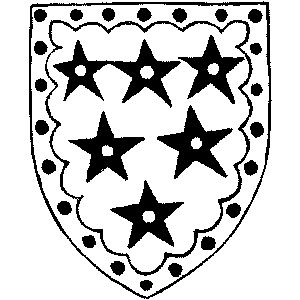
From the brass of Thomas Walysel (c. 1420) at Whitchurch, Oxon.
Figs. 38 and 39. Shields with engrailed borders, plain and charged.
Another feature of early heraldry which it is well to bear in mind is the sparing use of what is known as quartering, or the method of combining in one shield the arms of two or more persons or families. One of our oldest instances of this occurs on the tomb of Queen Eleanor, the first wife of King Edward I, at Westminster, and shows her paternal arms of Castile and Leon so arranged (fig. 40). Another early example occurs in the Great Roll, temp. Edward II, where the arms of Sir Simon Montagu (ob. c. 1316), silver a fesse indented gules of three indentures, are quartered with azure a gold griffin. So long as the shield contained only four quarters, with the first and fourth, and the second and third, respectively alike, the effect was often good, as in the cases just[Pg 87]
[Pg 88] noted, or in the beautiful arms of France and England combined used after 1340 by King Edward III (fig. 41). There are also many examples, as in the well-known bearings of the Veres and of the Despensers, where a quarterly disposition of the shield forms the basis of the arms. But when, as became common in the fifteenth century, quarters were multiplied or subdivided, the artistic[Pg 89] effect of the old simple shield was lost or destroyed. As the principle was further extended, especially in Tudor and Stewart times, the result became more and more confused in appearance, until the field resembled rather a piece of coloured patchwork than a combination of various arms all more or less beautiful in themselves.
The origin and growth of these combinations, which actually are perfectly lawful and proper, and yet often quite accidental, can easily be illustrated by a few typical examples.
In 1382 King Richard II, who used the same arms as his grandfather, a quarterly shield of Old France and England, married Anne of Bohemia, daughter of the Emperor Charles IV. As her shield was also a quartered one, the combined arms of the king and his queen, as shown upon her seal, formed a shield of eight quarters (pl. VII A). This was further complicated through the later assumption by King Richard of the arms assigned to St. Edward (fig. 43), a cross between five birds; and the eight-quartered shield with this clumsy addition at one side may be seen on the Felbrigge brass.
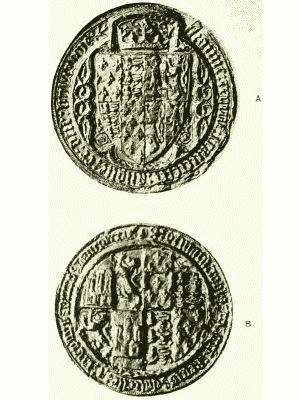
PLATE VII.—Examples of Quartering.
- A Queen Anne of Bohemia, 1382.
- B John of Gaunt's privy seal as King of Castile, 1372.
These arms of St. Edward were used for[Pg 90]
a time duly 'differenced' in conjunction with his own quarterly arms by Henry of[Pg 92] Lancaster, afterwards King Henry IV, and are impaled with those of his wife, Mary de Bohun, on his seal (1399) as duke of Hereford. Artistically the lop-sided effect so produced is quite unhappy.
Many fifteenth century shields show forth, by the simple quartering of a man's arms with those of his wife or his mother, his succession or summons as a lord of parliament, or his inheritance of great estates.
But this simplicity was gradually destroyed when the added quartering was itself quartered, as in the arms of Richard Nevill earl of Salisbury (see pls. XVII A and XXII B), or the quarterings were all different, as in the case of Humphrey Stafford duke[Pg 94] of Buckingham. When but a year old he succeeded his father as earl of Stafford, and on his mother's death he became earl of Buckingham, Hereford, Northampton, Essex, and Perche! These dignities are[Pg 95]
[Pg 96] duly displayed in the quarterings of his arms on his seal, as follows: 1. The quartered arms of his mother, for the earldom of Buckingham. 2. Bohun of Hereford. 3. Bohun of Northampton. 4. Stafford (fig. 44).
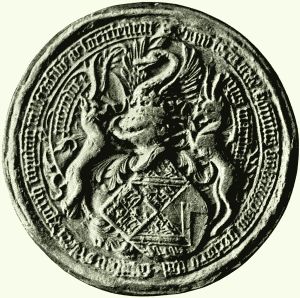
Fig. 44. Seal of Humphrey Stafford earl of Buckingham, Hereford, Stafford, Northampton, and Perche, as captain of Calais and lieutenant of the Marches, 1442.
When Henry duke of Buckingham succeeded in 1460 to all the dignities of duke Humphrey his grandfather, he wisely elected, by the advice of the kings-of-arms, to drop the above quarterings, and to use only the arms of his great-grandmother, who as sister and heir of Humphrey duke of Gloucester and earl of Buckingham bore France and England quarterly within a border silver.
About 1433 Margaret, daughter of Richard Beauchamp earl of Warwick, was married to John Talbot earl of Shrewsbury, and she thereupon had a beautiful seal engraved, with two large shields or arms hung side by side by their straps from a ragged staff, the badge of her father's house (pl. XXVII B). This charming composition is, however, quite spoilt through the complicated treatment of the shields. One of these bears the arms of husband and wife conjoined, the other those of the lady's father. The earl of Warwick's shield is a quartered one of[Pg 97] Beauchamp and Newburgh, with a small superimposed scutcheon. The earl of Shrewsbury's arms also consisted of four quarters, to which his wife added her four (omitting the scutcheon), and thus made a patchwork of eight.
A more remarkable and equally accidental case may be illustrated by the brass of Sir Humphrey Bourchier (1471) in the abbey church of Westminster.
This displays four shields: one has the arms of Bourchier quartering Lovain and impaling the quarterly arms of Berners; and another, the six quarterings of Sir Humphrey's wife, Elizabeth Tylney. In a third shield these are quite properly impaled, with a resultant of fourteen quarters. In the fourth shield these are quartered together, and so produce a dreadful confusion of twenty-eight quarters! It is not necessary here to show how these shields might have been simplified in themselves, but from the artistic standpoint there cannot be any doubt that the two first should at least have been kept separate. The many other examples to be found in the illustrations of this book will serve as useful reminders of the greater advantage artistically of simpler treatment.
It is moreover well to remember that in the majority of cases there is not the least need in actual work to produce a great many quarterings in a shield. In numerous examples, especially in the sixteenth century and later, they were assumed merely for display, and to reduce them to a reasonable few is often a most desirable thing.
It is difficult without knowledge of individual cases to lay down any definite rules for dealing with quarterings, but there can be no question that in general a shield looks best without any at all. In the case of a man with a compound name or title, who represents more than one family or dignity, it would be legitimate to add a quartering on that account, but only of the actual arms of the family or dignity represented. It is however so hard to draw a line or to restrain the wishes of clients that the fifteenth century example of Henry duke of Buckingham should ever be borne in mind.
As soon as the principle of hereditary descent of armorial bearings became established, the necessity arose of making some slight difference between the arms of a father and those borne by his sons. This was usually done by adding to the paternal[Pg 99] arms such more or less unobtrusive device as a label, or narrow border, or a small charge like a crescent or a molet.
The lord John of Eltham, son of King Edward II, bears upon his tomb at Westminster a beautifully carved shield of the arms of England differenced by a border of France; and one of the sons of King Edward III, Thomas of Woodstock, differenced his father's arms by a silver border, as at an earlier period did Edmund earl of Kent, the youngest son of King Edward I.
The label is a narrow band with long pendent strips or pieces, usually three, but sometimes four or five in number, placed upon and across the upper part of a shield (fig. 45). It is now used to distinguish the arms of an eldest son from those of his father, but this was not always the rule, and younger sons of King Henry III and King Edward I, and at least three of the sons of King Edward III, besides the Prince of Wales, bore distinctive labels for difference. Anciently, the label was very narrow, and the pendent pieces of equal or nearly equal width throughout, even when charged with devices, as they sometimes were. The colour[Pg 100] was also a matter of choice. The first three Edwards, during their fathers' lifetime, successively bore blue labels, sometimes of three, sometimes of five pieces, while the younger brother of King Edward I, Edmund earl of Lancaster, used a label of France (blue with gold fleurs-de-lis) of four pieces, and Thomas of Brotherton,[Pg 101] second son of King Edward I, a silver label of three pieces.

Fig. 45. Shield of Sir Hugh Hastings, from the Elsing brass (1347), with diapered maunch and a label of three pieces.
In the case of the sons of King Edward III, the Prince of Wales bore at first a silver label of five and later of three pieces; Lionel duke of Clarence seems to have borne at one time a gold label with a red cross on each piece for Ulster, and at another a silver label charged on each piece with a red quarter for Clare; John of Gaunt duke of Lancaster bore an ermine label for his earldom of Richmond (pl. II); and Edmund duke of York a silver label with three red roundels on each piece (pl. XXI B). The rolls of arms furnish instances of labels of all colours, and with pieces charged with various devices, such as leopards, eagles, castles, martlets, etc.
Differencing with labels was likewise extended to crests, and a good example may be seen on the monument of Edward prince of Wales (ob. 1376) at Canterbury (fig. 46), as well as in fig. 139.
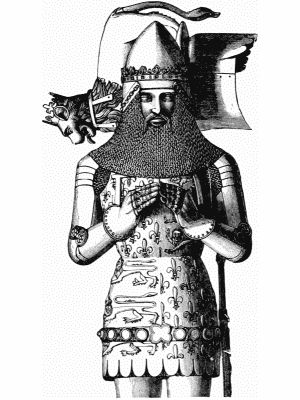
Fig. 46. Part of the gilt-latten effigy of Edward prince of Wales at Canterbury, showing labels over both the arms and the crest.
In modern heraldry the label is often drawn unduly wide, with short and ugly wedge-shaped pieces hanging from or sticking on to it, and sometimes it does not even extend to the sides of the shield. The result is that instead of its being a[Pg 102] comparatively unobtrusive addition to the arms the label becomes unduly conspicuous and void of all artistic effect.
The old way of differencing by the addition of a crescent, molet, or similar device[Pg 103] was generally carried out in quite an artistic fashion on account of the care taken to place the device agreeably, a favourite position being on the principal ordinary or charge of the arms.
Many cadets of the great family of Nevill, for example, differenced the arms of their house, gules a saltire silver, by placing the device on the middle of the saltire, and some of the Beauchamps placed the differencing mark on the fesse of their arms. In other cases the device was placed in the upper part of the shield, or in some other such point where it would least interfere with or be confounded with the charges.
One of the most difficult differences an artist has to contend with to-day is the silver scutcheon with a red hand which is placed upon the arms of baronets. Its position of course varies, and may often be altered with advantage, and it looks all the better if drawn not unduly large and with a simple heater-shaped shield. But some artists wisely leave it out altogether.
In the case of all devices introduced as differences it will generally be found advisable to draw them to a somewhat smaller scale than the charges already in the arms.
In many ancient heraldic shields, especially in painted glass, and to a lesser extent in carved work and on seals, the plain uncharged surfaces of the field or ordinaries are relieved by covering them with the purely ornamental decoration called diapering (figs. 45, 48). An early instance in relief occurs on the shield of the effigy in the Templars' church in London usually ascribed to Geoffrey de Magnavilla; and another delicately sculptured example of later date[Pg 106] is to be seen on the Vere effigy in Hatfield Broadoak church in Essex (fig. 47). Several fine instances of painted diapering will be found in Stothard's [Pg 107]Monumental Effigies. This beautiful treatment has, happily, been largely revived of late years by the glass painters, who use it quite successfully, probably from the ease with[Pg 108] which in their case it can be applied. Modern carvers use it very sparingly, and this perhaps is as it should be, for diapering needs to be done with great skill in sculpture to look well. A careful study therefore of old examples is advisable, in order thoroughly to understand the principles of its application.
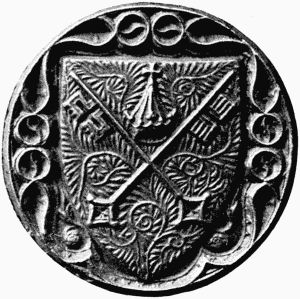
Fig. 48. Diapered shield from the seal of Robert Waldby archbishop of York, 1390, for the regality of Hexham.
Some of the finest diapered shields in carved work occur in the spandrels of the splendid monument of the lady Eleanor Percy in Beverley minster (figs. 49, 50). Good instances are to be found on seals, and a number of these are here illustrated in order to show the proper treatment of diapering. (See pls. VIII, XII, and XXVII A.)
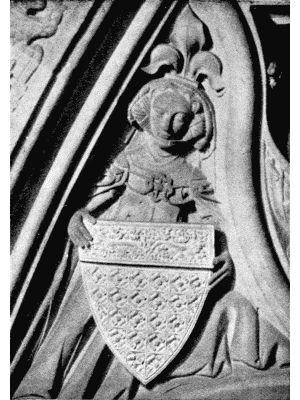
Fig. 49. Diapered shield of the arms of Clun, from the monument of the lady Eleanor Percy (ob. 1337) in Beverley minster.

Fig. 50. Diapered shield of the arms of Percy, from the monument of the lady Eleanor Percy (ob. 1337) in Beverley minster.
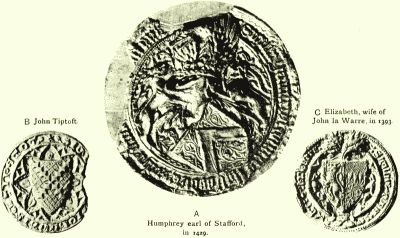
PLATE VIII.—Examples of diapered shields.
- A Humphrey earl of Stafford, in 1429.
- B John Tiptoft.
- C Elizabeth, wife of John la Warre, in 1393.
It is of course to be borne in mind that diapering is merely a surface decoration, and it must not on any account be emphasized by any difference of colour from that of the field or ordinary it relieves, nor must it be treated with such prominence as to render it liable to be mistaken for a charge or charges.
Diapering can be represented effectively in embroidered work by the use of flowered or patterned damasks, as may be seen in the banners in St. Paul's cathedral church in the chapel of the Order of St. Michael and St. George.
CHAPTER III
THE SHIELD AND ITS TREATMENT
(continued)
Armorial Bearings of Ladies; Use of Lozenges and Roundels as variant forms of Shields; Arms of Men on Lozenges; Combinations of Shields with Lozenges and Roundels of Arms on Seals and in Embroideries.
Before leaving the subject of the shield a few words must be written about the armorial bearings of ladies.
It has always been the practice for the daughters of a house to bear, without difference or alteration, the arms of their father. This practice has been departed from only in quite modern times, by the addition of distinctive labels to the arms borne by our princesses. To the manner in which married ladies have arranged or 'marshalled' their arms reference will be made later, but it is necessary here to call attention to the fact that it has been customary for a long time to place the arms of widows and single ladies upon shields that are lozenge-shaped. A good[Pg 110] early example is that from the monument in Westminster abbey church of Frances Brandon duchess of Suffolk (ob. 1559), shown in fig. 51.
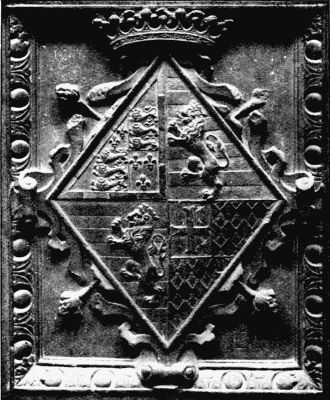
Fig. 51. Lozenge of arms from the monument at Westminster of Frances Brandon duchess of Suffolk (ob. 1559).
This singularly inconvenient form of shield, upon which it is often impossible[Pg 111] to draw the arms properly, began to be used early in the fourteenth century.
It was not, however, used for or restricted to the arms of ladies, since the evidence of seals shows that it was at first used to contain the armorial bearings of men. There can likewise be little doubt that it and the roundel, which was also charged with arms, were contemporaneously invented by the seal engravers as variants from the ordinary form of shield; and it is interesting to note that the majority of the examples occur on seals which have a background or setting of elaborate tracery.
The roundel seems to have originated in the covering of the entire field of a circular seal with the arms of its owner, such as the leopards of England which are so disposed in a counterseal of Edward of Carnarvon as prince of Wales. Two seals of John of Gaunt duke of Lancaster, engraved probably in 1372, show a similar treatment: the one bearing his arms impaling, and the other his arms impaled with, those of Castile and Leon (pl. VII B). The former commemorates his marriage with Constance of Castile, and the latter the duke's claim in right[Pg 112] of his wife to the kingdom of Castile itself.
A large enamelled roundel, party gules and azure with a gold charbocle, accompanies the shield and crested helm which, with it, form the stall-plate of Ralph lord Bassett (c. 1390) at Windsor.
One of the lesser seals appended to the Barons' Letter, that of Robert FitzPain, is an oval filled with the owner's arms (fig. 52).
One of the earliest examples of arms on a lozenge is on a seal of Thomas Furnival, who died in 1279, and another but little later is furnished by the seal of William de Braose, appended to a deed of either 1282 or 1314 at Magdalen College, Oxford (pl. IX B).
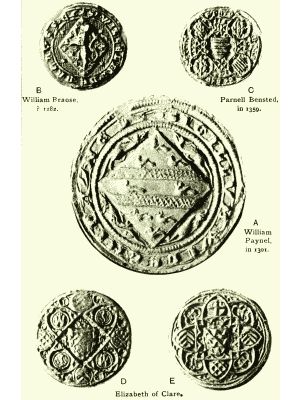
PLATE IX.—Use of lozenges and roundels of arms.
- A William Paynel, in 1301.
- B William Braose, ? 1282.
- C Parnell Bensted, in 1359.
- D E Elizabeth of Clare.
That of William Paynel, appended to the Barons' Letter, also has his arms on a lozenge (pl. IX A).
The first seal of a lady in which lozenges of arms occur is probably that of Joan, daughter of Henry count of Barre and Eleanor daughter of King Edward I, who married, in 1306, John de Warenne earl of Surrey (fig. 53). This has five lozenges arranged in cross: that in the middle has her husband's checkers, those on each side her father's barbels, etc. and those above and below the three leopards of England. The lady's descent from King Edward is further shown by the castles and lions of his consort Eleanor of Castile.
Another interesting example, of a date about 1320, is the seal of Parnel, daughter of H. de Grapenell, and widow (1) of John FitzJohn and (2) of Sir John Bensted (ob. 1323). This has in the middle a shield of the arms of Bensted, gules three gold gemell-bars, between four lozenges, apparently for Grapenell and FitzJohn (pl. IX C).
Contemporary with Parnel Bensted's seal are two others in which roundels are used instead of lozenges. Both are traceried seals of Elizabeth daughter of Gilbert of Clare earl of Gloucester, and Joan daughter of King Edward I and Queen Eleanor of Castile. She was thrice married: first, about 1306 to John of Burgh, son of Richard earl of Ulster; secondly to Theobald lord Verdon; and thirdly to Roger lord d'Amory, who died in 1322.
One of these seals has in the middle, in a shield, Elizabeth's own arms of Clare impaling Burgh within a black border bedewed with tears. Above and below are roundels of Clare, and on either side other roundels of Verdon and d'Amory. In the interspaces are the castles and lions of Castile and Leon (pl. IX D).
The other seal is similarly arranged, but has in the middle a large shield of d'Amory,[Pg 115] between roundels of arms of the lady's other husbands above and below, and of Clare for her father or herself on either side. The interspaces again contain castles and lions (pl. IX E).
Four other early seals of great artistic merit displaying roundels may also be described, especially since they are apparently the work of the same engraver. They are filled with tracery, consisting of a triangle enclosing a circle, which contains a large shield, with cusped circles on its sides containing roundels or devices.
The first is for Mary de Seynt-Pol, who married in 1322 Aymer of Valence earl of Pembroke (fig. 54). The shield bears the dimidiated arms of husband and wife; on a roundel in base are the arms of her mother; and higher up are roundels of England and France, out of compliment to King Edward II and Queen Isabel.
The second is for John de Bohun earl of Hereford, and has a large shield of Bohun with roundels also of Bohun. It was probably engraved in 1322, and before the earl's marriage in 1325 (pl. X A).
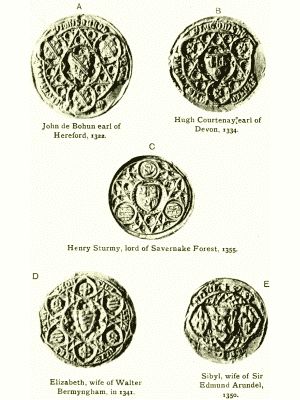
PLATE X.—Use of lozenges and roundels of arms.
- A John de Bohun earl of Hereford, 1322.
- B Hugh Courtenay earl of Devon, 1334.
- C Henry Sturmy, lord of Savernake Forest, 1355.
- D Elizabeth, wife of Walter Bermyngham, in 1341.
- E Sibyl, wife of Sir Edmund Arundel, 1350.
The third is for Richard FitzAlan earl of Arundel (1330-1), who succeeded to the vast Warenne estates in 1347. It has[Pg 116] in the middle a shield of FitzAlan, and about it three roundels with the checkers of Warenne.
The fourth is for Hugh Courtenay earl of Devon (1334-5-40)or his son Hugh (1340-77). The shield displays the arms of Courtenay and in each of the outer circles is a sexfoil (pl. X B).
To these examples may be added a fifth of about the same date, for Henry Sturmy or Esturmy, lord of the forest of Savernake. This has the Sturmy shield in the middle, between two roundels of the Hussey arms, and a third roundel above with the tenure horn of Savernake Forest (pl. X C).
Other seals that may be quoted in illustration of the indiscriminate use of shields, roundels, and lozenges during the fourteenth century are those of: (1) Juliana, daughter of Thomas Leybourne, and wife of John lord Hastings (ob. 1325), with a shield of Hastings impaling Leybourne, encircled by six lozenges of arms indicative of other alliances and descents, derived from the fact of the lady having been married thrice; (2) Elizabeth de Multon, wife of Walter Bermyngham, with the shield of Bermyngham surrounded by six roundels of other arms; (3) Maud, daughter of Bartholomew Badlesmere, and wife in 1336 of John de Vere earl of Oxford (fig. 55), with a shield of Vere between lozenges of Clare, Badlesmere (her father and herself), Clare with label (mother), and FitzPayn (first husband); (4) Maud, daughter of Henry earl of Lancaster, married first to William of Burgh earl of Ulster, and secondly (in 1343-4) to Sir Ralph Ufford (fig. 56), with lozenges of Lancaster (father and herself) above and Chaworth (mother) below, and shields of Burgh and Ufford (husbands); (5) Sybil, daughter of William Montagu earl of Salisbury and Katharine Graunson, with shield of FitzAlan with a[Pg 118] label, for her husband Sir Edmund of Arundel, second son of Edmund FitzAlan earl of Arundel, between lozenges of Montagu and Graunson (pl. X E);[2] and (6) Elizabeth, widow of Sir Gilbert Elsefield, with a lozenge of Elsefield between four roundels of other arms (impression 1382-3).
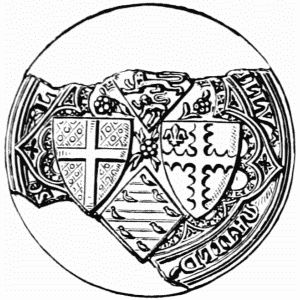
Fig. 56. Seal of Maud of Lancaster, wife (1) of William of Burgh earl of Ulster, and (2) of Sir Ralph Ufford, 1343-4.
Alice, wife of Thomas of Heslerton, has on her seal (impression 1374) a large lozenge of the arms of Heslerton (gules six silver lions with gold crowns) within a quatrefoil, outside of which are four small banners of arms with martlets between.
Lastly may be noted a seal of Roger Foljambe, attached to a deed of 1396-7,[Pg 119] having a lozenge of his arms (a bend and six scallop shells) surrounded by his word or motto.
But seals are not the only authorities for the indiscriminate use of roundels and lozenges as well as shields of arms. In the Victoria and Albert Museum at South Kensington is an enamelled coffer of late thirteenth century work decorated with lozenges of arms of England, Valence, Dreux, Angoulême, Brabant, and Lacy. The famous Syon cope de opere Anglicano, also in the Victoria and Albert Museum, has the existing orphrey filled with large armorial roundels and lozenges, and its border is composed of a stole and fanon embroidered throughout with lozenges of[Pg 120] arms. (See fig. 57.) Christchurch, Canterbury, in 1315 possessed an albe 'sewn with lozenges with the arms of the king of England and of Leybourne,'[3] and another 'sewn with the arms of Northwode and Ponyngg in squares';[4] also an albe 'sewn with divers arms in lozenges with purple frets with a stole and fanon of the same work,'[5] evidently not unlike those on the Syon cope.
It may also be noted that the pillows beneath the head of the effigy at Westminster of Aveline countess of Lancaster (c. 1275) are both covered with heraldic lozenges: on the upper one with the arms of her husband alternating with the lion of Redvers; on the lower with the vair cross on red of her father, William of Forz earl of Albemarle. The gilt metal bed plate under the effigy of William of Valence earl of Pembroke (ob. 1296), likewise at Westminster, is also covered with a lozengy diaper of England and Valence, still bright[Pg 121]
[Pg 122] with the original enamel; the workmanship of this, however, is probably French.
The restriction of the lozenge to the arms of ladies has clearly therefore no medieval precedent, and there is not any reason why the modern custom should not be set aside when for artistic reasons a shield or roundel is preferable.
[2] Impression attached to a deed in the British Museum, 1350-1.
[3] 'consuta de losenges cum armis regis Anglie et de Leyburn.'
[4] 'consuta de armis de Northwode et Ponyngg in quadrangulis.'
[5] 'consuta de diversis armis in lozengis cum frectis purpureis cum stola et manipulo ejusdem operis.'
CHAPTER IV
THE TREATMENT OF CRESTS
Origin of Crests; Earliest examples of Crests; Ways of wearing Crests; The Helm and its treatment; Modern use of Helms; Absurd Crests; Use of Crests other than by individuals; The comparative sizes of Helms and Crests.
A crest was originally, as its name reminds us, a tuft or plume on the head of a bird. Such a plume or tuft, or bush as it was often called, was fixed in early times as an ornament on the top of a helm, of which it thus formed the crest. Other devices, such as could conveniently be so worn, were soon used for the same purpose, and like armorial bearings became associated with particular individuals. In later days when the helm enveloped the whole head, the crest played a useful part in revealing the wearer's identity, though his face was hidden.
One of the earliest suggestions of a crest in English armory appears on the second great seal (of 1198) of King[Pg 124] Richard I, whose cylindrical helm has a leopard upon the cap with two wing-shaped fans above turned in opposite directions. On many seals of the second half of the thirteenth century, as, for instance, on those of Robert de Vere earl of Oxford (1263) and Henry de Laci earl of Lincoln (1272), the knight is represented as riding in full armour, with the helm surmounted with a fan-shaped plume, which is also repeated upon the horse's head. (See also fig. 58 and pl. XI B.)
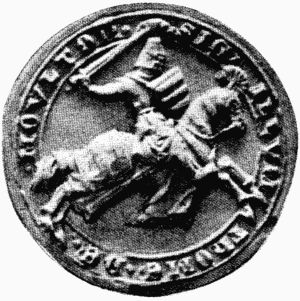
Fig. 58. Seal of Thomas de Moulton, with fan-shaped crest on helm and horse's head. From the Barons' Letter.
An early use of a crest proper is furnished by the seal of Roger of Leybourne (ob. 1284). This shows his shield of arms (bearing six lions) hung upon a tree, with his banner (charged with one lion only) behind, and at one side a helm with lion crest (pl. XI A). Thomas of Berkeley in 1295 has upon his seal a shield flanked by two mermaids and surmounted by a helm carrying a mitre for a crest. Thomas earl of Lancaster (1296) on two separate seals has a wiver, or two-legged dragon, upon his helm, and this again is repeated upon his horse's head (fig. 59). The seal of his brother Henry of Lancaster, appended to the Barons' Letter, also shows his helm crested with a wiver (fig. 60). Two other early examples of crests on seals from the Barons' Letter are shown in figs. 61 and 62. Sir John Peche, on a seal appended to a deed of 1323-4, has his shield flanked by wivers and surmounted by a helm with squirrel crest. William Montagu earl of Salisbury (1336-7), in the mounted figure of himself on his fine seal, has a demi-griffin fixed upon his crowned helm (pl. XII B), and King Edward III shows for the first time, on his seal of 1340, his crest of a crowned leopard standing upon the cap of estate which surmounts his helm.

Fig. 59. Seal of Thomas earl of Lancaster, Leicester, and Ferrers, showing wiver crest on his helm and horse's head. From the Barons' Letter.
During the first half of the fourteenth century there is an interesting diversity in the manner of representing crests, when not being worn by their owners.
William Montagu earl of Salisbury shows on his counterseal (pl. XII A) his shield supported by two griffins, and ensigned by the demi-griffin issuing from an open crown which in his seal he carries upon his helm. John Engayn, in 1349, has upon the upper edge of his shield a wolf or fox[Pg 128] walking under a tree. Henry duke of Lancaster (1341) ensigns the shield of his arms with a cap of estate surmounted by a leopard (pl. XIII C); and Peter de Mauley, the sixth of that name, in 1379-80 has a seal with his simple arms (a bend) supported by two ramping leopards, and surmounted by a fierce dragon breathing defiance (pl. XX B). In none of these cases does a helm appear.
After the middle of the fourteenth century the crest is invariably shown as part of the helm.
The helm, it is hardly necessary to say, was such an one as formed part of the war[Pg 129] harness of the time, and in the numerous armorial representations that may be found on seals or on monuments or buildings it is almost invariably shown in profile. This was, however, merely on account of its being the most convenient way of displaying the crest, and, in accordance with the usual medieval common-sense, examples are to be found which show the helm and crest facing the observer.
Thus Thomas de Holand (1353) has on his seal a shield of his arms hung from a tree and flanked by two fronting helms, each encircled by a crown and surmounted by a huge bush of feathers; Sir Robert de Marni (1366) flanks his shield, which is also hung from a tree, with two fronting helms, each crested with a tall pair of wings rising from the sides of a cap of estate (fig. 63); Sir Stephen Hales (1392-3) on his seal has a couched shield of his arms surmounted by a fronting helm, with a crown about it from which issue two fine wings; Robert Deynelay (1394-5) in like manner shows his helm crested with two ears of a bat or hare; and Walter lord FitzWalter (1415-31) has on his seal a couched shield, and on a fronting helm above a cap of estate surmounted by a star between two large[Pg 130] wings (pl. XIII A). Another example of a fronting helm is shown in pl. V B.
The present custom of using various types of helm facing different ways to denote grades of rank is comparatively recent as well as often inconvenient, and utterly subversive of the proper method of displaying a crest, which should invariably face the same way as its wearer. This fact is amply illustrated by the early stall-plates at Windsor, but the modern crested helms surmounting the stalls there were for a long time the scoff of students of heraldry owing to the absurd manner in which the crests were set athwart the fronting helms. It is pleasant to be able to add that the crests have lately been replaced almost throughout[Pg 131] by a new and larger series, worthy of their surroundings, and set upon the helms in the proper way. Under the same enlightened administration the most recent stall-plates are enamelled creations of real artistic and heraldic excellence.
The crest was, of old time, almost always something that could actually be set upon a helm, and such objects as naturally were[Pg 132]
[Pg 133]
[Pg 134] too large or too heavy were modelled in boiled leather, wood, or other light material: like the fine crest borne at the funeral of Edward prince of Wales, now over his tomb at Canterbury, which is a leopard standing upon a cap of estate and modelled in leather covered with stamped gesso (fig. 65); or the soldan's head of carved wood that surmounts the funeral helm of George lord Cobham, in Cobham church, Kent (fig. 66).
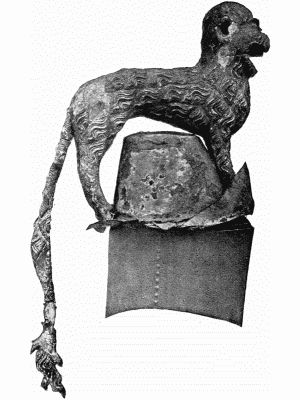
Fig. 65. Crest of Edward prince of Wales, 1376, of leather and stamped gesso, from his tomb at Canterbury.
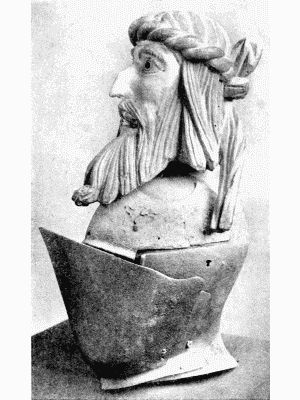
Fig. 66. Funeral helm and wooden crest of George Brooke lord Cobham (ob. 1558) in Cobham church, Kent.
Such impossible crests as the pictorial scenes and other absurdities granted by the kings-of-arms during the eighteenth and nineteenth centuries, and even back to Elizabethan days, would not have been thought of at an earlier period, when heraldry was a living art.
The degradation of the proper use of a crest, other than by those entitled to wear one, began as soon as the kings-of-arms presumed to grant armorial bearings by their bestowing crests upon impersonal corporate bodies like the London livery companies, such as the Tallow Chandlers (1456), Masons (1472), and Wax Chandlers (1485-6).
Arms were borne by the mayor and commonalty of a city or town at least as[Pg 135] early as 1283 in the case of Chester, and of 1305 in the case of Dover (or the Cinque[Pg 136] Ports), but none presumed to use a crest until London did so on the making of a[Pg 137] new seal in 1539, and no crest was granted to a town before 1561.
Before leaving crests a word must be said as to their comparative sizes.
Throughout the best period of heraldic art the crested helm and the shield in pictorial representations practically balance[Pg 138] one another, but there is occasionally a tendency to diminish the shield, and so apparently to enlarge the crest. This may be seen, for example, in several of the early stall-plates at Windsor (figs. 67, 68), which otherwise are admirable models as to the treatment of crests in general. They also show very clearly how easily and comfortably the crests surmount the helms.
A remarkable early English example of the use of two crests is furnished by a seal of Richard Nevill (1449-71), the 'Kingmaker,' who was earl of Salisbury, and, in right of his wife, also earl of Warwick (fig. 69). This exhibits two helms above the multi-quartered shield, the one carrying the Beauchamp swan for the earldom of Warwick, the other the Montagu griffin for the earldom of Salisbury.
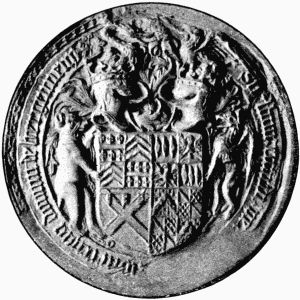
Fig. 69. Seal of Richard Nevill with separate crests and supporters for his earldoms of Salisbury and Warwick.
CHAPTER V
MANTLINGS
Origin of Mantlings; Simple early forms; Colours of Mantlings; Medieval usage as to colours of Mantlings.
In actual use the helm seems often to have been covered behind by a hanging scarf or cloth of some kind, perhaps to temper the heat of the sun, like a modern puggaree. Heraldically this is represented by what is now called the mantling.
At first this was a simple affair, worn puggaree-wise, but by degrees it was enlarged in representations until it extended on either side beyond the helm, and was disposed in graceful twists and folds with dagged edges, which have been supposed to represent the cuts it was liable to receive during fighting (figs. 70, 71).
The usual colour for the mantling, for a long time, has been red, and its lining of ermine or white fur, but there is ample precedence for a difference of treatment, as may be seen in that rich collection of[Pg 140] ancient heraldic art, the stall-plates at Windsor.
The earliest surviving plate, that of Ralph lord Bassett (K.G. 1368-90), has a short black mantling, to match the boar's head that forms his crest (fig. 72). A large group of plates set up in 1421 exhibits a considerable variety. Thus the plate of Sir Sanchet Dabrichecourt has a red mantling powdered with gold lozenges, a treatment suggested by two bands of red similarly decorated which encircle the bush of feathers forming his crest (fig. 73). The[Pg 141] mantling of William lord Latimer is of red and silver stripes, and that of John lord Beaumont, like the field of his shield, is, together with the cap of estate, of blue powdered with gold fleurs-de-lis. Sir Walter Pavely has also a blue mantling.
Sir William FitzWaryn's mantling is quarterly per fesse indented of red and ermine, like his shield of arms. The Captal de Buch, Raynald lord Cobham, Hugh lord Burnell (fig. 77), Hugh lord Bourchier (pl. XVI), and Sir Thomas Banastre have black mantlings,[Pg 142]
[Pg 143] and John lord Bourchier and William lord Willoughby d'Eresby (pl. XV) white mantlings lined with red. Sir Miles
[Pg 144] Stapleton and the Soudan de la Trau have black mantlings lined with red. Several early mantlings, too, are formed entirely of silver feathers, with red, black, or other linings. These usually accompany a feathered crest, like Sir William Arundel's griffin (fig. 74), or the earl of Warwick's swan (fig. 75), or Sir Thomas Erpingham's bush of feathers. Another curious variation, which is found on four early plates, has the colour of the mantling different on the two sides of the helm, such as red on one side, and blue or black on the other. In about a dozen plates between 1450 and 1470 the red, and in one case the blue, ground of a mantling is relieved by a trailing pattern in gold, sometimes in lines only, but more usually as leafwork or flowers. In the plate of Walter lord Hungerford (el. 1421) the mantling on his banner-like plate is barred with red and ermine (see fig. 136), in allusion to the arms of his lordship of Hussey. Lastly, in the plate of Richard lord Rivers (el. 1450) the mantling is red, sown with gold trefoils, and lined with white, with gold tassels at the ends (fig. 76). This is derived from the crest, which is the upper part of a man brandishing a scimitar,[Pg 145] and clad in a red tunic with standing collar and large hanging sleeves, also sown with trefoils. The sleeves are cleverly arranged in the plate, as if forming part of the[Pg 146] mantling, and are similarly dagged and lined and tasselled. On the stall-plate[Pg 147] (c. 1483) of Francis viscount Lovel the mantling is of purple sown with gold hanging locks.
CHAPTER VI
CRESTS AND CROWNS, CAPS OF ESTATE, AND WREATHS
Crests within Crowns; Nature and treatment of Crowns; Caps of Estate: Their possible origin and introduction into Heraldry; The colour of Caps; The placing of Crests upon Caps; Wreaths or Torses; Their Colour; Crests and Mottoes; Use of Crests by Bishops; The ensigning of Arms with Mitres, Cardinals' and Doctors' Hats, and Caps of Estate.
The treatment of the crest varies. In the earliest examples it is set directly upon the mantled helm (fig. 77 and pls. XIV A and XVII B), to which it was actually attached by wires through holes on top. But from the first large numbers of crests were fixed, or rose as it were, from within a crown or coronet encircling the helm, or stood upon a cap or hat of estate that surmounted it. (See figs. 65, 67, 72, 73, 74, 75, and pls. XIII E and F, XVII A, XXI, XXII, XXVII A, etc.)
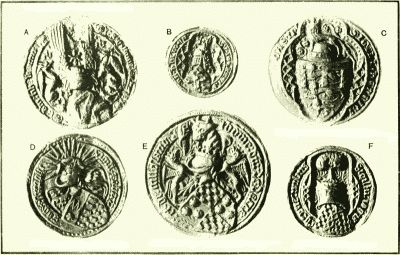
PLATE XIII.—Various treatments of crests.
- A & B, Walter lord FitzWalter, 1415-31.
- C, Henry duke of Lancaster, 1341.
- D, Robert Shottesbroke, 1458-9.
- E, Thomas lord Dacre of Gilsland, 1412.
- F, Sir John Cheyny, 1395.

PLATE XIV.—Examples of crests and mantlings.
- A, Edmund Grey earl of Kent, 1442.
- B, Thomas Ballard, Esq.
- C, Sir Henry Ingelose, of Loddon, 1451.
The crown was merely ornamental, and had no reference to the dignity of the[Pg 149] wearer, but was used alike heraldically by prince and peer, knight and esquire, and the same may be said of the cap of estate.
Crowns were anciently formed of a number of leaves or fleurons set upright upon the band, sometimes with lesser leaves or jewels between them; the bands[Pg 151] too were often jewelled. But in practice only three (fig. 78), or sometimes five, principal leaves are shown when the crown is drawn in profile (fig. 83).
Beyond the fact that the thing was a crown, there was no strict rule as to the design, which varied according to the taste of the artist. Two examples among the early stall-plates at Windsor, those of Hugh Stafford lord Bourchier (fig. 79 and pl. XVI) and Richard lord Grey of Codnor (both c. 1421), illustrate this in a pretty way (fig. 80). In both cases the plate after being finished has been cut up, partly reversed, and in part re-engraved; not because anything was wrong with the heraldry, but to make the crested helms face the other way. These have accordingly been turned over, but in cutting them afresh the engraver has slightly varied the designs of the crests and of the crowns with which each is encircled, without however in any way altering their heraldic character. In the earliest existing plates the crested helms are all drawn turned towards the high altar, consequently those on the north side of the quire face heraldically towards the sinister. The two plates just noted, and at least one other, have been[Pg 152] transferred from one side of the quire to the other.
One of the first instances of a crown about a crest is on the seal of William Montagu earl of Salisbury, 1337 (pl. XII).
Crowns were not by any means always of gold or silver, and quite a number of[Pg 153] pre-Tudor stall-plates have them enamelled red, and in two cases blue.
These heraldic crowns must not be confounded with the coronets, as they are now called, worn of different patterns by peers and peeresses according to their degree; some reference to these will be made later.
The cap of estate is generally depicted in English heraldic art as a high crowned conical hat or cap with flattened top, and a broad brim lined with ermine. The brim is usually turned up high in front, but gradually lessens along the sides towards the back, where the brim extends horizontally to its full width.
The cap of estate first appears, surmounted by his leopard crest, on the head of King Edward III in the great seal made for him in February 1339-40 on his assumption of the title of King of France. Whether the cap has any connexion with the assumption of the king's new title it is difficult to say, but its more common name of 'cap of maintenance' would acquire a significant meaning could such connexion be proved. It is however more probable that the cap was worn by the king for his dignity of duke of Normandy and of Aquitaine, and it was long the custom for representatives of those duchies to take part in coronation processions wearing robes and caps of estate. According to the Little Device for the coronation of Henry VII, there were to ride before the king in the procession from the Tower 'ij Squiers for the kinges bodie bearing in baudrick[Pg 155] wise twoo mantells furred wt Ermyns, wearing twoo hattes of Estate of Crymsen clothe of golde beked on, beks turnyd upp behinde, and furred also wt Ermyns in reprecentacion of the kinges twoo duchesses of Gyen and Normandie.'[6]
Although the cap may at first have been restricted to the king, it was certainly used by the sons of Edward III, and may be seen of like form and fashion upon the seals of Edward as prince of Wales (1343), of John of Gaunt as duke of Lancaster (1362) and of Edmund of Langley as duke of York (pl. XXI), and of Thomas of Woodstock as duke of Gloucester in 1385. It was no doubt in each case given by personal investiture by the Sovereign, but only to those who were made dukes.
In heraldry, however, the cap of estate was used after 1350 by many who were not only dukes who had been invested with it, but by earls and barons who had not been so invested, and even by mere knights (pl. XIII F).
It would be as rash to argue from this that such persons were all entitled to wear for dignity the cap of estate as it would be[Pg 156] to insist that the equally common use of a crown round the base of a crest entitled every knight or baron on whose seal it occurs to wear a coronet.
The colour of the cap of estate was almost invariably red, with a lining of ermine, but in two of the early stall-plates it is blue. The crest is generally placed directly upon it, but representations of two-legged or four-legged creatures often stand upon the brim with their feet on either side of the flat-topped cap (figs. 112, 138). It is hardly necessary to say that the crested cap is always placed upon the helm, with the mantling issuing from under it.
It is a common practice nowadays, quite wrongly, to represent crests apart from the helm, and as standing upon a twisted bar, or wreath as it is called. A little research will show that this bar represents the twisting together of two or three differently coloured stuffs, and fixing the wreath so formed round the base of the crest to mask its junction with the top of a helm. Once invented it came into common use, and crests of all kinds were fixed within it.
When seen sideways the rounded top of the helm causes the crest to appear as if[Pg 157] standing upon the wreath, and this has no doubt given rise to the present malpractice.
The Rev. C. Boutell in his smaller English Heraldry quotes the Hastings brass at Elsing, of the year 1347, as the earliest instance of a wreath about a crest (fig. 81). But this brass is probably French, and in English work the wreath does not come into being much before the close of the fourteenth century, and was not regularly used until about 1450.
The wreath or torse, as it was also called, from being a twist, was usually of two colours, derived from the principal metal and colour of the arms; but the fifteenth century stall-plates show many variations from this rule. Thus Lewis lord Bourchier (c. 1421) has a torse of blue, gold, and[Pg 158] black, and John earl of Tankerville (c. 1421) one of green, red, and white. John lord Bourchier (c. 1421) and Henry lord Bourchier (c. 1452) both have black and green torses. Richard Wydville lord Rivers (c. 1450) has the crest issuing from a green torse, crested with a crown of holly leaves. Thomas lord Stanley (c. 1459) has a torse of gold and blue with red spots or jewels between, and Sir William Chamberlayne (c. 1461) a red and blue torse.
The modern practice is that the twists of a torse shall be only six in number; but in old heraldry there was no such rule, and any number from four may be found, whatever would look best. In the Harsick brass (fig. 82) there are eleven twists.
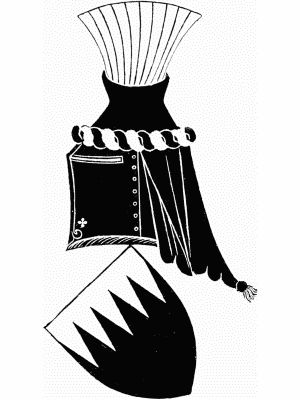
Fig. 82. Helm with crest and torse and simple form of mantling, from the Harsick brass at Southacre, 1384.
Crests occasionally had mottoes or 'words' associated with them, quite apart from the ordinary 'word' or 'reason' of the family or individual. Thus the ermine bush of feathers that formed the crest of Sir Simon Felbrigge is accompanied on his stall-plate (c. 1421) by a scroll lettered Sanz muer (fig. 83), and on that of John lord Scrope (el. 1461) the crest, which is likewise a bush of feathers, has above it the 'reason' autre qz-elle. Two of the fine[Pg 159]
[Pg 160] seals of Richard Nevill earl of Salisbury (1428-60) have behind his demi-griffin
[Pg 161] crest a scroll lettered apparently ma [or do] pleſier (pls. XVII A and XXII B), and the seal of John Talbot earl of Shrewsbury, as marshal of France (1445), has a scroll with his 'word' issuing from the mouth of his lion crest (pl. XVII B).
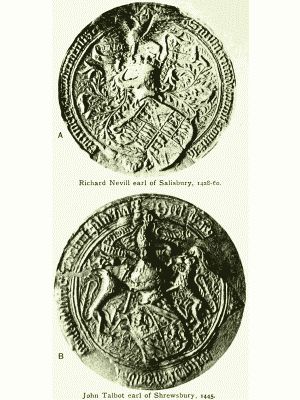
PLATE XVII.—Crests with mottoes.
- A, Richard Nevill earl of Salisbury, 1428-60.
- B, John Talbot earl of Shrewsbury, 1445.
From what has been said above as to the ancient association of helm and crest, it follows that the present fashion of representing the crest by itself, apart from the helm to which it was always attached, is entirely wrong. It at once renders the crest meaningless: in appearance it forthwith becomes insignificant; and attempts to treat it artistically generally end in failure.
Let crests be shown as crests, properly set upon practicable helms, and with competent mantlings treated with all the freedom that they are capable of.
It may here be noted that it has not been customary, nor is it logically correct, for ladies and other non-combatant persons, such as the ministers of the Church, to use crests; arms they have ever been allowed to bear. Examples, however, of the breach of the rule as to crests even by bishops are afforded by several of their privy seals. Thus Henry le Despenser bishop of[Pg 162] Norwich (1370-1406) has his differenced shield of arms surmounted by a mantled helm upon which a mitre, with a griffin's head and wings issuing therefrom, is placed as a crest (fig. 84); and Alexander Nevill archbishop of York (1374) shows his shield hanging below a crowned helm surmounted by the bull's head crest of his house and supported by two griffins.
William Courtenay, as archbishop of Canterbury (1381-96), similarly displays a shield of his arms, ensigned by a helm surmounted by a cap of estate with a dolphin on top. A helm crested with a lovely bunch of columbines is also carved with his arms above the tomb of James Goldwell[Pg 163] bishop of Norwich (ob. 1498-9) in his cathedral church.
Robert Nevill on his privy seal as bishop of Durham (1438-57) surmounts his shield with a beautiful labelled mitre, from which issues a bull's head with a scroll lettered en grace affie.
Many of the bishops of Durham, on their great seals in chancery, in virtue of their secular palatinate jurisdiction, are represented as riding in complete armour with helms on their heads. The first to be so represented was Thomas Hatfield (1345), who wears a large crowned helm surmounted by a mitre, from which issues a bush of feathers. John Fordham (1381) also surmounts his crowned helm with a mitre, on which is perched a bird. Walter Skirlaw (1388) and Thomas Langley (1406) set within the crowns crests without mitres; in one case the bust of an angel, in the other a bush of feathers. Robert Nevill (1438) surmounts his crowned helm with a mitre, from which issues a bull's head, as on his privy seal above noted. Cuthbert Tunstall (1530) has a mitre alone upon his helm.
The usual practice in displaying a bishop's arms has been, for a long time, to ensign[Pg 164] them simply with his own official headgear in the shape of a mitre, and the same custom prevailed with regard to the arms of mitred abbots and priors. Robert Nevill's privy seal is an early example.
Cardinals ensigned their shields with the tasselled hat of their order, as may be seen on the seal-of-arms of Henry Beaufort bishop of Winchester (1405), and in a carving of his arms in Southwark cathedral church. A cardinal's hat is displayed, with his rebus and sundry royal badges, on the arch about the cenotaph of John Morton archbishop of Canterbury and cardinal in the undercroft of his cathedral church.
Doctors also sometimes surmounted their arms with the round cap pertaining to their dignity.
On the monument at St. Albans of Humphrey duke of Gloucester (ob. 1446) his arms are ensigned alternately by his mantled and crested helm, and by a large cap of estate encircled by a crown or coronet. Jasper duke of Bedford (1485) on his seal likewise surmounts his arms with a cap of estate encircled by a delicate crown.
There is not any necessity at the present day to represent any crown or coronet with the cap of estate within it.
[6] L. G. Wickham Legg, English Coronation Records (Westminster, 1901), 223.
CHAPTER VII
THE USE OF BADGES, KNOTS, AND THE REBUS
Definition of a Badge; Difference between Crests and Badges; Examples of Badges; The Ostrich-Feather Badge; The White Hart, etc.; Introduction of Badges into Heraldry; Their Prevalence; Allusive Badges; Badges of obscure Origin; Knots and Badges; The Rebus.
Closely allied with crests, but borne and used in an entirely different way, are the devices called badges.
The whole history of these is in itself of great interest, and the facility with which they lend themselves to artistic heraldic decoration renders badges of peculiar value.
A badge is, properly speaking, any distinctive device, emblem, or figure assumed as the mark or cognisance of an individual or family; and it should be borne alone, without any shield, torse, or other accessory. But a badge may be and often was, like a crest, accompanied by a word, reason, or motto. There is however this important difference between a crest and a[Pg 166] badge, that the crest was pre-eminently the personal device of its owner, while his badge might also be used by his servants and retainers. Such a use of the badge still survives in the 'crest' on the buttons of liveried servants.
The most famous and best known badge is that of the three ostrich feathers encircled by a crown or coronet borne by the Prince of Wales. It was probably introduced by Queen Philippa, who is known to have possessed plate ornamented with 'a black scocheon of ostrich feathers,' perhaps allusive of the Comté of Ostrevant, the appanage of the eldest sons of the house of Hainault. A single ostrich feather, alone or stuck in a scroll, occurs after 1343 in several seals of Edward prince of Wales, and on his tomb at Canterbury the shield of his own arms alternates with his mother's black shield with three silver ostrich feathers, each transfixing a scroll with the word ich diene; over the shield is likewise a scroll inscribed with the same words (fig. 85). John of Gaunt duke of Lancaster is said to have borne an ostrich feather powdered with ermine tails, and Thomas of Woodstock duke of Gloucester, the youngest[Pg 167] of Queen Philippa's sons, bore the feathers with a strap (which some have regarded as a Garter) extended along the quill (fig. 86). The Queen's great-grandson, Richard duke of York and earl of March (1436), bore the feather with a chain similarly placed; perhaps Edmund of Langley, his grandfather, had done the same. Henry of Lancaster, the son of John of Gaunt, on his seal as earl of Derby in 1385 (pl. XXIV C) and on that as duke of Hereford in 1399, has an ostrich feather stuck in the end of a scroll which is entwined about the feather and inscribed with the significant word souvereyne, and the same word is[Pg 168] repeated many times on his tomb as King Henry IV at Canterbury.
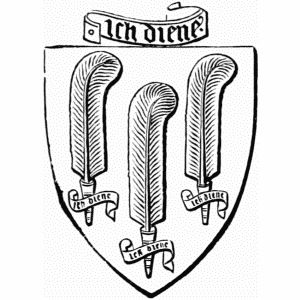
Fig. 85. Shield with ostrich-feather badge from the tomb of Edward prince of Wales (ob. 1376) at Canterbury.
Another notable badge is the couched white hart of King Richard II, with which may be named the white hind borne by his kinsman, Thomas Holand earl of Kent (pl. XVIII B).
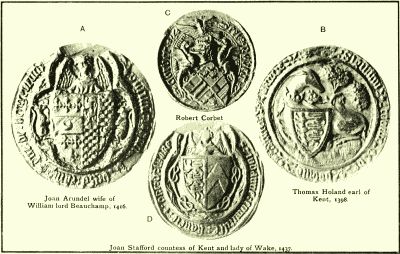
PLATE XVIII.—Examples of supporters.
- A Joan Arundel wife of William lord Beauchamp, 1416.
- B Thomas Holand earl of Kent, 1398.
- C Robert Corbet
- D Joan Stafford countess of Kent and lady of Wake, 1437.
The fetterlock-and-falcon (fig. 87) and the white rose of the house of York, the white lion of the earls of March, the rayed rose of Edward IV, and the silver boar of Richard III are of course well-known[Pg 169] badges; as well as the red and the red and white roses, the crowned fleur-de-lis, and the Beaufort portcullis, used by the Tudor kings (fig. 88).
When badges first came into use in this country is uncertain, but after the middle of the fourteenth century they abound. They are foreshadowed by the free treat[Pg 170]ment of earlier decorative heraldry, such as the little leopards on the footgear and pillows of King Henry III's gilt-latten effigy at Westminster, and the plate with its lozengy diaper of leopards on which it lies; also the lozengy diaper of castles and lions which covers the metal plate whereon lies the effigy of Queen Eleanor of Castile.
Many badges, too, originated in devices borrowed from various sources and arranged about the shield on seals, as in figs. 89 and[Pg 172] 90, which are only two out of a number of such appended to the Barons' Letter.
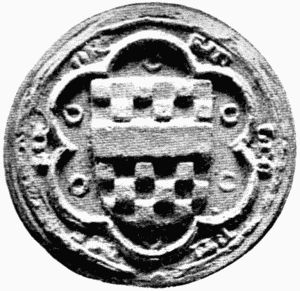
Fig. 89. Seal of Robert de Clifford, with arms surrounded by rings in allusion to his mother Isabel Vipont.
The famous white swan badge of the Bohuns (fig. 91) is found perched upon the shield in the seal of Humphrey Bohun earl of Hereford and Essex, 1298 (pl. XIX B). Later on its neck was encircled by a crown for a collar, with a chain attached, and in this form it appears on the seals of Thomas of Woodstock, who married Eleanor Bohun (fig. 86), and on that lady's brass at Westminster. It was also borne by the sons and descendants of King Henry IV by his wife Mary Bohun.

PLATE XIX.—Origin of supporters.
- A Stephen Longespee, ob. 1260.
- B Humphrey de Bohun earl of Hereford and Essex, constable of England, 1298.
The gilt-latten effigies of Richard II (fig. 92) and Anne of Bohemia have their dresses pounced all over with badges, such[Pg 173] as the white hart, the sun-burst, and the broom sprigs on that of the king, and the[Pg 174] ostrich and a peculiar knot on that of the queen. In 1380 Edmund Mortimer earl of March left a bequest of 'our large bed of black satin embroidered with white lions and gold roses, with scocheons of the arms of Mortimer and Ulster,' and in 1385 Joan princess of Wales bequeathed to her son the King (Richard II) 'my new bed of red velvet embroidered with ostrich feathers of silver and leopards' heads of gold with boughs and leaves issuing from their mouths.' In 1397, Sir Ralph Hastings, whose arms were a red maunch or sleeve on a gold ground, and his crest a bull's head, left bequests of a silver bason and laver 'stamped with a bull's head (cum capite tauri), a vestment of red cloth of gold with orfreys before and behind worked with maunches (cum maunches) and with the colours of mine arms,' and six salts stamped with maunches. In 1388 John of Gaunt duke of Lancaster mentions in his will 'my great bed of cloth of gold, the field powdered with roses of gold set upon pipes of gold, and in each pipe two white ostrich feathers,' also 'my new vestment of cloth of gold the field red worked with gold falcons.' Two falcons holding hanging locks in their beaks are also[Pg 175] shown on one of the duke's seals (pl. XXI A). In 1400 Thomas Beauchamp earl of Warwick left a bed of silk embroidered with 'bears of mine arms'; and in 1415 John lord le Scrope mentions in his will documents sealed cum signato meo de Crabb, and in a codicil made in 1453 he bequeaths 'j fayre pile of coppis conteyning xij coppis of gilt, with crabbis in ye myddes, and two coveryngis to thame with crabb.' In the north of England a crab is often called a scrap, whence its assumption by the Scropes.
Such examples as the foregoing could be multiplied indefinitely, but they will suffice to show the prevalence of badges and the many ways in which they were used. They of course abounded on seals as well as on monuments of all kinds, and in conjunction with architecture. Under this last head may be quoted such examples as the arches in Wingfield church, Suffolk (fig. 93), studded with leopards' heads, wings, and Stafford knots, commemorative of Michael de la Pole earl of Suffolk (ob. 1415) and his wife Katharine Stafford; the porch and other parts of Lavenham church, displaying the boars and molets of John de Vere earl of Oxford; bishop Courtenay's chimney-piece in the bishop's palace at Exeter[Pg 176]
[Pg 177]
[Pg 178]
[Pg 179]
[Pg 180]
[Pg 181] (fig. 94); and the great displays of Tudor badges on the deanery gateway at Peterborough (fig. 95), the gatehouses at Christ's (fig. 96) and St. John's Colleges (fig. 172) at Cambridge, and the noble chapel of King's College. Special mention must also be made of the magnificent bronze doors of Henry VII's chapel at Westminster, than which no more beautiful example of the use of badges for decorative purposes could possibly be found (fig. 97).
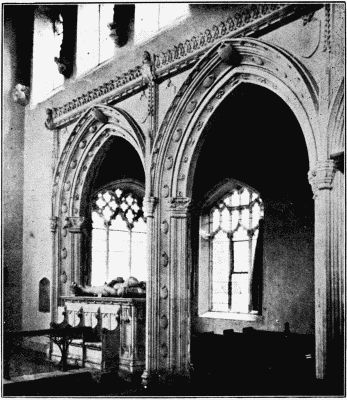
Fig. 93. Piers and arches in Wingfield church, Suffolk, with badges of Michael de la Pole earl of Suffolk (ob. 1415) and his wife Katharine Stafford.
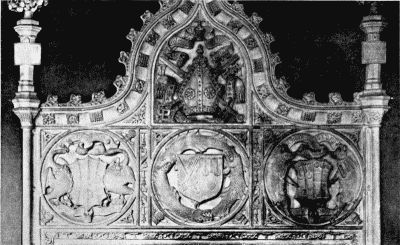
Fig. 94. Chimney-piece in the Bishop's Palace at Exeter with the arms and badges of bishop Peter Courtenay, 1478-87.
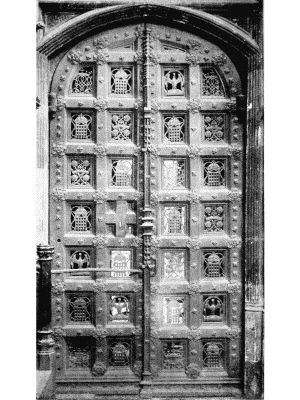
Fig. 97. Bronze door with badges of York and Beaufort, from the Lady chapel of Westminster abbey church.
The sources of badges were various. As a matter of fact a man's badge was often the same device as his crest, like the[Pg 182] Courtenay dolphin, or the boar of the Veres, or the sickle of the Hungerfords. Sometimes the badge was derived from a part of the arms, such as the leopards' heads and the wings of the de la Poles, the water-bougets of the Bourchiers (fig. 98), the silver molet of the Veres (fig. 99), and the Phelip eagle (fig. 100). If by chance a badge could have any punning or allusive meaning it was the more popular, and it then often served as a rebus. The boar (verre) of the Veres (fig. 99), the crab or scrap of the Scropes, the pike or luce of the Lucys, the long swords of Longespee (pl. XIX A), the gray or badger of Richard lord Grey of Codnor (fig. 102), and the wood-stock or tree stump of Thomas duke of Gloucester, who was born at Woodstock, are all good examples of a practice[Pg 183] that should be followed whenever possible, even in these degenerate days.
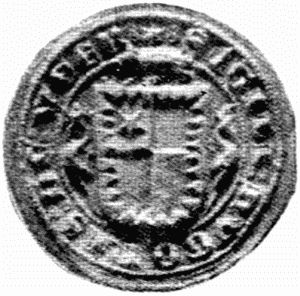
Fig. 99. Seal of Hugh de Vere with boar badge and two wivers as supporters. From the Barons' Letter.
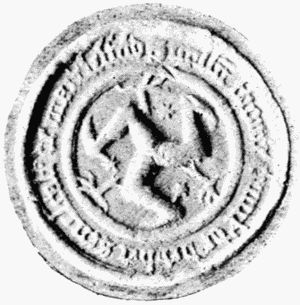
Fig. 103. Seal of Thomas lord Stanley as earl of Derby and seneschal of Macclesfield, 1485, with the eagle's claw badge of Stanley and the legs of the Isle of Man.
But in a large number of cases the badge[Pg 184] has a different and often quite obscure origin, like the Bohun swan, the Percy crescent and swivel, the Beauchamp bear and ragged staff, the Lovel hanging-lock, the Zouch eagle and crooked billet, and the Berkeley mermaid.

Fig. 104. Daisy plant (marguerite) badge of the Lady Margaret Beaufort, from Henry VII's chapel at Westminster.
A few families, e.g. the Staffords (fig. 105), the Bourchiers, and the Wakes, used as a badge some special form of knot, and[Pg 185] attention has already been called to the peculiar knots pounced upon the effigy of Queen Anne of Bohemia. Interesting examples of the Bourchier knot may be seen on the tomb of archbishop Thomas[Pg 186] Bourchier at Canterbury, and on the brass of Sir Humphrey Bourchier at Westminster[Pg 187]
[Pg 188] (fig. 106), and a good instance of the application of the knot is afforded by the seal of Joan Stafford countess of Kent and lady of Wake, who encircles her impaled shield with a cordon of Stafford knots (pl. XVIII D). On the tomb at Lowick (Northants) of Edward Stafford earl of Wiltshire (ob. 1498) the shields are encircled with cordons of Stafford knots with another Stafford badge, the nave of a wheel, alternating with the knots (fig. 107). On the canopy of the tomb at Little Easton in Essex of Henry Bourchier earl of Essex (ob. 1483) and his wife Isabel, sister of Richard duke of York, is a badge formed by placing a Bourchier knot within a fetterlock of York.

Fig. 105. Part of the brass at Exeter of canon William Langeton, kinsman of Edward Stafford bishop of Exeter, 1413, in cope with an orphrey of [X]'s and Stafford knots.
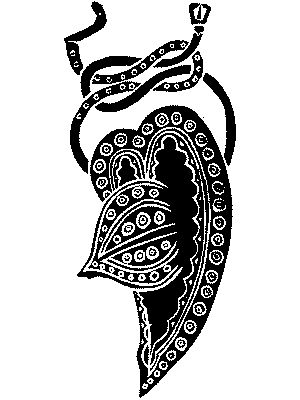
Fig. 106. Elbow-piece and Bourchier knot, from the brass of Sir Humphrey Bourchier (ob. 1471) in Westminster abbey church.

Fig. 107. Alabaster tomb and effigy of Edward Stafford earl of Wiltshire (ob. 1498) in Lowick church, Northamptonshire.
Mention has been made above of the rebus. This was invariably a badge or device forming a pun upon a man's surname, and at one time was exceedingly popular. It no doubt originated in the canting or allusive heraldry of earlier days, like the boars' heads of the Swynburnes, the trumpets of the Trumpingtons, the hammers (Fr. martel) of the Martels, or the scallop shells of the Scales. The ox crossing a ford in the arms of Oxford, and the Cam and its great bridge in the arms of Cambridge are also kindred examples. A large number of rebuses on names ending[Pg 190]
[Pg 191] in 'ton' are based upon a tun or barrel, like the lup on a ton of Robert Lupton provost of Eton 1503-4, or the large church (kirk) and ton of abbot Kirkton on the deanery gate at Peterborough (fig. 108), or the beacon rising from a ton of bishop Thomas Beckington at Wells (fig. 109). The gold wells of bishop Goldwell and the harts lying in water of bishop Walter Lyhart[Pg 192] in their cathedral church at Norwich are well known, as are probably the eye and the slip of a tree which form, together with a man falling from a tree (I slip!), the rebuses of abbot Islip at Westminster (fig. 110). An ox, the letter N, and a bridge make the rebus of canon John Oxenbridge in his chantry chapel at Windsor, while an eagle and an ox with ne on his side gives the name of prior John Oxney at Christchurch, Canterbury. Two large hares with a spring or well rising between them crouch at the feet of bishop Harewell's effigy at Wells; and dean Gunthorpe's oriel window in the deanery there is decorated with guns (fig. 111). Sir John Pechey's arms (azure a lion ermine with a forked tail and a gold crown), in a window in Lullingstone church, Kent, are encircled by a wreath of peach-branches, with peaches charged with the letter e for the final syllable of his name (fig. 112).
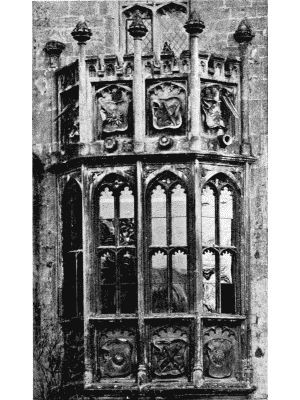
Fig. 111. Oriel window in the Deanery at Wells with badge of King Edward IV, and rebus of Dean Gunthorpe.
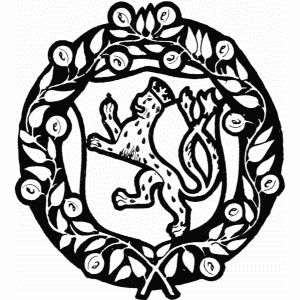
Fig. 112. Arms and rebus of Sir John Pechey (ob. 1522), from painted glass in Lullingstone church, Kent.
Here again it is needless to multiply examples of rebuses, but the fun to be got out of them is ample justification for urging their adoption and use in connexion with decorative heraldry.[7]
[7] The Rev. E. E. Dorling has taken for his rebus a little door (doorling!) with the hinges ending in E's, and the author of this book might fitly content himself with the anchor of Hope!
CHAPTER VIII
SUPPORTERS
The probable Origin of Supporters; Quasi-Supporters; True Supporters: their Introduction; Supporters of Crested Helms; Pairs of Supporters; Dissimilar Supporters; The use of Supporters by Ladies; Other ways of supporting Shields.
The misuse of crests to which reference has been made unfortunately does not stand alone, for modern artists are quite as much at fault with regard to the proper treatment of supporters.
There can be little doubt that these charming adjuncts to heraldic compositions originated with the seal engravers, in their desire to fill up the vacant space in a round seal between the shield and its surrounding margin. In the oldest examples this was done by adding scrollwork or leafage, but in the seal of Humphrey Bohun earl of Hereford, 1220, the large shield of his arms is flanked by two smaller shields of his other earldom of Essex. The same[Pg 194] treatment occurs in the seal of his grandson, another Humphrey Bohun earl of Hereford and Essex, 1298-1322 (pl. XIX B). Henry de Laci (1257) has the side spaces filled by two small wivers, and in the seal of Stephen Longespee (ob. 1260) the shield is flanked by two long swords (pl. XIX A). Gilbert of Clare earl of Gloucester (1262) has his shield hung on a peg and accompanied by two lions back to back, while in the seal of Edmund earl of Cornwall (1272) and son of Richard king of the Romans the shield is held up in the beak of an imperial eagle splayed or spread out behind it. Thomas earl of Lancaster (1296) on both his larger and his lesser seals has the shield flanked by two wivers, as has also his brother Henry of Lancaster (1298) (fig. 60).
Sometimes the shield is hung about the neck of a bird (fig. 113), or about a beast, as in the seal of Alan la Souche, which likewise has the shield surrounded by a number of lions (fig. 114).

Fig. 113. Seal of John de Moun with the shield slung from an eagle and flanked by two leopards. From the Barons' Letter.
During the first half of the fourteenth century little definite progress was made towards true supporters. Shields, whether hung from pegs or upon trees, or surmounted by crested helms, still continued[Pg 195] to be flanked by quasi-supporters, which of course varied much in character. Pairs of wivers, dragons, and lions, usually back to back, the better to fit the space, and sometimes with entwined tails, were common early in the century, and shields with splayed eagles behind may not infrequently be found (figs. 115, 116). What may be regarded as true supporters appear on the lesser seal (pl. XII A) of William Montagu earl of Salisbury (circa 1337), wherein two griffins seem to be holding up the shield, but it is not until well on in the second half of the fourteenth century that further definite instances become fairly common.
Interesting transitional usages may also be found. Thus on a seal (c. 1350) of Margaret Graunson two wivers uphold by their beaks the upper corners of a shield of her husband's arms, while a third wiver similarly grips the point. Guy de Bryen (c. 1350) has his shield hung upon a tree and supported at the corners by two wivers holding it by their beaks. Another lady, Joan FitzAlan, who married in 1362 Humphrey Bohun earl of Hereford, has an impaled shield of their arms held up in their beaks by two Bohun swans; and another pair of swans perform the same office in a FitzWarin seal used in 1398-9 (pl. XX A).

PLATE XX.—Shields with supporters.
- A Ivo FitzWarin, in 1398-9.
- B Peter de Mauley, in 1379-80.
- C Sir Bartholomew Burghersh, 1397-8.
- D John la Warre, in 1390.
A curious variant from the ordinary flanking pair of beasts occurs on the seal of Edmund Mortimer earl of March (1360-81), where the arms are accompanied[Pg 198] by a pair of lions with their heads covered by large helms with the earl's crest, a bush of feathers rising from a crown. A similar treatment is to be seen on a seal of John la Warre, as used in 1390 (pl. XX D).
Analogous cases will be noted on the seal of Sir Robert de Marni (1366) (fig. 64), whose shield hangs from a tree and is flanked by two fronting helms with tall pairs of wings rising from caps of estate as crests; also in a seal of Sir Bartholomew Burghersh (1397-8), which has the shield flanked by two helms crested with tall soldans' heads, and surmounted by what is probably his badge, a swan with a lady's head (pl. XX C). A seal of Sir Roger Scales (1369-86) has his seal flanked by two long-necked wivers, and hung by a strap from another wiver which has twisted itself into the shape of the letter S, and perched itself on the upper edge of the shield.
Another case of true supporters is afforded by a seal of Peter de Mauley in 1379-80, where a shield surmounted by a fierce dragon (perhaps a badge) is upheld by small lions (pl. XX B). Other supporters of shields only may be seen on seals of Thomas Beauchamp earl of Warwick (1369),[Pg 199] where they are bears; and of Roger Mortimer earl of March and Ulster (1381), where they are lions, as is also the case in a seal of John Batour used in 1418-9. In each of these cases the shield is hung upon a tree.
In heraldic representations where the shield of arms is surmounted by a helm and crest, there is the same hesitation in arriving at true supporters; the space at the sides being filled at first by a badge or such device. Thus John of Gaunt duke of Lancaster (in 1362) introduced a pair of eagles with hanging locks in their beaks, and his brother Edmund of Langley duke of York (in 1385) followed suit with a couple of falcons having in their beaks scrolls with scriptures (pl. XXI). John Nevill lord of Raby and seneschal of Bordeaux (1378) flanked his arms, etc. with two letters b, while his kinsman, Sir William Nevill, used in 1390 a seal with his arms and crested helm accompanied by two large stars.
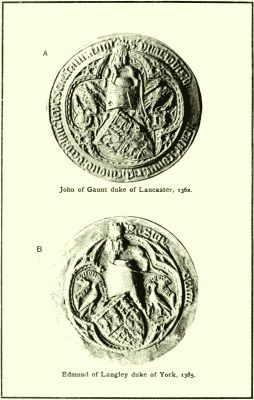
PLATE XXI.—Shields accompanied by Badges.
- A John of Gaunt duke of Lancaster, 1362.
- B Edmund of Langley duke of York, 1385.
The fine seal of Thomas lord Despenser (before 1397) has on either side of his shield and crested helm a tree from which hangs a lozenge of arms: the one bearing the three cheverons of Clare, for his lordship[Pg 200] of Glamorgan; the other the forked-tailed lion of the barony of Burghersh, which came to him through his mother (pl. XXII A). Richard Nevill earl of Salisbury in 1429 similarly places two angels bearing shields: one with the arms of Nevill, the other with the lions of Longespee in virtue of his earldom of Salisbury (pl. XXII B). Henry of Lancaster (afterwards King Henry IV) as earl of Derby, etc. (c. 1385) flanks his arms and crested helm with two ostrich feathers entwined with a scroll with the scripture souvereyne (pl. XXIV C), and others of the royal house similarly used ostrich feathers of other forms. Edward V as prince of Wales in 1471 flanked his arms with two scrolled ostrich feathers standing on large York roses. Thomas duke of Exeter (1416) placed a swan on either side of his armorial achievement, and William lord Lovel and Holand (1423) a hanging lock (pl. XXIII A); while Sir John Pelham (c. 1430) flanked his crest with his buckle badge (pl. XXIII B). On the fine seal of Thomas lord Roos of Hamlake or Helmsley (1431-64) his peacock crest is flanked by two large flowering plants, perhaps hemlocks (pl. XXIII E).
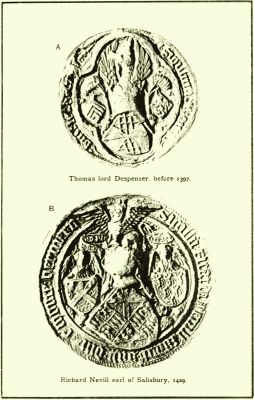
PLATE XXII.—Quasi-supporters.
- A Thomas lord Despenser, before 1397.
- B Richard Nevill earl of Salisbury, 1429.
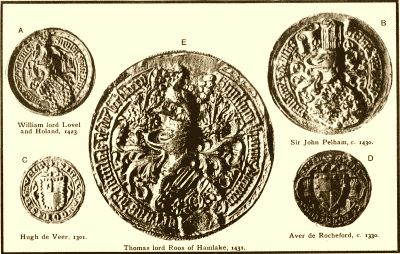
PLATE XXIII.—Shields accompanied by badges.
- A William lord Lovel and Holand, 1423.
- B Sir John Pelham, c. 1430.
- C Hugh de Veer, 1301.
- D Aver de Rocheford, c. 1330.
- E Thomas lord Roos of Hamlake, 1431.
By the third quarter of the fourteenth[Pg 201] century the combination of supporters with shields of arms surmounted by crested
[Pg 202] helms had become fully established, and henceforth the number of beautiful and instructive examples is so great that it is unnecessary to do more than illustrate a typical series (figs. 117-121). It will be seen from these that in seals the majority of the supporters are upholding the heavy helm and its crest, and not the shield that hangs below it; probably on account of the nature of the design. The supporters, too, usually form pairs, and it goes without saying that every variety of creature is made to serve. Sometimes they are composed of badges, like the falcons on crooked billets[Pg 203] used by William lord Zouch (pl. XXIV A), or the similar birds with 'words' coupled with oak leaves and the letter t that appear on a seal of Sir John Falstaff used in 1456 (pl. XXIV B). William lord Botraux, in a seal used in 1426, has his armorial ensigns flanked by two buttresses (Fr. botreaux); while John lord Talbot and Furnival (1406) has two talbots (fig. 122), and George duke[Pg 204] of Clarence (1463) the black bulls of Clare (fig. 123).
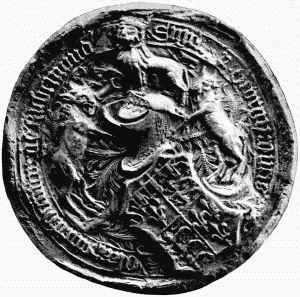
Fig. 123. Seal of George duke of Clarence and lord of Richmond, 1462, with black bulls of Clare supporting his crested helm.
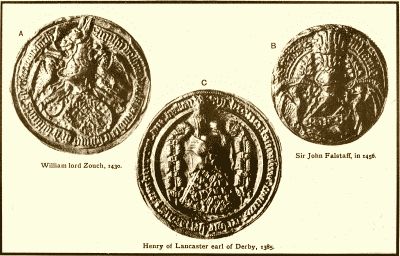
PLATE XXIV.—Shields accompanied by badges.
- A William lord Zouch, 1430.
- B Sir John Falstaff, in 1456.
- C Henry of Lancaster earl of Derby, 1385.
Where the supporters differ it is usually the case that they represent more than one dignity. Thus on one of his seals (fig. 124) Richard Beauchamp earl of Warwick (1401) used as such for supporters two muzzled bears hugging ragged staves, but on a later seal[Pg 205] (1421) as earl of Warwick and of Albemarle the supporters are a bear and a griffin (fig. 125). So, too, his successor in the title of earl of Warwick, Richard Nevill, on a fine seal (c. 1451-2) has two muzzled bears for supporters, but on a later seal (c. 1460) as earl of Warwick and Salisbury his supporters are a Warwick bear and a Montagu griffin (fig. 69). Edmund Beaufort duke of Somerset on his seal for the town of Bayeux (c. 1445) (fig. 126) has on one side his own eagle supporter, and on the other a spotted dog-like beast with a crown about his neck;[Pg 206] and Richard duke of York and earl of March on his seal as governor of France and Normandy in 1436 has for supporters the York falcon and the white lion of March. On the stall-plate of John Beaufort duke of Somerset and earl of Kendal his arms are supported by a Somerset crowned eagle and a mysterious beast called a yale,[8] behind each of which stands an ostrich feather with the quill gobony of blue and silver.
It is not necessary here to cite the various supporters borne by the Kings of England, but it may suffice to point out that since the union of the crowns of England and Scotland one of the royal supporters has always been a lion for England and the other a unicorn for Scotland.
In seals of married ladies in which their arms are accompanied by supporters, one often represents the husband and the other the lady's family.
Thus Joan Holand, daughter of Thomas earl of Kent, and wife of Edmund of Langley duke of York, has (after 1393) her[Pg 207]
[Pg 208] husband's half of her impaled shield supported by the falcon of York, and her own half by her father's hind with its crown collar. Cecily Nevill, the wife of Richard duke of York and earl of March, and mother of King Edward IV, has the shield on her fine seal ensigned by a falcon of York and supported by a stag with crown-collar and chain and by a lion of March (fig. 127). The even more splendid seal of Elizabeth Wydville, queen-consort of King Edward IV, shows as her supporters the[Pg 209] lion of March and a lean spotted beast not unlike an otter, collared and chained (pl. XXV). The lady Margaret Beaufort, on the other hand, ensigns on both her seals her paternal arms of Beaufort with the Somerset eagle and uses for her supporters a pair of yales (pls. XXVI, XXX).
It is of course all-important that sup[Pg 210]porters should be shown standing upon something solid, and not on so precarious a footing as the edge of a motto or forked scroll. One of the beautiful armorial groups with the supporters of King Henry VII in King's college chapel at Cambridge (fig. 128) shows how effectively and yet unobtrusively this may be done. In the splendid panel at New Hall in Essex with[Pg 211] the crowned arms, etc. of King Henry VIII his dragon and greyhound supporters stand in a bush of roses and pomegranates (fig. 189); and in the well-known glass at Ockwells the supporters have fields full of flowers to stand on.
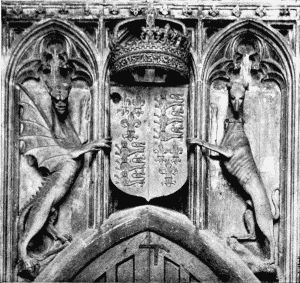
Fig. 128. Arms and supporters, a dragon and a greyhound, of King Henry VII in King's college chapel at Cambridge.
Besides the more or less regular use of supporters just described, there are a number of curious and irregular ways of supporting shields. These deserve special attention, not only from their value in showing how delightfully heraldry used to be played with, but as precedents for similar variety of treatment at the present day, when supporters so-called often do not support anything. Over the doorway, for example, of the National Portrait Gallery in London the 'supporters' of the royal arms are merely a pair of cowering beasts at the base of the shield.
Quite an early instance of playful treatment is furnished by the seal of Roger Leybourne (ob. 1284). This has a small banner standing behind the shield, which is hung on a tree with side branches; one of these supports the crested helm, and the other ends in a bunch of leaves (pl. XI A).
Thomas lord Holand and Wake (c. 1353) has within a traceried panel a tree[Pg 212]
[Pg 213] standing in a rabbit warren and supporting his crowned helm with its huge bush of feathers. Hanging on either side are two shields, one with beautiful diapering of his lordship of Wake, the other (originally) of his lordship of Holand (pl. XXVII A).
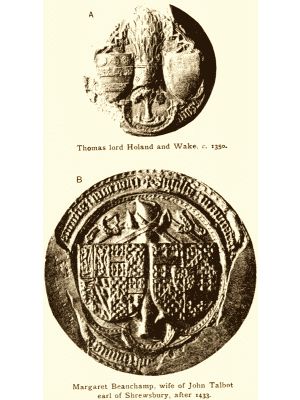
PLATE XXVII.—Methods of arranging shields.
- A Thomas lord Holand and Wake, c. 1350.
- B Margaret Beauchamp, wife of John Talbot earl of Shrewsbury, after 1433.
Thomas of Woodstock duke of[Pg 214] Gloucester, son of Edward III, used from about 1385 a lovely seal with the stock of a tree standing within a paling and surrounded by water on which float two chained Bohun swans, for his wife Eleanor Bohun; from the tree hangs a large shield of the duke's arms, with his crested helm above, and from two side branches are suspended diapered shields of the earldom of Hereford (azure two bends, one gold, the other silver), also in reference to his Bohun marriage.
Margaret daughter of Richard Beauchamp earl of Warwick, and wife of John Talbot earl of Shrewsbury and Waterford, in her fine shield (after 1433) suspends by their straps her father's shield and the impaled shield of her husband and herself from the ragged staff of her father's house (pl. XXVII B).
Thomas Holand earl of Kent used in 1398 a seal bearing his badge of a white hind with a crown for a collar, reclining under a tree, and with the shield of his arms hanging round its neck (pl. XVIII B).
In the fourteenth century seal of the mayoralty of Calais a boar has a cloak tied about his neck and flying upwards banner-wise to display the arms of the town, which[Pg 215] were barry wavy with a crowned (?) leopard rampant (fig. 129). A similar treatment occurs on the half-florin of King Edward III, which has for device a crowned sitting leopard with a cloak about his neck with the royal arms.
On one of his seals as regent of France (1422-35) John duke of Bedford has an eagle standing with one leg upon his badge, the root of a tree, and holding in its other claw a shield of his arms.
William lord Fitz Hugh (1429) and of Marmion shows on his seal his quartered shield ensigned by his helm and crest,[Pg 216] which was apparently a lion's head. The rest of the beast is somewhat incongruously squatting behind the shield and has the paws thrust out on each side to grasp two banners of arms that complete the composition (pl. XXVIII A).
A similar pair of banners appears on the seal of Walter lord Hungerford, which has the shield 'supported' by two Hungerford sickles, and surmounted by the crested helm, with flanking banners of the arms of the lordships of Heytesbury and Hussey (fig. 130).

PLATE XXVIII.—Examples of banners of arms.
- A William lord FitzHugh (1429) and of Marmion.
- B Margaret lady Hungerford and Botreaux, 1462.
Banners also figure prominently on the charming seal of Margaret lady of Hungerford and Botreaux (1462) (pl. XXVIII B). She was the daughter of William lord Botreaux and Margaret Beaumont, and wife of Sir Robert Hungerford, who died in 1459. The seal shows the lady in her widow's dress 'sitting upon her knees' in a garden, and reading from a book some words which are inscribed on a scroll about her head. Overshadowing her are two large banners of impaled arms: one of Hungerford and Botreaux, upheld by a lion; the other of Botreaux and Beaumont, upheld by a griffin.
On many late thirteenth and early fourteenth century seals it was not uncommon to represent ladies holding up shields of arms. A delightful example that may be cited is that of Emmeline FitzGerald, and wife of Stephen Longespee, who is upholding her father's shield in her right and her husband's in her left hand. Below each shield is a leopard of England to show her husband's close relationship to the royal house, and on each side of her is a long sword. She died in 1331 (pl. XXIX B).
A few cases occur where a man himself acts as the supporter of his arms. One[Pg 218] of the shields of Henry Percy earl of Northumberland (1377) shows him in armour, standing behind a large shield of Percy which he supports with his left hand. His right is upon the hilt of a sword with the belt wrapped about it, and against his left shoulder rests a banner with the Percy lion. The earl appears in similar fashion in another of his seals as lord of Cockermouth (1393). In this the shield is quarterly of Percy and Lucy, and is grasped as before by his left hand, while the right holds up a pennon charged with his badge of a crescent (pl. XXIX A).
It must suffice to quote one last piece of playfulness, a seal of Richard duke of York and earl of March and Ulster (ob. 1460) as justice-in-eyre of the forests. This has his shield of arms suspended about the neck of a York falcon, and enclosed by the horns of a buck's head in base, in reference to his office. Upon the buck's horns are fixed two small hands for the duke's earldom of Ulster (pl. XXIX C).
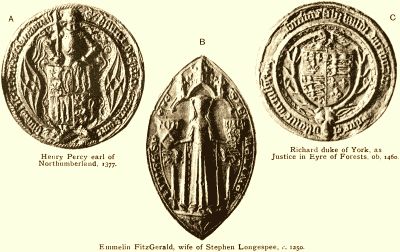
PLATE XXIX.—Ways of upholding shields.
- A Henry Percy earl of Northumberland, 1377.
- B Emmelin FitzGerald, wife of Stephen Longespee, c. 1250.
- C Richard duke of York, as Justice in Eyre of Forests, ob. 1460.
[8] For a full account of the yale or eale see papers in the Archæological Journal, lxviii, 173-199. The adoption of the beast by the duke of Somerset has not yet been explained, but it may be for his earldom of Kendal and partly be a rebus (Kend-eale).
CHAPTER IX
BANNERS OF ARMS
The Royal Banner of Arms; the Banner of the Arms of the City of London; Shapes of Banners; Sizes of certain Banners; Upright versus Long Banners; Advantages of the upright form; Banners with Achievements of Arms; Modern Use of Banners.
Representations of banners constantly occur in medieval pictures (fig. 131); and, as has been shown above, they are not infrequent upon seals.
Every one is familiar with the banner of the royal arms that betokens the presence of the King, and with our splendid national banner known as the Union Jack. The banner with the arms of the city that is flown above the Mansion House when the lord mayor is in residence is familiar to Londoners, and the citizens of Rochester are equally accustomed to see the banner of their city flying on Sundays and holidays from the great tower of their castle. Let a banner once be regarded in the light of a rectangular shield[Pg 220] and its fitness to contain armorial bearings immediately becomes apparent. The King's banner is now always miscalled 'the royal standard,' even in official language, though heraldically it is not a standard at all, but simply a banner.
Medieval banners at first were oblong in shape, and set upright with a longer side next the staff. In the late thirteenth century pictures formerly in the painted chamber in the palace of Westminster the banners borne by the knights were more than twice as tall as they were broad. The same proportion survives even in the famous pictorial pageant of Richard Beauchamp earl of Warwick, drawn about 1493;[9] but the majority of the banners therein shown have a height one and[Pg 222] three-quarter times the width, which is better for the display of heraldry. This is also the proportion of the banners on William lord Hungerford's seal (fig. 132), but the banners with impaled arms on lady Hungerford's seal are nearly square (fig. 133). On the monument in Westminster abbey church of Lewis lord Bourchier (ob. 1431) the large quartered banners at the ends, upheld by lions and eagles, are slightly less than a square and a half in area, and admirably proportioned for displaying arms (fig. 134). The banner of King Edward IV,[Pg 223]
[Pg 224] 'which also hung over his grave' in St. George's chapel in Windsor castle, is described as of 'Taffaty, and thereon painted quarterly France and England; it had in breadth three foot four inches, besides a Fringe of about an inch broad, and in depth five foot and four inches, besides the Fringe.'[10] Ashmole, in his description of the banners hung above the stalls of the Knights of the Garter, states (in 1672) that 'the fashion of the Soveraign's and all the Knight-Companions Banners are square; but it doth no where appear to us, of what size their Banners anciently were; yet in Queen Elizabeth's Reign, we find them two yards and a quarter long, and a yard and three quarters broad, beside the Fringe (which is made of Gold or Silver and Silk, of the colours in the Wreath) and thereon are wrought or beaten upon Taffaty-Sarcenet, double-Sarcenet, or rich Taffaty, with fine Gold and Colours, on both sides, the paternal Coat of the Knights Companion, together with his Quarterings, or so many of them as he please to make use of, wherein Garter is to take care that[Pg 225] they be warrantly marshalled.... These Banners of Arms are fixed to the end of long Staves, painted in Oyl, formerly with the Colours of the Wreath, but now Red.'[11]

Fig. 134. Tomb of Lewis Robsart lord Bourchier, K.G. (ob. 1431), in Westminster abbey church, with banners of arms upheld by supporters.
The remark here as to the quarterings, in view of the comments upon them in an earlier page of this book, is interesting, but it is more important to note that both the banner of King Edward IV, and those of the Knights of the Garter in Queen Elizabeth's time, were of similar proportions to those on the Bourchier monument.
The fact is that the heraldic draughtsmen of even this late period were fully as aware as their predecessors of the difficulty of drawing arms in a banner that exceeded the width of a square, and they also appreciated the greater advantage of an area that was narrower than that figure.
The longer form of banner may be tolerated for so simple a combination as the Union Jack, or even for such of its component parts as the cross of St. Andrew or the saltire of St. Patrick, but it is rarely possible so to arrange heraldry upon it as[Pg 226] to look well, and even the cross of St. George looks better upright thus
 than
than 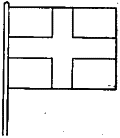 when extended unduly horizontally.
when extended unduly horizontally.
In the King's banner as at present borne it is practically impossible to draw the arms artistically, or with a proper balancing relation of field and charge (fig. 135). The leopards of England may be so outrageously lengthened and attenuated as nearly to fill the quarters allotted to them, but it is impracticable to display properly the upright form of the ramping lion of Scotland or to expand horizontally the Irish harp. In the banner, too, of the lord mayor of London as used on the Mansion House to-day, the sword of St. Paul in the quarter can only be drawn of the comparative size of Sir William Walworth's dagger, which it is in consequence so absurdly mistaken to be.
Were, however, the King's arms (see frontispiece) and those of his city of London placed on upright oblong or even square banners, all difficulties of drawing them would be avoided, and from appearing to be glaring examples of mean modern heraldry they would forthwith become fine pieces of artistic decoration.
A close approximation to the better way of displaying the King's arms is illustrated by the lately adopted banners of Queen Mary and Queen Alexandra, both of which show the Sovereign's arms impaling those of his consort. The King's arms are thus restricted to half the usual length of the present 'royal standard,' that is, to a square, and so can be drawn with less waste space on either side of the charges.
Whatever be their shape, banners, like shields, ought as a rule to be covered completely with the heraldry, like the banners of the Knights of the Garter at Windsor (which, though modern, are quite good in this respect) and those of more recent institution of the Order of St. Michael and St. George in St. Paul's cathedral church.
Examples are not lacking, even in the fifteenth century, of banners charged with regular heraldic achievements instead of[Pg 229] arms, and quite an interesting series may be found among the Windsor stall-plates. Two small oblong plates of Sir Peter Courtenay and Henry lord FitzHugh are practically complete banners of their arms, but Walter lord Hungerford (after 1426) displays his arms, with helm, crest, and mantling, upon a dull black banner with fringed gold border attached to a writhen gilded staff (fig. 136). Richard Nevill earl of Salisbury (c. 1436) (fig. 137), John earl of Shrewsbury (c. 1453), John lord Tiptoft (c. 1461), and several others have their arms, etc. on plain gold-coloured fringed banners, but Richard lord Rivers (c. 1450), Thomas lord Stanley (c. 1459), and George duke of Clarence (c. 1461) have the field worked all over with decorative scroll-work. Sir John Grey of Ruthin (c. 1439) also displays his arms on an undoubted banner with black ground and gold fringe and staff (fig. 138), and William lord Fauconberg (c. 1440) on a banner with the field bendy of blue and silver, with a gold fringe and staff. It is not improbable that several other quadrangular stall-plates with coloured grounds represent banners. Edmund of Langley duke of York has the field paly of three pieces of silver, green, and black; John duke[Pg 230] of Bedford (1422-3) has a ground party blue and silver, and Thomas duke of Exeter (c. 1422) a ground all black.[Pg 231] John duke of Somerset (c. 1440) has the field of his plate bendy of silver, red,[Pg 232] and green, with a gilded border of scrolled leaves; and Walter lord Mountjoy (c. 1472)[Pg 233] disposes the same three colours in vertical stripes.
Two similar displays of heraldic achievements are to be found in a manuscript at the Heralds' College.[12] In one of these the arms, etc. of Sir Richard Nanfant (ob. 1506-7) are painted upon a quadrangular field party of blue and green. In the other the impaled shield of Sir Richard and his dame, upheld by an angel, is painted upon a ground having the upper three-fourths red and the fourth part pale pink.[13]
In modern practice there is no conceivable reason why banners for the display of arms should not be more widely adopted; not only as banners proper, to fly upon a staff, but in decorative art, such as painting, sculpture, and embroidery. Both the Royal Society and the Society of Antiquaries regularly notify their existence in Burlington House by displaying banners of their arms over their apartments, and their example is one that might be followed by other corporations entitled to bear arms. On the use of banners by individuals it is unnecessary to enter after the useful series[Pg 234] of examples and usages thereof already noted.
The curious flags known as standards, which were in use during the fifteenth and sixteenth centuries, seem to have been borne simply for display in pageants or at funerals. For decorative purposes they are most effective, and as they were anciently borne by men of every degree down to and including esquires, they might with much advantage from the artistic standpoint again be devised and brought into use.
A standard (fig. 139) was a long narrow flag with the lower edge horizontal, and the upper gradually descending from the staff to the extremity, which was split into two rounded ends. A compartment next the staff always contained the arms of St. George.[Pg 235] The rest of the ground not infrequently was formed of two, three, or four horizontal stripes of the livery colours of the owner, and divided into three sections by two slanting bands with his word, reason, or motto. Upon the section next to the St. George's cross was generally displayed the principal beast or other device of the bearer and in later times the crest on a torse, while the other sections and the field in general were powdered with badges or rebuses. The whole was fringed of the livery colours.
The series illustrated in the volume in the De Walden Library on "Banners, Standards, and Badges from a Tudor Manuscript in the College of Arms" will supply ample evidence of the playful composition of ancient standards, and hints as to the way in which they may be invented nowadays.
Pennons were small and narrow flags of varying length, sometimes pointed, sometimes swallow-tailed at the end, fixed below the point of a lance or spear and carried by the owner as his personal ensign (fig. 140). That held by Sir John d'Abernoun in his well-known brass (c. 1277) at Stoke d'Abernoun is short and pointed and fringed, and[Pg 236] bears his arms (azure a cheveron gold). A contemporary illustration of a large and more fluttering form of pennon is to be seen in fig. 141. An example of a pennon charged with a badge, in the shape of the Percy crescent, occurs on the seal of Henry[Pg 237]
[Pg 238] Percy earl of Northumberland, who is shown with it in his hand (pl. XXIX A).
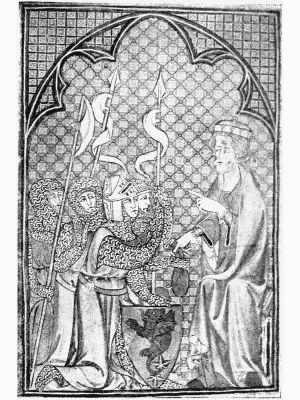
Fig. 141. Armed Knights carrying pennons, temp. Edward I, from an illumination in Arundel MS. 83 f. 132.
In the fifteenth and sixteenth centuries it was not unusual to set up on gables, pinnacles, and other high places figures of animals holding banners as vanes or ornaments. Heraldic beasts as finials began to be used even in the thirteenth century, and an example so early as 1237 is noted on the Pipe Roll of 22 Henry III, when a charge occurs 'for making and setting up a certain lion of stone upon the gable of the King's hall'[14] within the castle of Windsor. Examples of the fourteenth century are hard to find, but in the fifteenth century and first half of the sixteenth they are common enough. In most of these later examples the creatures sit up and support shields with arms or badges; some, like the fine groups at Mapperton in Dorset, once held vanes as well.
Early vanes from their tendency to decay are rare. In 1352-3 14s. were spent 'upon a vane of copper painted with the king's arms, bought to be put upon the top of the hall of the king's[Pg 239] college'[15] in Windsor castle; and a delightful example, also of copper, pierced with the arms of Sir William Etchingham, its builder (ob. 1389), still surmounts the steeple of Etchingham church in Sussex (fig. 142). A simple specimen of an iron vane may yet be seen on Cowdray House in the same county. The octagonal steeple of Fotheringay church, Northants, built at the cost of Richard duke of York c. 1435, is surmounted by a fine representation in copper of his badge, the falcon within a fetterlock.
The employment of a creature to hold up a banner of arms was already no novelty in the fifteenth century, and examples have been noted above of those on the tomb of Lewis lord Bourchier (ob. 1431) and on the seal of Margaret lady Hungerford (c. 1460); to which may be added the banner-bearing lion on the seal (c. 1442) of Henry Percy, eldest son of Henry second earl of Northumberland. The conversion therefore of the sitting beast into a vane-holder came about quite naturally. A good instance of the end of the fifteenth century forms a charming finial to the well-[Pg 240]
[Pg 241]known kitchen at Stanton Harcourt in Oxfordshire, but the griffin which sits aloft there has, alas, no longer a vane to hold (fig. 143).
Quite an array of such vane-holders was set up early in the sixteenth century upon the pinnacles of the nave clerestory of St. George's chapel in Windsor castle, and the contract made in 1506 for completing the quire in like fashion provides for 'as well the vautte within furth as archebotens, crestys, corses, and the King's bestes stondyng on theym to bere the fanes on the outside of the said quere, and the[Pg 242] creasts, corses (and) beasts above on the outsides of Maister John Shornes Chappell.' The contract made in 1511 for finishing the adjacent Lady chapel also includes 'making up crests, corses, and the King's bestes stondyng on theym to bere furth squychons with armes.' These beasts holding their glittering vanes seem to have been completed only so far as the great chapel was concerned, and are plainly shown in Hollar's engraving of the building; but they were all taken down in 1682 by the advice of Sir Christopher Wren, who suggested that pineapples be set up in their stead!
Another mention of figures with vanes occurs in the contract made in 1546 for the building of the Coventry cross:
And further to set on every principall pinnacle in the lowest story of the same new Crosse, the Ymage or a Beast or a foule, holding up a fane, and on everie principall pinnacle in the second story the image of a naked boy with a Targett, and holding a Fane.[16]
These beasts, fowls, and boys obviously[Pg 243] performed a double duty, like the creatures on Mapperton manor-house.
The exact nature of the 'King's bestes' at Windsor and elsewhere is illustrated by the accounts for the building of the great hall of Hampton Court in 1533-4. These include payments 'for the workyng and makyng of a lyon and a dragon in stone, standyng at the Gabull ends of the said hall'; 'for two pynnys of irne for stayes for the two bests of freston, standyng at the gabyll endes of the haull'; and 'for gylding and payntyng of two vanys, servyng the bests of freston stondyng at the endes uppon the haull, oon of the Kynges armys, the other of the Quenys, wrowghte wyth fyne golde and in owyle.' Further payments are 'for makyng of 29 of the Kynges bestes to stand upon the new batilments of the Kynges New Hall, and uppon the femerell of the said Hall' and 'for 16 vanys for the bestes standyng upon the battylment of the hall.' Also 'for the payntyng of 6 great lyons, standyng abowght the bartyllment, of tymber worke, uppon the Kynges New Hall, theyre vaynys gylte with fyne golde and in oyle,' and for the painting 'of 4 great dragons & of 6 grewhounds servyng the same barttylment.'
There are also payments to a 'Karver, for karvyng and coutting of 2 grewhondes, oon lybert, servyng to stande uppon the typpis of the vycys abowght the Kynges new haull,' and to a 'paynter, for gyldyng and payntyng of 2 grewhondes, oon lybert, syttyng upon basys baryng vanys, uppon the typys at the haull endes'; likewise 'for gyldyng and payntyng of 24 vanys with the Kynges armes and the Quenes badges.'[17]
The free use of external colouring should be noted.
The use of the King's beasts as heraldic adjuncts was not confined at Hampton Court to the building only, but they were made to do duty, in an equally delightful manner, as garden decorations. Thus the payments already quoted include charges
for makyng and entaylling of 38 of the Kynges and the quenys Beestes, in freeston, barying shyldes wythe the Kynges armes and the Quenys; that ys to say, fowre dragownes, seyx lyones, fyve grewhoundes, fyve harttes, foure Inny[Pg 245]cornes, servyng to stand abowght the ponddes in the pond yerd;
for cuttyng and intayling of a lyon and grey-hound in freestoon, that is to say, the lyon barying a vane with the Kynges armes, &c. servyng to stand uppon the bases of freeston abought the ponds;
for pynnes servyng the pyllers of freestoon that the beastes standyth uppon abowght the ponds in the pond yerd;
for payntyng of 30 stoon bests standyng uppon bases abowght the pondes in the pond yerd, for workmanship, oyle, and collers. Also
for payntyng off 180 postes wyth white and grene[18] and in oyle ... standyng in the Kynges new garden;
also for lyke payntyng of 96 powncheones wyth white and grene, and in oyle, wrought wyth fyne antyke uppon both the sydes beryng up the rayles in the sayd Garden;
also for lyke payntyng of 960 yerdes in leyngthe of Rayle.[19]
The quaint aspect of such an heraldic garden has been preserved to us in the[Pg 246]
[Pg 247]
[Pg 248] large picture at Hampton Court itself of King Henry VIII and his family. This has at either end archways in which stand Will Somers the King's jester and Jane the fool, and behind them are delightful peeps of the garden, with its low brick borders carrying green and white railings, and its gay flower beds from which rise tall painted posts surmounted by the King's beasts holding up their glittering vanes (figs. 144, 145).
Before finally leaving the subject of banners, a few remarks may be offered touching our beautiful national banner which we call the Union Jack.
This charming and interesting composition is not only, in a large number of cases when it is flown, displayed upside down, but in a still greater number of instances it is made quite incorrectly.
The first Union Jack, that in use from 1606 to 1801, combining as it did only the cross of St. George for England and the saltire of St. Andrew for Scotland, presented little difficulty, since there was practically no excuse for not drawing the St. Andrew's cross straight through from corner to corner. But the present Union Jack is a much more difficult banner to[Pg 249] draw, as well as to understand, and the prevailing ignorance of its history even among so-called 'educated' people is extraordinary.
The Union Jack consists actually of (i) the banner of St. George with its white field reduced to a narrow edging on all sides of the red cross, to enable it to be superposed, without breaking the heraldic rule of colour upon colour, upon (ii) the blue banner of St. Andrew with his white cross; but since the Union with Ireland there has been combined with these (iii) the banner of St. Patrick, which has a red saltire upon a white field. This combination, in order to meet Scottish susceptibilities, has been effected in a very peculiar but ingenious way, first by treating the Irish banner like that of England, and reducing its white field to a narrow edging about the saltire, and then by slitting this down the middle of each arm, and joining the pieces to the opposite sides of St. Andrew's saltire similarly treated, yet so that the Scottish pieces are uppermost next the staff. It thus comes about that whatever be the shape of the flag, whether square or oblong, two straight lines drawn across it diagonally from corner to corner[Pg 250] should always equally divide the Scottish and Irish crosses, and if this cannot be done the flag is not correctly built up (pl. XXXI).
It also happens that unless the flag is exactly square the blue sections of the field must differ more or less in size. Ignorant flag-makers try to correct this, but only by dislocating in the middle the diagonal lines that ought always to be straight and continuous.
The right way up of a Union Jack is indicated by the Scottish, that is, the broader white, half of the diagonal members being always uppermost in the two pieces next the staff.
[9] Brit. Mus. Cott. MS. Julius E. IV.
[10] Elias Ashmole, The Institution, Laws and Ceremonies of the most Noble Order of the Garter (London, 1672), 149.
[11] Ibid. 335, 336.
[12] MS. M 3.
[13] Illustrated Catalogue of the Heraldic Exhibition, Burlington House, 1894 (London, 1896), pl. xxviii.
[14] 'Et in quodam leone de petra faciendo et erigendo super gabulum in eadem aula.'
[15] 'Et in una vane de cupro picta de armis Regis empta ad ponendum super summitatem aule Collegij Regis ibidem, xiiij s.' Pipe Roll, 28 Edward III.
[16] T. Hearne, Liber Niger, ii. 620.
[17] Ernest Law, The History of Hampton Court Palace (London 1903), i. 346-8.
[18] White and green were the livery colours of King Henry VIII.
[19] Law, op. cit. i. 370, 371.
CHAPTER X
MARSHALLING OF ARMS
Arms of husband and wife; Dimidiating; Impaling; 'Scutcheons of Pretence; Impalement with Official Arms; Arms of ladies; Heraldic Drawing; Mottoes; Use and Misuse of the Garter; Lettering and Mottoes.
In gathering up for practical consideration some of the points already discussed, as well as others that are suggested by them, something may first be said on the ways of combining the arms of husband and wife. This was done originally by simply setting them side by side, a plan which of course may still be followed whenever it is thought desirable.
For a short time during the latter part of the thirteenth and beginning of the fourteenth century the arms of husband and wife were combined in one shield by the curious device of halving or 'dimidiating' them, by joining the half of the one to the opposite half of the other, as in the arms of Aymer of Valence and Mary de Seynt Pol,[Pg 252] still borne (since 1347) by the lady's foundation of Pembroke college at Cambridge. Owing however to the many inconveniences which this plan involved, it was soon exchanged for the more simple way of 'impaling' or placing the entire arms of both parties side by side in one shield (fig. 146 and pls. VIII C, XVIII A, B), a practice that has continued ever since,[Pg 253] except when the wife is an heiress. In that case the lady's arms are usually drawn upon a smaller shield and placed upon the middle of the husband's arms (pl. V A). This ugly and most inconvenient plan, though of considerable antiquity, might very well be amended by the more ancient way of quartering the arms together, as is still done by the children of the heiress. For rules for the combination of the arms of a husband who has married two or more wives, or the cumbrous regulations as to quartering, the student may, if he wishes, consult the various manuals of heraldry.
When a man is a member of any Order, such as the Garter or the Bath, only his own arms should be encircled by the insignia of the Order. Exceptions to this rule can of course be found, but it is otherwise a general one that ought strictly to be followed. Bishops are entitled to bear their personal arms only impaled with those of their bishopstool or cathedral church, and the same rule applies to deans, heads of colleges, and regius professors (like those at Cambridge) who have official arms. The chancellor of a University presumably may impale its arms with his own.
It has already been shown that the arms of ladies, all through the medieval period, were borne in precisely the same way as their fathers' or their husbands', that is, upon a shield, lozenge, or roundel, and that the present inconvenient restriction to a lozenge did not come into use much before the middle of the sixteenth century, when heraldry and heraldic art were already on the down-grade. The present custom seems to be for the arms of married ladies to be borne upon shields, and of widows and spinsters upon lozenges. From the artistic standpoint it would certainly be desirable, whenever it is thought advisable, to revert to the freedom of pre-Elizabethan times.
Enough has already been said as to the elasticity of drawing shields, helms, crests, and mantlings, and as to the proper use of supporters, but a few words may be added as to the proper way of drawing the various creatures that are used in heraldry.
Since heraldry is a survival of what was once a living thing, it is clear that if modern work is to look well, animals and birds ought to be drawn in a more or less conventional manner (figs. 148, 149). Some, such as elephants, dogs, falcons, etc. may be drawn[Pg 255] almost directly from nature; but others, especially lions, if so represented, would manifestly be unfit to consort with the leopards, the wivers, the griffins, the two-headed eagles, and other delightful creatures of the early heralds which they borrowed from the bestiaries. The conventional treatment should not, however, be carried to excess, nor should natural forms be too closely copied. Here, as in other matters connected with heraldry, a comparative study of good ancient examples will soon show what are the best types to follow.

Fig. 149. Shield of the arms of Sir Humphrey Littlebury, from his effigy at Holbeach in Lincolnshire, c. 1360, with fine examples of heraldic leopards.
It would be an advantage, too, if artists would revert to the old ways of representing the furs known as ermine and vair. The ancient ermine tails did more or less resemble the actual tail of an ermine, but[Pg 257]
[Pg 258] the modern object with its three dots above has no likeness to it whatever (fig. 150). So too with regard to vair, which represents the skins of grey squirrels, the modern treatment of it as rows of angular eighteenth century shields is far removed from the conventional forms of the real skins seen in the best old work (fig. 151).
It has already been pointed out that there are no strict rules as to the particular shades of colour allowable in heraldry, and[Pg 259] it is one of the surprises of the student to find what dull and cold tones were anciently used that yet look quite right. The apparently bright reds, for example, of the enamel in the early stall-plates at Windsor are actually brick-colour, and the apparent fine blues a cold grey; but their combination with gilding and silvering makes all the difference in the ultimate beautiful rich effect.
One thing that ought to be most scrupulously avoided in all modern heraldic decoration is the indicating of the gilding and colouring by the pernicious 'dot-and-dash' system. This is all very well as a kind of shorthand in one's own notes or memoranda, but it is utterly destructive of artistic effect if applied in actual work. Ancient shields in relief were no doubt invariably painted, like those still to be seen behind the quire at Westminster; but let any one try to imagine the fine series at York or St. Albans scored and pecked to indicate the colour and gilding. If the heraldic carvings are not to be painted, at any rate do not let their surfaces be disfigured. They may always be relieved by diapering.
The treatment of mottoes may not, at[Pg 260] first sight, seem to fall within the scope of this work, but actually it is one of very real importance. There is much to be said for the theory that mottoes are derived from the war cries of early times, and hence their frequent association with the crest worn upon the helm. Reference has already been made to examples upon seals and other authorities. The association of a motto with a shield only was not common anciently, and when it is so found it is generally placed on a scroll, like the well-known examples on the tomb of Edward prince of Wales at Canterbury (fig. 85). In later times, when shields began to be encircled by the Garter of the famous Order (fig. 152), mottoes were often arranged about the shield in a similar way.
There was however always this very important and noteworthy difference and distinction, that the buckled band now so commonly used for mottoes was anciently never allowed for any but the motto of the Order of the Garter. Other mottoes were written on a band which was fastened in a different way, or merely disposed Garter-wise round the shield.
The earliest known representation of the Garter is on a singular lead or pewter medal[Pg 261]lion (fig. 153) commemorative of Edward prince of Wales, first Prince of the Order, now in the British Museum. In this the prince is kneeling bare-headed before a personification of the Holy Trinity, with his gloves on the ground before him, and an angel standing behind him and holding his crested helm. The whole is enclosed by a buckled band inscribed hony soyt ke[Pg 262] mal y pense, with a cloud overlapping its upper margin, from which issues an[Pg 263] angel holding down the prince's shield of arms.
It has been customary from within a few years of the foundation of the Order in 1348 for the Knights-Companions to encircle their personal arms with the Garter.
In a wardrobe account of King Edward III, from 14th February 1349-50 to 30th September 1351, payments are entered for the making 'of two pencells of sindon de Triple, each having in the midst a Garter of blue sindon with a shield within the same Garter of the King's arms quartered, and beaten throughout the field with eagles of gold'; but representations of such a usage are hard to find. A good early example is afforded by the monumental brass at Trotton in Sussex of Thomas lord Camoys (ob. 1419) (fig. 154).
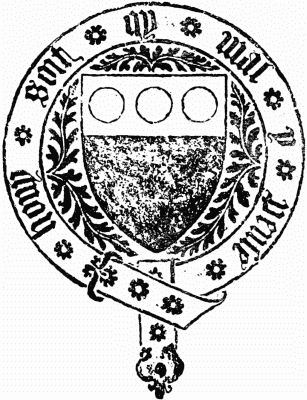
Fig. 154. Shield of arms (a chief and three roundels on the chief) encircled by the Garter, from the brass of Thomas lord Camoys (ob. 1419).
In illustration of the care above referred to of distinguishing the Garter motto from any other, two concrete examples may be cited: one on the brass at Constance of Robert Hallam bishop of Salisbury (ob. 1416), where the King's arms are encircled by the Garter, and the bishop's own arms by an open scroll with a scripture (fig. 155); the other on the west porch of the cathedral church of Norwich, where the arms of King[Pg 264] Henry VI have the Garter about them, and the arms of the builder of the porch, bishop William Alnwick (1426-36), are surrounded by a scroll with his motto.
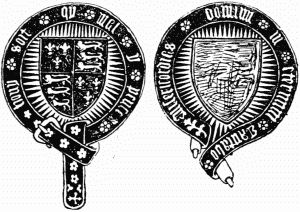
Fig. 155. Shields encircled by the Garter and a scroll, from the brass of Bishop Hallam (ob. 1416) at Constance.
This distinction was carefully borne in mind when the insignia of British Orders, other than that of the Garter, were devised, and in every case their mottoes are displayed on plain and not buckled bands. In the[Pg 265] Albert Medal for Bravery, however, the encircling motto has been most improperly placed on a buckled band like the Garter, and the people who supply 'heraldic stationery' are notorious offenders in the same direction.
The lettering of a motto must of course depend upon the circumstances of its use. Nothing looks so well as the so-called 'old-English' or small black-letter, especially if the height of the words is as nearly as possible the same as the width of the band or scroll, and the capitals are not unduly prominent; but the form of capital known as Lombardic is always preferable to those of the black-letter alphabet. When[Pg 266]
[Pg 267] capitals alone are used, fanciful types should be avoided; a good Roman form such as is often found in Tudor inscriptions being far better. If the motto to be set about a shield is a short one it can often be extended conveniently, if necessary, by a[Pg 268] judicious use of ornamental devices like roses or other flowers between the words. The ends of scrolls with mottoes have a more satisfactory appearance if shown partly curled up and partly pulled out spirally than if forked and waved, as may so often be seen nowadays. Scrolls always look better if not bordered or edged in any way, but this does not apply to the narrow bounding line that may be necessary in enamelled work.

Fig. 156. Royal arms of King Henry VII within the Garter, of English work, from the King's tomb by Torregiano at Westminster.
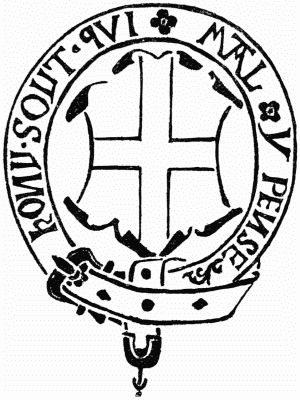
Fig. 157. Arms of St. George within the Garter, from the brass of Sir Thomas Bullen, K.G. earl of Wiltshire and Ormond, 1538, at Hever in Kent.
CHAPTER XI
CROWNS, CORONETS, AND COLLARS
Crowns and Coronets; Introduction of Coronets; Coronets of Princes, Dukes, and Earls; Bequests of Coronets; Illustrations of Coronets and Crowns; Collars and Chains; Collars of Orders; Lancastrian Collars of SS; Yorkist Collars of Suns and Roses; Tudor Collars of SS; Other Livery Collars; Waits' Collars; Collars and Chains of Mayors, Mayoresses, and Sheriffs; The Revival of Collars; Inordinate Length of modern Collars.
At the present day it is the habit of divers ladies of rank to surmount their hair, when occasion allows, with diamond tiaras of surpassing splendour. The ladies of olden time were not free from a similar weakness, but the diamond mines of South Africa being then unknown, and other gems too costly, they encouraged the goldsmiths to make them beautiful crowns and crestings, with which they adorned their heads and headgear. A reference to the accurate drawings and details published by Stothard in his Monumental Effigies will show not only[Pg 270] the high artistic excellence of these ornaments, but also how becoming they were to the ladies who wore them. They varied greatly in design, from the simple circlet of fleurons and trefoils of Queen Eleanor of Castile (fig. 158) to the sumptuous piece of jewellery beset with pearls and stones, which is represented on the alabaster effigy of Queen Joan at Canterbury (fig. 159) and reflects so worthily the yet more splendid crown of her husband, King Henry IV (fig. 173).
Attention has already been drawn to the decorative use of crowns in heraldry, and a reference promised to the coronets of peers and peeresses.
Coronets, as they are now called, originated as early as 1343, when Edward duke of Cornwall and earl of Chester was created Prince of Wales, and invested by his father with a circlet (sertum) on his head, a gold ring on his finger, and a golden verge which[Pg 272] was placed in his hand. The circlet in question passed into the possession of his brother, Lionel duke of Clarence, who in 1388 left in his will 'a golden circlet with which my brother and lord was created prince' as well as 'that circlet with which I was created duke.' This latter event happened in 1362, at the same time that his brother John of Gaunt was created duke of Lancaster, when King Edward girded his son with a sword and put upon his head a fur cap and over it 'un cercle d'or et de peres,' a circlet of gold and precious stones. This investiture with a coronet was for some time restricted to dukes, but in 1385 King Richard II bestowed upon Richard earl of Oxford the new dignity of marquess of Dublin, and invested him with a sword and a circlet of gold.
The investing of an earl with a coronet does not seem to have become customary before the reign of Edward VI, but earls had worn coronets in virtue of their rank for a long time previously. In April 1444, when Henry Beauchamp earl of Warwick was created premier earl by Henry VI, the letters patent of his appointment empower him 'to wear a golden circlet upon his head and his heirs male to do the same on[Pg 273] feast days in all places where it is convenient as well in our presence as of others.' But the practice can perhaps be carried still further back, for Selden in his Titles of Honour (p. 680) quotes a receipt dated 1319 by William of Lavenham, treasurer of Aymer of Valence earl of Pembroke, of 'a gold crown of the said earl.'
By his will dated 1375 Richard FitzAlan earl of Arundel leaves to Richard his son 'my best crown (ma melieure coroune) charging him upon my blessing that he part not with it during his life, and that after his death he leave it to his heir in the same manner to descend perpetually from heir to heir to the lords of Arundel in remembrance of me and of my soul.' He also leaves to his daughter Joan 'my second-best crown' and to his daughter Alice 'my third crown,' under similar conditions. The earl's best crown may be that shown upon the alabaster effigy at Arundel of his grandson Thomas earl of Arundel; to whom it was bequeathed by his father (fig. 163). It has alternate leaves and pearled spikes, similar to, but richer and better in design than, the earls' coronets of to-day. Sir N. H. Nicolas suggests that earl Richard's second and third coronets were bequeathed to his daughters[Pg 274] because both were countesses; Joan being wife to Humphrey Bohun earl of Hereford, and Alice to Thomas Holand earl of Kent.
There are other bequests of coronets to ladies: Edmund Mortimer earl of March and Ulster left in 1380 to his daughter Philippa, afterwards wife to (1) John[Pg 275] Hastings earl of Pembroke, (2) Richard earl of Arundel, and (3) John lord St. John, 'a coronal of gold with stones and two hundred great pearls (un coronal a'or ove perie et deuz cents grands perles) and also a circlet with roses, with emeralds and rubies or Alexandria in the roses (un cercle ove roses emeraudes et rubies d'alisaundre en les roses).' Michael de la Pole earl of Suffolk also left in 1415 to his wife Katherine the diadem or coronet which had belonged to her father Hugh earl of Stafford, who died in 1386.
The swan's head crest of Richard Beauchamp earl of Warwick (ob. 1439) on his effigy at Warwick is encircled by a crown of stalked pearls, not unlike those of an earl's coronet of the present day (fig. 160).
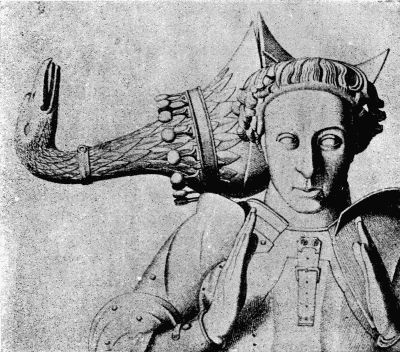
Fig. 160. Helm and crest, and bust, of Richard Beauchamp, earl of Warwick (ob. 1439,) from his gilt-latten effigy at Warwick.
Among Stothard's engravings are two of effigies of quite early date of ladies wearing crowns or coronets. One, at Scarcliffe in Derbyshire (fig. 161), cannot be later than about 1250, and the crown in this case is composed of some twenty simple leaves set upright upon the edge of a narrow band. The other, at Staindrop in Durham, is about a century later, and represents a widowed[Pg 277] lady, probably Margery, second wife of John lord Nevill, wearing a crown of curled leaves with points between (fig. 162). The next illustration is of special interest since it represents Thomas earl of Arundel (ob.[Pg 278] 1416) wearing presumably the coronet mentioned above in his grandfather's bequest (fig. 163); his countess Beatrice has a slighter coronet of similar character. The great alabaster tomb, also at Staindrop, or Ralph earl of Westmorland (ob. 1425) and his two countesses furnishes the next example. In this case the earl is in armour, but both ladies wear delicate coronets, formed of rows of points with triplets of[Pg 279] pearls and intervening single pearls, rising from narrow ornamental circlets (fig. 164).
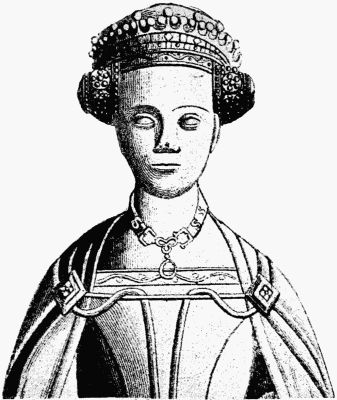
Fig. 164. Joan Beaufort, countess of Westmorland (ob. 1440), from her alabaster effigy in Staindrop church, Durham.
The tomb of another earl of Arundel, William FitzAlan (ob. 1487), and of his countess Joan, further illustrates the use of coronets. The earl's coronet is in this case composed of a continuous row of leaves with a jewelled band (fig. 165); the countess wears a similar coronet, but curiously[Pg 280] distorted behind, evidently because it was thought to be more becoming when so worn (fig. 166).
The monument in St. Peter's church, in Sheffield, of George earl of Shrewsbury (ob. 1538) and his two wives represents him in armour, with the mantle and collar[Pg 281] of the Garter, and a coronet, now broken, about his head. His wives also have coronets, which are happily complete, and are composed of continuous series of twelve short points tipped with pearls. The earl's coronet seems to have had similar points, but with sixteen pearls instead of twelve.
The effigy circa 1500 at Whitchurch in Salop of that famous warrior, John Talbot earl of Shrewsbury, who was killed in 1453, also represents him in the mantle of the Garter over his armour and a coronet about his head. This is unfortunately badly broken, but seems to have resembled that on the Sheffield figures.
Besides these examples of coronets of earls and their countesses a few illustrations of those worn by dukes and duchesses may be cited.
It has been already noted that the shields on the monument of Humphrey duke of Gloucester (ob. 1446) at St. Albans are surmounted alternately by crested helms and by caps with coronets. These coronets have a richly jewelled circlet on which is set, instead of leaves, a series of what seem to be cups full of daisies, with small triplets of pearls between.
Another good coronet is to be seen[Pg 282] on the effigy of Thomas Holand duke of Exeter (ob. 1447) on the monument formerly in St. Katharine's hospital by the Tower, now in the chapel in Regent's Park. The duke's coronet here is quite narrow, and composed of some eighteen or twenty trefoils set close upon a band (fig. 167); but his two duchesses have coronets of triplets of pearls with intermediate single pearls, like those of the countesses of Westmorland at Staindrop (fig. 168).
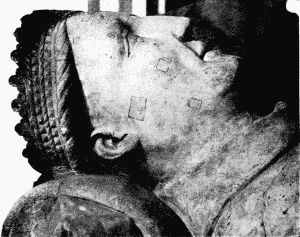
Fig. 167. John Holand duke of Exeter (ob. 1447), from his effigy at St. Katharine's hospital, Regent's Park.
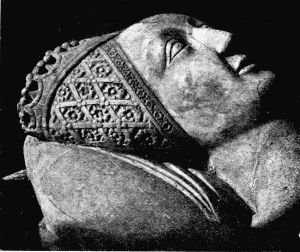
Fig. 168. Head of a duchess of Exeter, from the monument at St. Katharine's hospital, Regent's Park.
The alabaster effigy at Ewelme of Alice, widow of William duke of Suffolk (ob. 1450), shows her in a beautiful coronet of fleurs-de-lis alternating with small clusters of pearls (fig. 169), and similar coronets once adorned the effigies at Wingfield in Suffolk of her son John de la Pole duke of Suffolk (ob. 1491) and his wife Elizabeth.
The privilege of wearing coronets was not extended to viscounts until the reign of James I, and to barons until 1661.
The official patterns of coronets to which peers and peeresses are now restricted have, as may be seen from the examples above cited, practically no relation to the older forms, which exhibited the usual delightful medieval elasticity of design.
The present coronets too are rendered uglier than ever by the modern rule forbidding them to be jewelled in any way. This was not formerly the case. Among[Pg 285] the stuff remaining in the palace of Westminster in 1553, and delivered to lady Jane Grey, was 'a coronet for a duke, set with five roses of diamonds, six small pointed diamonds, one table emerald, six great ballases, seven blue sapphires, and thirty-eight great pearls, with a cap of crimson velvet and a roll of powdered armyns about the same'; and a beautifully ornamented coronet of much earlier date than the painting is shown in a portrait of John marquess of Winchester, the defender of Basing House, who died in 1674.
It is the custom now for ladies of rank to wear their coronets only at coronations, and to display them on their note-paper, their spoons and forks, and on the panels of their carriages and motor-cars. Such coronets cannot however be considered artistic objects, even when depicted apart from the crimson velvet bonnets which they encircle, and there is no reason why ladies should not devise and wear coronet-like ornaments of their own invention.
A little research will show that crowns of every form and fashion have always been freely used in heraldic decoration, both by themselves and as ensigning letters or other devices, and so long as[Pg 286]
[Pg 287]
[Pg 288] care be taken not to infringe what may be called official patterns, there are really no limits to a continuance of the ancient practice.
The lady Margaret Beaufort, countess of Richmond and mother of King Henry VII, has left us a delightful series of coronets. First, on a seal newly made for her on the accession of her son, her shield of arms is ensigned with a coronet or crown of roses and fleurs-de-lis placed alternately along the edge of a narrow band (pl. XXX). Shortly after 1505 the lady Margaret began to build Christ's College at Cambridge, and both the gatehouse (fig. 170) and the oriel of the master's lodge (fig. 171) are rich in heraldic decoration. In this case both her arms and her portcullis badge are ensigned with coronets set with a continuous row of triplets of pearls.[20] In the lady Margaret's later foundation of St. John's College, her arms, etc. again are displayed upon the stately gatehouse; in this case with a coronet of roses and fleurs-de-lis over the shield, as in her seal (fig. 172). Her portcullis badge, on the other hand, has over it a fine coronet[Pg 289]
[Pg 290] formed of clusters of roses, which recalls the circlet of roses set with emeralds and rubies of Alexandria mentioned earlier in this chapter. It is quite easy to conjure up visions of coronets or circlets formed of lilies or marguerites, or of roses red and white, or of any other suitable flower or device, wrought in gold or gilded silver, and either jewelled or bright with enamel. And let designers take heart when so recent and yet so picturesque an object as the so-called 'naval crown' can be produced, with its cresting of sterns and square sails of ships. This was used most effectively some years ago as one of the decorations encircling the Nelson Column in London on Trafalgar Day.
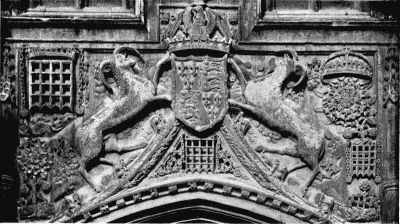
Fig. 170. Armorial ensigns and badges of the lady Margaret Beaufort, from the gatehouse of her foundation of Christ's College, Cambridge.

Fig. 171. Arms of the foundress, the lady Margaret Beaufort, with yale supporters, from the base of an oriel in Christ's College, Cambridge.
It may be as well to point out that the royal crown has been composed, from the fifteenth century, of crosses alternating with fleurs-de-lis, and since the coronation of King Henry IV it has been distinguished by being arched over cross-wise. The splendid open crown shown on the effigy of the king at Canterbury (fig. 173) is not that wherewith he was crowned, but another worn with the parliament robes in which he is represented. Beautiful examples of crowns of simpler type are[Pg 291] afforded by the effigies of King Henry III (fig. 174) and King Edward II (fig. 175). When the lady Elizabeth Wydville became the queen of Edward IV, she ensigned her arms with a beautiful crown or coronet of alternate large crosses and fleurs-de-lis with smaller fleurs-de-lis between, rising from a richly jewelled band (pl. XXV), and a rich example of the crown of King Henry VIII so treated is to be seen on the great carved panel with his arms, etc. at New Hall in[Pg 292] Essex (fig. 189). Crosses and fleurs-de-lis are now used only in the coronets of those of royal blood.
From ornaments for the head it is easy to pass to those for the neck.
The wearing about the neck of something which was considered decorative or becoming has been customary with the fair sex in every part of the world and in all ages of its history, and necklaces of every form, material, and fashion are as popular to-day as ever. But less attention is now[Pg 293] paid to the decorative collars that once were worn not only by women but by men.
It has always been a mark of distinction or dignity to wear about the neck a chain or collar of gold, silver, or silver-gilt, either as an ornament, or a decoration of honour, or as a badge of partizanship; and the most noteworthy of these to-day are the collars of the various orders of Knighthood, such as the Garter (fig. 177), the Thistle, and the Bath.
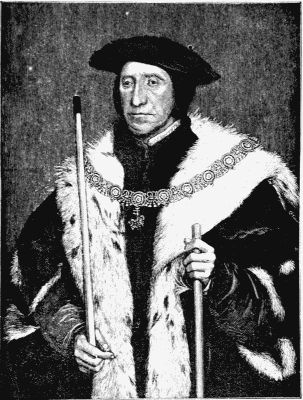
Fig. 177. Thomas Howard third duke of Norfolk (1473(?)-1554) with the collar of the Order of the Garter, from the picture by Holbein at Windsor castle.
The history and characteristic features of these are well known, and representations of them abound; moreover the wearing of them is confined to a few privileged persons. It is therefore hardly necessary to discuss them further in a work like the present.
The case is however different with regard to the so-called livery collars, since these may properly be regarded as models[Pg 295] for the formation and construction of such similar collars as may freely be worn to-day.
The most notable of such decorations during the medieval period was the collar of SS which formed the distinctive cognisance of the House of Lancaster (figs. 178, 179). It was worn by persons of every degree, from the King and Queen to the knight and his esquire, and it was likewise worn by their wives and even conferred on civilians.

Fig. 178. Collars of SS.
1. From the brass of Lady Camoys, 1419, at Trotton in Sussex.
2. From the brass of Sir William Calthorpe, 1420, at Burnham Thorpe in Norfolk.
The collar of SS was apparently invented[Pg 297] by King Henry IV before his accession, and quite a number of important entries that throw light upon its history occur in his household accounts while he was only Henry of Lancaster earl of Derby.
In 1390-1 a gold signet was engraved for him 'cum j plume et j coler,' of which unhappily no impressions are known. In 1391-2 there was made for him a 'coler' of gold 'with seventeen letters of S after the manner of feathers with scrolls and[Pg 298] scriptures in the same with a swan in the tiret.' This recalls the badge upon one of Henry's own seals as earl of Derby (1385) described above (p. 167), an ostrich plume entwined with a scroll and the scripture souvereyne (pl. XXIV C), and we know from other sources of Henry's favour towards the Bohun swan, which device he used in right of his first wife, the lady Mary Bohun. The collar of SS, moreover, on the effigy of John Gower the poet (ob. 1402) in Southwark cathedral church has a swan on the pendant of it, and no doubt represents the collar actually given to him by Henry of Lancaster in 1393-4. The initial letter, too, of the charter granted to the city of Gloucester by Henry as King in 1399, contains a crown encircled by a collar of SS ending in two lockets between which is a pendant charged with a swan. The earl's accounts for 1393-4 mention the purchase of the silver 'of a collar made with rolled esses and given to Robert Waterton because the lord had given the collar of the same Robert to another esquire.'
In 1396-7 a charge is entered 'for the weight of a collar made, together with esses, of flowers of soveigne vous de[Pg 299] moy[21] hanging and enamelled weighing eight ounces.'
What these flowers were is uncertain. Charges for making 'flores domini' occur in 1390-1 and other years, and in 1391-2 three hundred leaves (?flowers) de souveine vous de moy of silver-gilt were bought for one of the earl's robes.
In 1407 Henry of Lancaster as King ordered payment to be made to Christopher Tildesley, citizen and goldsmith of London, of the huge sum of £385 6s. 8d. 'for a collar of gold worked with this word soveignez and letters of S and X enamelled and garnished with nine large pearls, twelve large diamonds, eight balases, and eight sapphires, together with a great nouche in manner of a treangle with a great ruby set in it and garnished with four large pearls.'[22]
Most of these entries suggest that the mysterious SS stand for Soveignez, and possibly at one time this was the case, but[Pg 300] Henry's seal as earl of Derby in 1385 containing the feathers with the scripture souvereyne must not be overlooked. There is moreover, on a fragment which has fortunately survived in a tattered and burnt mass of fragments of a jewel account of Henry's reign in the Public Record Office, the important entry of a payment to Christopher Tildesley of 'a collar of gold made for the King with twenty-four letters of S pounced with soverain, and four bars, two pendants, and a tiret with a nouche garnished with a balas and six large pearls (the balas bought of the said Christopher for £10 and the price of the pearls at 40s., being £12) weighing 7 oz. Troy at 23s. 4d. £8 3s. 4d. Also a black tissue for the same collar 3s. 4d. and for the workmanship of it £4.'[23] The King's word soverayne also occurs many times, with the Queen's word a temperance, on the tester over their monument at Canterbury, which has likewise the shield of arms for the King, the King and Queen, and the Queen alone, encircled in each case with a collar of SS with golden eagles placed upon the tiret. Gold eagles also form stops between the repetitions of the word soverayne.
Another example of a collar of SS with an eagle as a pendant is to be seen on the monument of Oliver Groos, esquire (ob. 1439), in Sloley church, Norfolk (fig. 180).

Fig. 180. Spandrel of the tomb of Oliver Groos, Esq. (ob. 1439), in Sloley church, Norfolk, with collar of SS.
Examples of effigies in stone or brass of men and women wearing the collar of SS are common throughout the Lancastrian period. The SS seem in most cases to be represented as sewn or worked upon a band of silk, velvet, or other stuff,[24] which usually ends in buckled lockets, linked by a trefoil-shaped tiret, from which is hung a small ring (fig. 181).
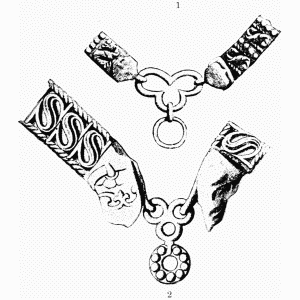
Fig. 181. Collars of SS from (1) the effigy of Queen Joan at Canterbury, and (2) the effigy of Robert lord Hungerford at Salisbury.
Several other interesting occurrences of the collar of SS may be noted. In one of the windows in the chapter house at Wells is a shield of the arms of Mortimer, and next to it a gold star within the horns of a crescent party blue and silver, encircled by a collar of SS also half blue and half white. As there are associated with these the arms of the King and of Thomas duke of Clarence (ob. 1421), they probably commemorate Edmund Mortimer earl of March, who died in 1425.
In 1449 a receipt given to the steward of Southampton by the prior of the Shene Charterhouse, which was founded by King Henry V, bears a seal with ihs within a collar of SS; and in St. Mary's church at[Pg 303] Bury St. Edmunds the ceiling over the tomb of John Baret, an ardent Lancastrian, who died in 1480, is painted with collars of SS surrounding his monogram.
There is also in a MS. in the British Museum,[25] written probably for John lord Lovel (ob. 1414), a painting of the arms of Holand quartering Lovel surrounded by a collar, one half of which is white and the other half blue, with gold letters of SS, having for a pendant a gold fetterlock, party inside of red and black.
On a brass c. 1475 at Muggington in Derbyshire the Beaufort portcullis appears as a pendant to the collar of SS.
With the rise to power of the Yorkists on the accession of Edward IV a rival collar to that of the Lancastrian livery came into vogue, composed of blazing suns and York roses disposed alternately (fig. 182). It may be seen in various forms on a number of monumental effigies and brasses, usually with the couchant white lion of the house of March as a pendant, but on the accession of Richard III the lion was replaced by his silver boar. On the wooden Nevill effigies at Brancepeth the earl has a collar of rayed suns with the boar pendant, while the countess has a collar of alternate suns and roses. Joan countess of Arundel, on her effigy at Arundel (fig. 166), shows another variation by interpolating the[Pg 305] FitzAlan oak leaves between the suns and the roses.
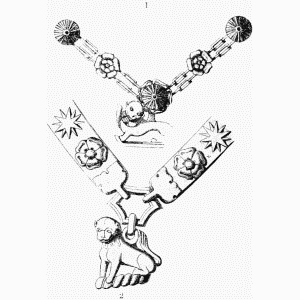
Fig. 182. Collars of suns and roses from (1) the effigy of a knight of the Erdington family at Aston, Warwickshire, and (2) from the effigy of Sir Robert Harcourt, K.G. 1471, at Stanton Harcourt, Oxon.
After the accession of Henry VII the collar of SS was again revived, but with variations and different pendants. The effigy, for example, at Salisbury of Sir John Cheyney, K.G. (ob. 1489), has appended to his SS collar a large portcullis charged with a rose. A collar of gold weighing over 7 ounces is recorded to have been given in 1499 to adorn the image of the Holy Trinity in Norwich cathedral church, and is described as containing twenty-five letters of S, two tirets, two 'purcoles' (portcullises), and one double R(?) with a red rose enamelled.[26] A similar collar, but all of gold, is shown in the portrait of Sir Thomas More, painted by Holbein in 1527 (fig. 183). On a brass c. 1510 at Little Bentley in Essex the collar of SS has a portcullis pendant, and on the Manners effigy (c. 1513) at Windsor and the Vernon effigy (1537) at Tong the pendant to the knight's collar is a large double rose.
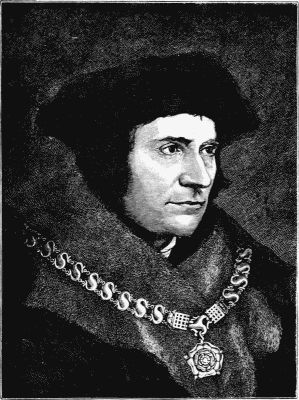
Fig. 183. Sir Thomas More wearing the collar of SS, from an original portrait painted by Holbein in 1527, belonging to the late Mr. Edward Huth.
The collars on the Salkeld effigies (1501) at Salkeld in Cumberland are composed of SS and four-leaved flowers alternately, and that worn by Sir George Forster (ob. 1526) on his tomb at Aldermaston in Berkshire is of SS laid sideways and alternating with[Pg 307] knots, and has a portcullis and rose pendant. In 1545 Sir John Alen, sheriff in 1518 and[Pg 308] lord mayor in 1525 and 1535, bequeathed for the use of the lord mayor of London, and his successors for ever, his collar of SS, knots, and roses of red and white enamel; and a cross of gold with precious stones and pearls was given to be worn with it in 1558. An effigy of a Lisle c. 1550 at Thruxton in Hants has a similar collar of SS, knots, and roses, also with a cross as a pendant. Sir John Alen's collar, somewhat enlarged, and with a modern 'jewel' as a pendant, is still worn by the lord mayor of London, and is the only medieval collar of SS that has survived.
After the reign of King Henry VIII the wearing of the collar of SS gradually became restricted to judges and other officials, and has so survived to the present day, when it is still worn in England by the lord chief justice, the kings-of-arms, heralds, and pursuivants, and by the serjeants-at-arms.
The lord chief justice's collar, like all those formerly worn by the judges, is composed of SS and knots; the others of SS only.
Beside the livery collars above mentioned, others have been worn from time to time.
In the exquisitely painted diptych or[Pg 309] Richard II and his avowries, now at Wilton House, the King has about his neck a collar formed of golden broom-cods, and the gorgeous red mantle in which he is habited is covered all over with similar collars enclosing his favourite badge, the white hart. A collar of gold 'de Bromecoddes' with a sapphire and two pearls occurs in the great inventory taken on the death of King Henry V, and a collar formed of SS and broom-cods was also made for King Henry VI in July 1426.[27]
On his effigy at Ripon (c. 1390) Sir Thomas Markenfield displays a collar formed of park palings, which widen out in front to enclose a couchant hart (fig. 184). If this were not a personal collar, it may have been a livery of Henry of Lancaster as earl of Derby.

Fig. 184. Head of the effigy in Ripon minster of Sir Thomas Markenfield with livery collar of park-palings.
A brass of the same date of a knight, formerly at Mildenhall, showed him as wearing a collar apparently once composed of scrolls with scriptures, joining in front upon a large crown with a collared dog or other beast within it.
The brass at Wotton-under-Edge of Thomas lord Berkeley (ob. 1417) shows[Pg 310] him with a collar sown with mermaids, the cognisance of his house (fig. 185).
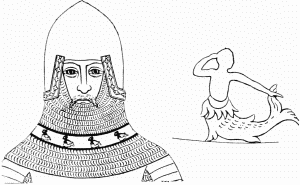
Fig. 185. Thomas lord Berkeley (ob. 1417) with a collar of mermaids, from his brass at Wotton-under-Edge, Gloucestershire.
In his will dated 1430 William Stowe the elder, of Ripon, a retainer in the[Pg 311] household of the earl of Northumberland, bequeaths his silver livery Anglice cressaunt and his livery Anglice coller to the shrine of St. Wilfrid.[28] Possibly the 'cressaunt' was an object similar to that here figured (now belonging to the duke of Northumberland), and the collar like that formed of p's and crescents enclosing p's linked together which is engraved upon it (fig. 186).
The earlier collars, as has already been noted, were composed of devices sewn upon a band of stuff, but in later examples a more open treatment is found wherein the devices are linked together by short pieces of chain, as in the collar of SS shown in Sir Thomas More's portrait. The Yorkist collar of suns and roses on an effigy at Erdington is so treated, as is the collar of SS and flowers on the Salkeld effigies, which may perhaps be a personal and not a livery collar.
Collars of similar construction, but always of silver, with pendent scutcheons of the town arms, were worn by the little bands of minstrels called waits, formerly in the employ of most towns of importance (fig. 187).
In London the six waits appointed in 1475 had silver collars of SS with scutcheons of the city arms. At Exeter the four waits' collars, dating from about 1500, still exist, and are formed of roundels with X's and R's alternately (fig. 187). Two beautiful waits' collars at Norwich (c. 1550) are composed of silver castles and gilded leopards alternately, like those in the appended shield (fig. 187). The waits' collars at Lynn were formed of scrolled leaves alternating with dragons' heads pierced with crosses, like those in the town arms, which are allusive of St. Margaret (fig. 187). At York the collars are formed wholly of little silver leopards, and at Beverley of eagles and beavers alternately. The waits' collars at Bristol date from the reign of Queen Mary, and are composed of pierced roundels containing alternately the letters CB. and a rose dimidiating a pomegranate.
The wearing of collars, or chains as they are called, by mayors, mayoresses, and[Pg 314]
[Pg 315] sheriffs is comparatively modern. It was formerly the custom for every person of any dignity to wear a chain, and it was only when chains began to go out of fashion that the wearing of them survived among persons of particular dignity such as mayors and sheriffs.
The collar of SS worn by the lord mayor of London is an exceptional example, and the only other early mayor's chain is that given to Kingston-on-Hull in 1564 and remade in 1570. A plain gold chain was bequeathed to the city of York in 1612, and 'a fayre chayne of gold double linked with a medall of massy gold' was given to the town of Guildford in 1673. In 1716 a gold chain for the mayor was given to the city of Norwich, but passed on for the use of the deputy mayor on a new chain being given in 1757. Yarmouth bought itself a chain in 1734, and seven other towns became possessed of mayors' chains towards the end of the eighteenth century. Down to 1850 some fifteen more mayors' chains came into existence, mostly of simple type, like the older chains, with one or more rows of plain or ornate links. Since 1850 practically every town that can boast of a corporation has likewise got a[Pg 316] chain for its mayor, and appalling creations many of them are, with rows of tablet links, and armorial pendants as large as saucers.
A simple gold chain to be worn by the sheriffs of Norwich was given in 1739, but those at Chester, Newcastle, Exeter, and other places are quite recent. In London it has been the custom for the friends and admirers of the sheriffs to present them with elaborate gold collars on their accession to office, but these are happily private property and not official insignia. The same description applies to them as to the recent mayors' chains.
Chains for mayoresses have not yet become general, but they are being multiplied yearly. The mayoress of Kingston-on-Hull had an official chain as early as 1604, but it was sold as being 'useless' in 1835. The lady mayoress of York has a chain of plain gold links given in 1670, which is regularly weighed on its delivery to and return by the wearer. All other mayoresses' chains are quite recent, and in most cases of the same fearsome design as those worn by their husbands.
The unfortunate mayors, mayoresses, and sheriffs are practically at the mercy of ignorant and inartistic tradesmen for the[Pg 317] designing and making of the collars they are called upon to wear officially, but that is no reason why people with more enlightened ideas should not invent, design, and wear collars or chains that are beautiful in themselves. The examples already quoted and the many illustrations of others that are accessible will show what comely ornaments the old heraldic collars were, and many a lady would look well in a collar to whom a necklace is most unbecoming. Flowers, letters, and devices of heraldic import can easily be embroidered in gold, or struck out of metal and enamelled, and then be sewn down on velvet or silk stuff, or linked together by fine chains.
But let every wearer of a chain or collar avoid the error of making it too long. The ancient collars were quite short, and therefore rested comfortably and easily upon the shoulders. Official collars have however grown to so preposterous a length that they have to be tied with bows of ribbons upon the shoulders to hinder them from slipping off the wearer altogether! The reason of this is curious and instructive. The old collars were, as aforesaid, of sensible dimensions, but the introduction[Pg 318] of wigs in the seventeenth century necessitated the collars being lengthened to be worn outside them. Wigs had their day and at last disappeared from general wear, but the lengthened collars remain, and it has not occurred to any one in authority that they might now advantageously be shortened. So the inconvenience goes on.
[20] On the gatehouse the coronet over the arms has been restored.
[21] In 1426 Sir John Bigod lord of Settrington left to his daughter a covered cup 'pounset cum sovenez de moy'; perhaps a gift to him from Henry of Lancaster. Testamenta Eboracensia (Surtees Soc. 4) i. 411.
[22] P.R.O. Issue Rolls (Pells) Mich. 8 Henry IV (1407).
[23] Accounts, Exch. K.R. 404/18.
[24] Notice of the theft of a collar of black silk dotted (stipatum) with silver letters of SS is entered on the Patent Roll of 7 Henry IV (1406), part ii. m. 29.
[25] Harl. MS. 7026, f. 13.
[26] Norwich Sacrist's Register, xi. f. 111.
[27] John Anstis, The Register of the most noble Order of the Garter (London, 1724), ii. 116 note.
[28] 'Item ego liberaturam meam argenteam Anglice cressaunt, et liberaturam meam Anglice coller. ad feretrum Sancte Wilfridi.' Test. Ebor. ii. 13.
CHAPTER XII
HERALDIC EMBROIDERIES
The introduction of armorial insignia in embroidered Vestments: on Robes: on Beds, etc.
No one who has had occasion to examine any series of old wills and inventories, especially those of the fourteenth and fifteenth centuries, can fail to have noticed what a large part was played by heraldry in the household effects of our forefathers. In the vestments and other ornaments of the chapel, the hallings, bankers, and like furniture of the hall, the hangings and curtains of the beds and bedchambers, the gold and silver vessels and utensils of the table, or in carpets and cushions and footstools, shields of arms, badges, mottoes, and quasi-heraldic devices of all sorts were as common as blackberries in autumn.
And the evidence of illuminated pictures and monumental effigies is equally strong in showing that heraldry was quite as much in vogue for personal adornment.
As a matter of fact heraldry had its very[Pg 320]
[Pg 321] origin in a system of devices to be worn on shields and banners and coats-of-arms to distinguish the wearer in battle, and from the coat-of-arms of the knight it was but a step to the armorial gown or mantle of his lady.
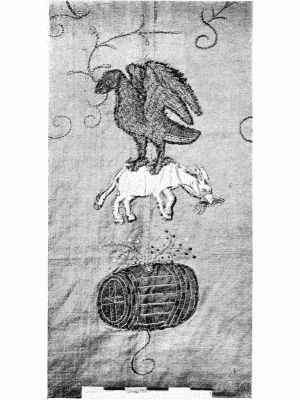
Fig. 188. Part of an embroidered altar frontal with a rebus at Baunton in Gloucestershire: date, late fifteenth century.
It would be somewhat tedious to extract from the authorities just cited, especially since they are easily accessible, every entry relating to an heraldic ornament or piece of furniture. But with regard to hangings and embroideries the case is somewhat different, inasmuch as numbers of ladies are engaged nowadays in stitch-work of every kind, amongst which heraldic embroidery ought certainly to have a place.
As might be expected, the inventories of Church stuffs furnish us with some of the earliest examples of heraldic embroideries, and often in sufficiently precise terms to enable us to realize what the things looked like.
Thus an inventory taken in 1315 of the ornaments at Christchurch, Canterbury, enumerates such things as a chasuble and five copes, the gift of Katharine Lovel, sewn with arms of divers persons; a white cope of the arms of the King of Scotland; a cope of Peter bishop of Exeter[Pg 322] (ob. 1291) of baudekyn 'with biparted shields' (an early example); a cope of John of Alderby bishop of Lincoln, and another of Thomas Burton bishop of Exeter, of green cloth embroidered with shields; an albe with apparels of blue velvet embroidered with shields and fleurs-de-lis; two albes sewn with shields and black letters, and a third of red samite embroidered with shields and popinjays; an albe sewn with lozenges with the arms of the King of England and of Leybourne; an albe sewn with shields and embroidered with letters; an albe sewn with the arms of Northwood and Poynyngs in quadrangles; and an albe, stole, and fanon sewn with divers arms in lozenges with purple frets. The same inventory mentions a vestment of Philip King of France, made, quite properly, of blue cloth with fleurs-de-lis; and a number of vestments with orphreys of the arms of the King of England and of France.
The inventory of the vestry of Westminster Abbey taken in 1388 also contains some interesting heraldic ornaments, such as a frontal with the arms of England and France in red and blue velvet woven with golden leopards and fleurs-de-lis, from the[Pg 323] burial of King Edward III; six murrey carpets woven with the new arms of the King of England and of the count of Hainault (in other words, the quartered shield adopted by Edward III in 1340, and the arms of his queen, Philippa of Hainault); four carpets of the arms of the earl of Pembroke; four carpets of red colour woven with white shields having three red fleurs-de-lis, of the gift of Richard Twyford, whose arms they were; five black carpets having in the corners shields of the arms of St. Peter and St. Edward; two green silk cloths sewn with the arms of England, Spain, and Queen Eleanor; a bed with a border with the arms of the King of Scotland; three new copes of a red colour of noble cloth of gold damask, with orphreys of black velvet embroidered with the letters T and A and swans of pearl, the gift of Thomas duke of Gloucester, whose wife was Eleanor Bohun, and her family badge a white swan; a cope of red velvet with gold leopards and a border of blue velvet woven with gold fleurs-de-lis, formerly the lord John of Eltham's, whose fine alabaster tomb in the abbey church has the same arms on his shield.
A St. Paul's inventory of 1402 also[Pg 324] contains a few choice examples: a cope of red velvet with gold lions, and orphreys of the collars of the duke of Lancaster and a stag lying in the middle of each collar; a suit of blue cloth of gold powdered with gold crowns in each of which are fixed two ostrich feathers; six copes of red cloth of gold with blue orphreys with golden-hooded falcons and the arms of Queen Anne of Bohemia; three albes and amices of linen cloth with orphreys of red velvet powdered and worked with little angels and the arms of England, given by Queen Isabel; three albes and amices with apparels of red cloth of gold powdered with divers white letters of S and with golden leopards, given by John of Gaunt; two great cushions of silk cloth of blue colour with a white cross throughout, and in each quarter of the cross the golden head of a lion.
The secular documents carry on the story.
Some quite noteworthy items may be found in the account of the expenses of the great wardrobe of King Edward III (1345-48-9): for making a bed of blue taffata for the King powdered with garters containing this word hony soit q mal y pense; for making a jupe of blue taffata for[Pg 325] the King's body with Garters and buckles and pendants of silver-gilt; for making 40 clouds for divers of the King's garments, embroidered with gold, silver, and silk, with an E in the middle of gold, garnished with stars throughout the field; for making six pennons for trumpets and clarions against Christmas Day of sindon beaten with the King's arms quarterly; for making of a bed of red worsted given to the lord King by Thomas de Colley powdered with silver bottles having tawny bands and curtains of sindon beaten with white bottles; for making a harness for the lord David King of Scotland of 'blu' velvet with a pale of red velvet and within the pale aforesaid a white rose; for making a harness of white bokeram for the King stencilled with silver, namely, a tunic and shield wrought with the King's word hay hay the wythe swan; by godes soule I am thy man and a crupper, etc. stencilled with silver; for making a doublet for the King of white linen cloth having about the sleeves and bottom a border of green long cloth wrought with clouds and vines of gold and with the King's word it. is. as. it. is.
In 1380 Edmund Mortimer earl of[Pg 326] March leaves 'our great bed of black satin embroidered with white lions (the badge of the house of March) and gold roses with scutcheons of the arms of Mortimer and Ulster'; and in 1385 Joan princess of Wales leaves to King Richard her son 'my new bed of red velvet embroidered with ostrich feathers and leopards' heads of gold with branches and leaves issuing from their mouths.'
In 1389 William Pakington archdeacon of Canterbury leaves 'my halling of red with a shield of the King's arms in the midst and with mine own arms in the corners'; and in 1391 Margaret, the wife of Sir William Aldeburgh, leaves (i) a red halling with a border of blue with the arms of Baliol and Aldeburgh, (ii) a red bed embroidered with a tree and recumbent lion and the arms of Aldeburgh and Tillzolf, and (iii) a green bed embroidered with griffins and the arms of Aldeburgh.
The inventory of Thomas of Woodstock duke of Gloucester, taken in 1397, also contains some interesting items: a white halling (or set of hangings for a hall) consisting of a dosser and four costers worked with the arms of King Edward (his father) and his sons with borders paly of red and[Pg 327] black powdered with Bohun swans and the arms of Hereford; a great bed of gold, that is to say, a coverlet, tester, and selour of fine blue satin worked with gold Garters, and three curtains of tartryn beaten with Garters to match; and a large bed of white satin embroidered in the midst with the arms of the duke of Gloucester, with his helm, in Cyprus gold.
A number of other items in the list are also more or less heraldic: a bed of black baudekyn powdered with white roses; a large old bed of green tartryn embroidered with gold griffins; twelve pieces of tapestry carpet, blue with white roses in the corners and divers arms; a large bed of blue baudekyn embroidered with silver owls and gold fleurs-de-lis; fifteen pieces of tapestry for two rooms of red worsted embroidered with blue Garters of worsted with helms and arms of divers sorts; three curtains of white tartryn with green popinjays; a green bed of double samite with a blue pale (stripe) of chamlet embroidered with a pot of gold filled with divers flowers of silver; an old bed of blue worsted embroidered with a stag of yellow worsted; a red bed of worsted embroidered with a crowned lion and two griffins and chaplets and roses;[Pg 328] a bed of blue worsted embroidered with a white eagle; a coverlet and tester of red worsted embroidered with a white lion couching under a tree; a single gown of blue cloth of gold of Cyprus powdered with gold stags; and a single gown of red cloth of gold of Cyprus with mermaids.
In 1381 William lord Latimer leaves 'an entire vestment or suit of red velvet embroidered with a cross of mine arms,' and in 1397 Sir Ralph Hastings bequeathed 'a vestment of red cloth of gold with orphreys before and behind ensigned with maunches and with colours of mine arms,' which were a red maunch or sleeve on a gold ground.
Among the chapel stuff of Henry Bowet archbishop of York, in 1423, were a sudary or veil of white cloth with the arms of the duke of Lancaster on the ends, and two costers or curtains of red embroidered with great white roses and the arms of St. Peter (the crossed keys).
In 1437 Helen Welles of York bequeathed a blue tester with a couched stag and the reason Auxilium meum a Domino.
In 1448 Thomas Morton, a canon of York, left a halling with two costers of green and red say paled with the arms[Pg 329] of archbishop Bowet; and in 1449 the inventory of Dan John Clerk, a York chaplain, mentions two covers of red say having the arms of Dan Richard Scrope and the keys of St. Peter worked upon them.
To the examples worked with letters may be added a bed with a carpet of red and green with crowned M's, left about 1440 by a Beverley mason, who also had another bed with a carpet of blue and green with Katharine wheels; a vestment left in 1467, by Robert Est, a chantry priest in York minster, of green worsted having on the back two crowned letters, namely, R and E; and a bequest in 1520 by Thomas duke of Norfolk of 'our great hangede bedde palyd with cloth of golde whyte damask and black velvet, and browdered with these two letters T. A.,' being the initials of himself and his wife.
There is of course nothing to hinder at the present day the principles embodied in the foregoing examples, which could easily be extended ad infinitum, from being carried out in the same delightful way; and a small exercise of ingenuity would soon devise a like treatment of one's own arms, or the use of a favourite device or flower, or the[Pg 330] setting out of the family word, reason, or motto.
The medieval passion for striped, paned, or checkered hangings might also be revived with advantage, and the mention in 1391 of 'a bed of white and murrey unded' shows that waved lines were as tolerable as straight.
CHAPTER XIII
TUDOR AND LATER HERALDRY
Decorative Heraldry of the Reign of Henry VIII; The Decadent Change in the Quality of Heraldry; Examples of Elaborated Arms; Survival of Tradition in Heraldic Art; Elizabethan Heraldry; Heraldry in the Seventeenth Century and under the Commonwealth; Post-Restoration Heraldry.
In the foregoing chapters practically nothing has been said or any illustration given of heraldry later than the reign of Henry VIII, chiefly because little that is artistic can be found afterwards. There are however certain points about both Elizabethan and Stewart heraldry that are worthy of notice, especially when the old traditions have been followed.
In the second quarter of the sixteenth century decorative heraldry may be said to have reached its climax, and such examples as can be seen at Hengrave Hall, Hampton Court, Athelhampton House, Cowdray House, St. George's chapel in Windsor Castle, King's College chapel at Cambridge,[Pg 332] and Henry VII's Lady chapel at Westminster, or in the beautiful panel of Henry VIII's arms at New Hall in Essex (fig. 189), are quite the finest of their kind. Then comes a falling off, and though sporadic cases in continuation of tradition may be found, with the advent of the Renaissance English heraldry underwent a complete change.
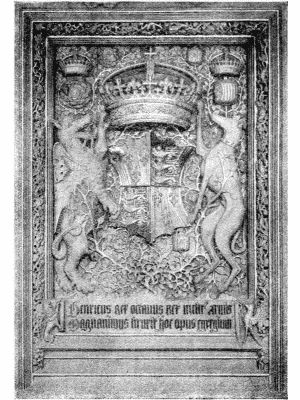
Fig. 189. Carved panel with the crowned arms, supporters, and badges of King Henry VIII at New Hall in Essex.
One of the most notable differences between the older and the later heraldry is in the quality of the heraldry itself.
In the days when men devised arms for themselves these were characterized by a simplicity that held its own all through the thirteenth and fourteenth centuries and well down into the fifteenth century. But following upon a privilege that had hitherto been exercised by the King as a mark of special honour, and in some rare cases even by nobles, the heralds then began to assign arms to such of the newly-rich who came to the front after the Wars of the Roses and were willing to pay for them. Henceforth the artistic aspect of heraldry entered upon a continuous decadent course.
The beginning is visible in the extraordinary compositions devised and granted to all sorts and conditions of men during[Pg 333]
[Pg 334] the reign of Henry VIII. Such arms as had been granted by Henry VI or Edward IV, or even by the kings-of-arms in the fifteenth century, still followed ancient precedent, but the Tudor members of the newly incorporated Heralds' College seem to have struck out a line for themselves.
A notable example is furnished by the arms devised for cardinal Thomas Wulcy. These, in token of his Suffolk origin, have[Pg 335] for basis the engrailed cross upon a sable field of the Uffords (to whom he was not related), charged with the leopards' heads of the de la Poles and a lion passant (perhaps for England); to which is added a gold chief, with a red Lancastrian rose, and two of the Cornish choughs from the posthumous arms of St. Thomas of Canterbury in allusion to his Christian name!
The arms granted by Christopher Barker, Garter, in 1536 to the city of Gloucester afford another example. They consist of the sword of state of the city, with the sword-bearer's cap on the point, set upright on a gold pale, and flanked on either side by a silver horseshoe and a triad of horsenails on a green field; there is also (as in Wulcy's arms) a chief party gold and purple, with the silver boar's head of Richard III (who granted a charter to the city) between the halves of a Lancastrian red rose and of a Yorkist white rose, each dimidiated with a golden sun!
A reference to Bedford's Blazon of Episcopacy will show that the arms of a considerable number of the bishops appointed during the reigns of Henry VIII and Edward VI were characterized by overcharged chiefs like those just described,[Pg 336] and these may be taken as typical of the arms then being granted by the kings-of-arms. The same passion for crowding the shield is seen even in many of the less elaborate arms that were occasionally granted.
Things did not improve under Mary and Elizabeth. Simple arms continued to be issued from the College, but mixed with such extravagant bursts as that of Laurence Dalton, Norroy, who granted in January 1560-1 to the famous physician doctor John Caius these arms:
Golde semyd w^{th} flowre gentle in the myddle of the cheyfe, sengrene resting uppon the heades of ij serpentes in pale, their tayles knytte to gether, all in proper color, resting uppon a square marble stone vert, betwene theire brestes a boke sable, garnyshed gewles, buckles gold, and to his crest upon thelme a Dove argent, bekyd & membred gewles, holding in his beke by the stalke, flowre gentle in propre color, stalked verte, set on a wreth golde & gewles.
This precious composition is further described in the grant as
betokening by the boke lerning: by the ij serpentes resting upon the square marble stone, wisdom with grace founded & stayed upon vertues stable stone: by sengrene & flower gentle, immortality yt never shall fade, etc.
The way in which matters went from bad to worse is shown by the case of the Company of 'Barbours & Chirurgeons' of London, to whom had been granted in 1561
paly argent and vert, on a pale gules a lyon passant gardant golde betweene two Spatters argent on eche a double rose gules and argent crowned golde.
The united genius of Garter, Clarenceux, and Norroy 'improved' these arms in 1569 into:
Quarterly the first sables a Cheveron betweene three flewmes argent: the second quarter per pale argent and vert on a Spatter of the first, a double Rose gules and argent crowned golde: the third quarter as the seconde and the fourth as the first: Over all on a Crosse gules a lyon passant gardant golde.
Such compositions as these could not but[Pg 338] fail to bring heraldry into contempt, and men soon ceased to revel in and play with it in the same delightful way as before. Here and there, as in Sir Thomas Tresham's market house at Rothwell, or in Sir Henry Stafford's great mansion of Kirby Hall, tradition has been held fast, and play is made upon the former with the Tresham trefoils, and in the latter with Stafford knots and with crests treated as badges in quite the old style. At Kirby Hall, despite its date (1572-5), and at Cadhay in Devon, sitting figures of beasts with shields of arms were set upon the gables, and at Kirby upon the pinnacles that surmounted the pilasters about the court. A good panel with the arms and badge apparently of Sir John Guldeford (ob. 1565) is to be seen in East Guldeford church, Sussex (fig. 191).
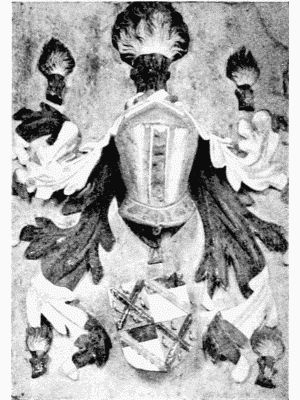
Fig. 191. Arms, with crested helm and badge (a blazing ragged-staff) of, apparently, Sir John Guldeford of Benenden (ob. 1565) in East Guldeford church, Sussex.
A remarkably fine specimen of Elizabethan heraldic decoration is also to be seen in the great chamber of Gilling castle, Yorks, as finished by Sir William Fairfax about 1585. Here the beautiful inlaid wall-panelling is surmounted by a frieze nearly four feet deep, painted with hunting scenes and a series of large trees, upon which are hung according to wapentakes the shields of arms of Yorkshire gentlefolk.[Pg 339] The chimney piece displays the armorial ensigns of the builder, with those of his Queen above, and four other shields, and between the frettings of the plaster ceiling are the Fairfax lions and goats, and the Stapleton talbot. The rich effect of the[Pg 340] whole is completed by the contemporary heraldic glazing with which the windows happily are filled.
But in Elizabethan buildings generally, heraldry made but a poor show. Supporters and other creatures had descended from the gables to stand or squat upon gateposts, and occasionally a square panel filled with heraldry was inset above a doorway or a porch; or the family crest, divorced from its helm, was carved upon the spandrels of the entrance. But the former glory had disappeared, and shields of arms were often replaced by initials and dates of owners and builders, presumably because they were 'non-armigerous persons.'
Within doors matters were somewhat better. Such gorgeous rooms as the great chamber at Gilling were quite exceptional, and heraldic display was usually confined to the elaborately carved overmantels of the chimneys, which served as a frame for the family arms and crested helm with grand flourishing of mantlings. These were often repeated upon the cast-iron fire-backs. The art of the plasterer was extended to the inclusion of crests and other devices among the ornaments of the[Pg 341] moulded ceilings, and the glazier continued to fill the windows with beautiful coloured shields of alliances. Occasionally too the family arms were woven into carpets or table covers; or embroidered by the ladies of the house on the hangings of the state bed, within charming wreaths of flowers copied from those in the garden (fig. 192).
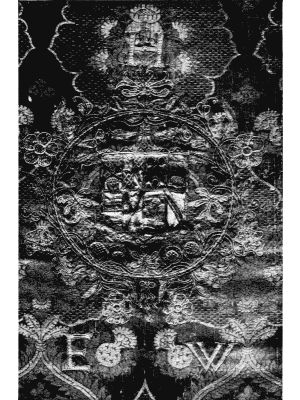
Fig. 192. Part of a bed-hanging embroidered with the arms of Henry and Elizabeth Wentworth, c. 1560, formerly in the possession of Sir A. W. Franks, K.C.B.
The monuments of the dead continue as before to be adorned with heraldry, but in a different way, and for the beautiful simple arms and devices of the medieval memorial began to be substituted the concentrated shield of the family quarterings, with crest and mantled helm, and such supporters as the College of Arms allowed or approved.
Despite the inevitable consequent formality, there is often much that is good about the treatment of Elizabethan and Jacobean heraldry, and it would not be easy, even at an earlier date, to beat the delightful lions upon the shields on the Lennox tomb at Westminster (fig. 194), or to fill up more satisfactorily a shield like that above the monument of Sir Ralph Pecksall (fig. 195). The effective way in which the shield itself is treated in this case is also praiseworthy, and both shields are models of heraldic carving in low relief.
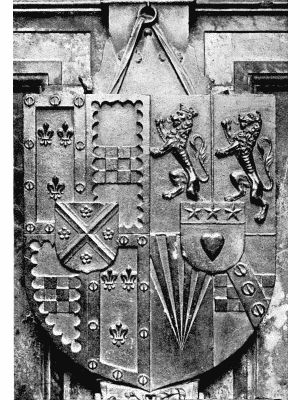
Fig. 194. Shield from the tomb of Margaret countess of Lennox (ob. 1578) in Westminster abbey church.

Fig. 195. Achievement of arms from the monument of Sir Richard Pecksall (ob. 1571) in Westminster abbey church.
The Lennox and Pecksall shields are likewise indicative of another characteristic change, the desire to illustrate ancient descent by the multiplication of quarterings. The disastrous consequences of this practice, even in the fourteenth and fifteenth centuries, have already been pointed out, but in the reign of Elizabeth it was carved to such an excess as to produce at times a mere patchwork of carved or painted quarters, in which the beauty of the heraldry was entirely lost. In the great hall of Fawsley House, Northants, there hangs a coloured achievement of the Knightley family containing actually 334[Pg 344]
[Pg 345]
[Pg 346] quarterings, which have been rightly described by Mr. J. A. Gotch as '330 too many for decorative effect.'
The heraldry of the seventeenth century is in general but a duller version of that of the later sixteenth century, with a tendency to become more commonplace as time goes on.
Under the Commonwealth every vestige of regality was ordered to be put down and done away; a very large number of representations of the royal arms were defaced and destroyed; and the leopards of England were for a time 'driven into the wilderness' along with the lion of Scotland. It was nevertheless thought desirable that the United Kingdom should still have arms, and on THE GREAT SEALE OF ENGLAND/ IN THE FIRST YEARE OF FREEDOM BY GOD'S BLESSING RESTORED, that is, 1648, the cross of St. George appears for England, and a harp for Ireland. The royal crown was at the same time superseded, on all maces and other symbols of kingly power, by another which curiously reproduces all its elements. It had a circlet inscribed THE FREEDOM OF ENGLAND BY GOD'S BLESSING RESTORED, with the date, and for the cresting of crosses and fleurs-de-lis there was[Pg 347] substituted an intertwined cable enclosing small cartouches with the cross of St. George and the Irish harp. The new crown was also arched over, with four graceful incurved members like ostrich feathers, but wrought with oak leaves and acorns. These supported a pyramidal group of four handsome cartouches with the cross and harp surrounded by an acorn, instead of the orb and cross.[29] Perfect examples of this singular republican crown still surmount the two maces of the town of Weymouth.
On the obverse of the new great seal of the Commonwealth, designed and engraved by Simon and first used in 1655, the field is filled with an heraldic achievement of some interest (fig. 196). This includes a shield with the cross of St. George in the first and fourth quarters, St. Andrew's cross in the second quarter, and the Irish harp in the third quarter, with the lion of Cromwell on a scutcheon of pretence. This shield of the State's arms is supported by a lion with a royal crown on his head, and by a dragon,[Pg 348]
[Pg 349]
[Pg 350] standing upon the edge of a ribbon with the motto PAX QVÆRITVR BELLO, and is surmounted by a front-faced helm with much flourished mantling, with a royal crown and the crowned leopard crest above, set athwart the helm.
The seal furnishes an excellent illustration of the heraldic art of the period, but it is singular that under a Nonconformist domination the arms selected for England and Scotland should consist of the crosses of their patron saints. It is also interesting to note that the expunged arms of England and Scotland had evidently been regarded rightly as personal to the murdered King. A further curious point is the reappearance on the seal of the royal crown of England above the helm and on the leopard crest and the lion supporter.
On the reverse of the seal just noted the State's new arms are repeated on a cartouche behind the equestrian figure of the Protector.
Of the heraldry of the Restoration and later it is hardly necessary to make mention, so lifeless and dull is the generality of it. A good specimen c. 1670 with the arms of the Trinity House (fig. 197), and a later one (fig. 198) with the arms,[Pg 351] etc. of the Trevor family, are to be seen in the Victoria and Albert Museum. Reference is due, too, to one other notable[Pg 352]
[Pg 353] example. This is the beautiful panelled ceiling set up over the chapel (formerly the great hall) of Auckland castle, by doctor John Cosin bishop of Durham (fig. 199). It was in making from 1662 to 1664, by a local carpenter, and consists for the most part of a series of square panels containing alternately the cross and four lions that form the arms of the bishopric of Durham, and the fret forming the arms of Cosin. In the middle bay the bishop's arms are given in an oval, and flanked by similar ovals with the eagle of St. John in allusion to his name. No earlier wooden ceiling could be finer in conception, and the effect of the whole was originally enhanced by colour and gilding, but this was most unhappily removed by order of bishop Barrington (1791-1826).
With so notable a late survival of medieval tradition this book may fitly end.
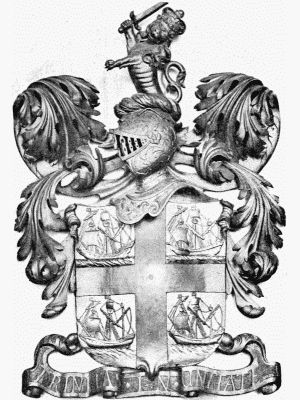
Fig. 197. Arms, etc. of the Trinity House, London. From a wood carving c. 1670 in the Victoria and Albert Museum.

Fig. 198. Limewood carving with the arms and crest of the Trevor family, c. 1700, in the Victoria and Albert Museum.

Fig. 199. Part of the carved oak ceiling of the chapel, formerly the hall, of Auckland castle, Durham, with the arms of bishop John Cosin, date 1662-4.
[29] A curious variant of this crown, with a jewelled instead of an inscribed band, heads a drawing of the city arms of the date 1651 in the Dormant Book of the corporation of Carlisle.
CHRONOLOGICAL SERIES OF ILLUSTRATIONS
The following series of illustrations is an attempt to gather up into chronological order such of the more typical examples in this book as serve to show the development and various applications of heraldic art from the thirteenth to the eighteenth century. The series could, of course, have been extended indefinitely, but the present collection is probably sufficient for its purpose.
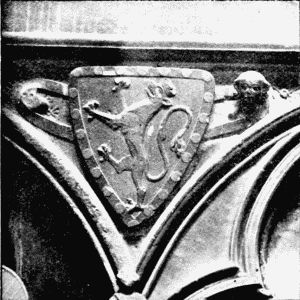
c. 1259
Tiles c. 1255 from the chapter-house and shield c. 1259 from the quire aisle of Westminster abbey
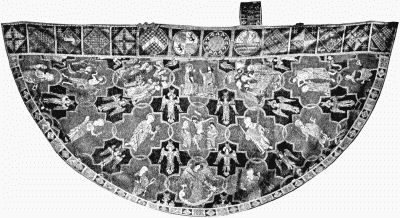
The Syon Cope, a late thirteenth-century work with armorial orphrey and border in the Victoria and Albert Museum
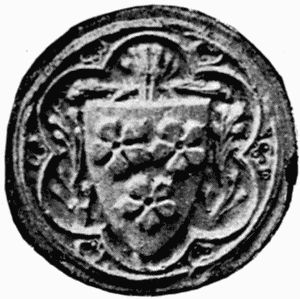
1
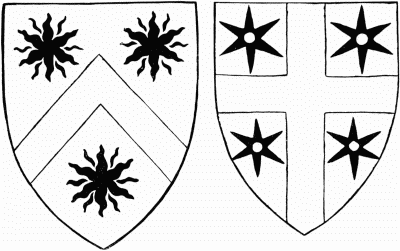
Shields from brasses at New Romney, Kent, and at Salisbury, 1375
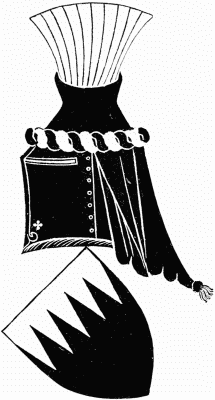
Shield and crested helm with simple mantling from a brass at Southacre, Norfolk, 1384
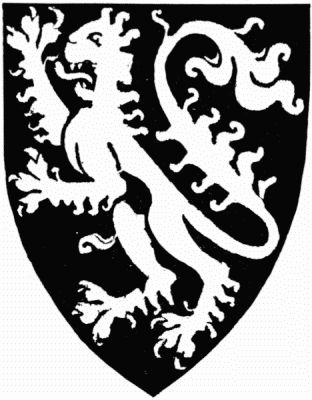
1
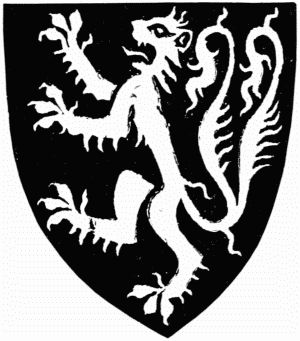
2
Shields with lions from (1) Felbrigge, Norfolk, c. 1380, and (2) from Spilsby, Lincs, 1391
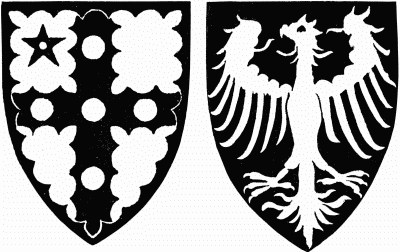
Shields from brasses at Chipping Campden, Glos. 1401, and Great Tew, Oxon, 1410
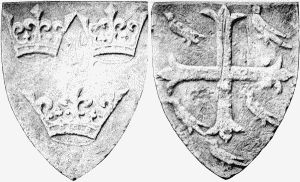
Arms of St. Edmund the King and St. Edward the Confessor, from the tomb of Edmund duke of York, ob. 1402, at King's Langley
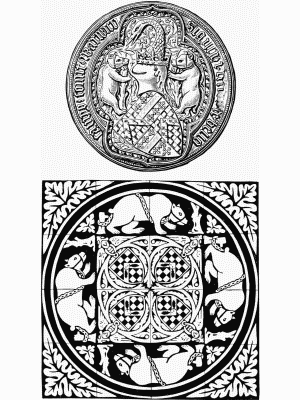
Seal of Richard Beauchamp earl of Warwick, in 1403, and early fifteenth-century heraldic tiles from Tewkesbury abbey church

Shields from brasses at Checkendon, Oxon, 1404, and Boughton-under-Blean, Kent, 1405
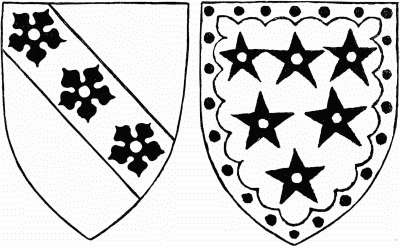
Shields from brasses at Kidderminster, Worcs, 1415, and Whitchurch, Oxon, c. 1420
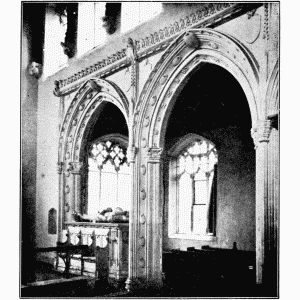
Part of the chancel arcade in Wingfield church, Suffolk, with badges of Michael de la Pole earl of Suffolk, ob. 1415, and his wife Katherine Stafford
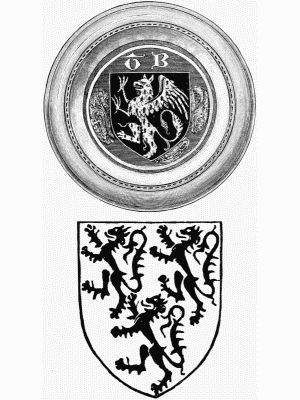
Print from a mazer at All Souls college, Oxford, c. 1450, and shield from a brass at Stanford Dingley, Berks, 1444
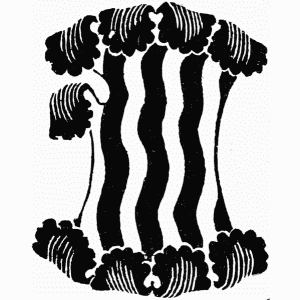
c. 1476
Shields from the chantry chapel of Thomas Ramryge abbot of St. Albans, c. 1500, and from a brass at Stoke Poges, Bucks, 1476

Oriel window in the Deanery at Wells, with badges of King Edward IV and rebuses of Dean Gunthorpe, c. 1475-80
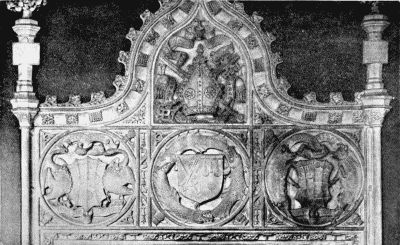
Chimney-piece in the Bishop's Palace at Exeter, with arms and badges of bishop Peter Courtenay, 1478-87

Gateway to the Deanery at Peterborough with arms and badges of King Henry VII and others, built by Robert Kirkton, abbot 1497-1526
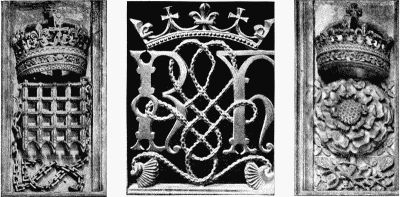
Crowned initials of King Henry VII from his chapel at Westminster, and crowned portcullis and rose from King's college chapel at Cambridge

Base of an oriel on the master's lodge at Christ's college in Cambridge with the armorial ensigns of the lady Margaret Beaufort, foundress, c. 1505

Armorial panel with the arms, etc. of the lady Margaret Beaufort, on the gatehouse of St. John's college in Cambridge
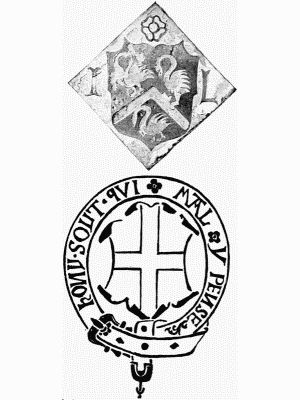
Paving tile, c. 1535, from Marten church, Wilts; and shield of St. George in the Garter from the brass of Thomas earl of Wiltshire and Ormond, 1533, at Hever in Kent
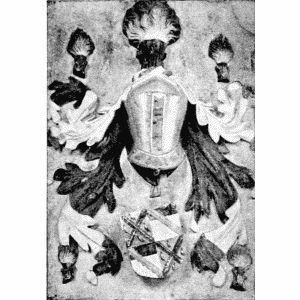
Arms with crested helm and badge of (apparently) Sir John Guldeford of Benenden, ob. 1565, in East Guldeford church, Sussex

Part of the carved oak ceiling of the chapel of Auckland castle, Durham, with the arms of bishop John Cosin. Date, 1662-4
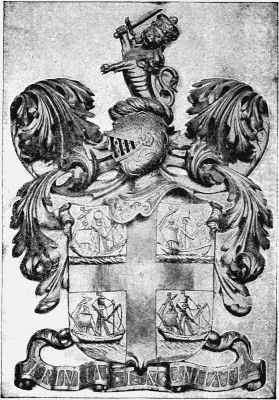
Arms, etc. of the Trinity House, London. From a wood-carving c. 1670 in the Victoria and Albert Museum
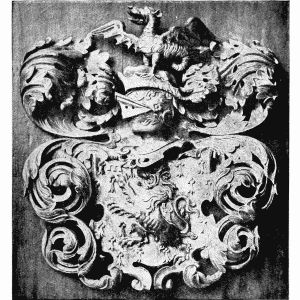
Limewood carving with the arms and crest of the Trevor family, c. 1700, in the Victoria and Albert Museum
INDEX
- Academy, Royal, heraldry at exhibitions, 33
- Acton church (Suffolk), brass in, 252
- Africa, South, 269
- Albans, Saint, 54, 164, 259, 281;
- abbey church of, 73, 74
- Albemarle, Richard earl of, see Beauchamp;
- William earl of, see Forz
- Albert Medal for Bravery, 265
- Aldeburgh arms, 326
- Aldeburgh, Margaret, 326;
- Sir William, 326
- Alderby, John of, bp. of Lincoln, 322
- Aldermaston (Berks), 306
- Alen, Sir John, 307, 308
- Alexandra, Queen, banner of, 228
- Alexandria, rubies of, 275, 290
- Alnwick, William, bp. of Norwich, 264
- Andrew, saint, cross or saltire of, 40, 225, 248, 249
- Angoulême, arms of, 119
- Anne of Bohemia, Queen, 89, 172, 185, 324
- Anstis, John, 309
- Anthony, cross of saint, 50
- Antiquaries, Society of, 233
- Aquitaine, duchy of, 154
- Arms, rolls of, 62
- Arundel (Sussex), effigy at, 277, 279
- Arundel, Beatrice countess of, 278;
- Edmund earl of, see FitzAlan;
- Joan countess of, 279, 280;
- Richard earl of, see FitzAlan;
- Thomas earl of, 273, 277;
- Sir Edmund of, 118;
- Sir William, 144, 145;
- William earl of, see FitzAlan
- Ashmole, Elias, 224
- Astley, Sir John, 131
- Aston (Warw), effigy at, 305
- Athelhampton House (Dorset), 331
- Auckland castle (Durham), ceiling in, 352, 353
- Aveline, countess of Lancaster, 120
- Badges, 165-184
- Badlesmere, Bartholomew, 117;
- Maud, 117, 118
- Baliol arms, 326
- Ballard arms, 61
- Banastre, Sir Thomas, 141
- Banner, the King's, 219, 220, 226, 227, 228
- Banners of arms, 216, 217, 219-233
- Bar, the, 40
- Barbours and Chirurgeons, Company of, 337
- Bardolf, Hugh, seal of, 68;
- William lord, see Phelip
- [Pg 412]Baret, John, 303
- Barker, Christopher, Garter, 335
- Barons' Letter of 1300-1, 49, 68, 69, 77, 82, 112, 113, 124, 125, 126, 172, 181, 195
- Barre, Henry count of, 113;
- Joan dau. of, 113
- Barrington, bishop, 353
- Barron, Mr. Oswald, 52
- Barry, 43;
- number of bars, 48
- Bartholomew, hospital of Saint, arms, 48
- Basing House (Hants), 285
- Bassett, Ralph lord, 112, 140, 142
- Baston, the, 44
- Bath, collar of the, 293;
- Order of the, 253
- Bath and Wells, Thomas bp. of, see Beckington
- Batour, John, 199
- Battled, 45
- Baunton (Glos), frontal at, 320
- Bayeux, seal for town of, 205, 210
- Beatrice countess of Arundel, 278
- Beauchamp arms, 51, 58, 63, 97;
- badges, 58, 96, 184;
- family, 103
- Beauchamp, Henry, earl of Warwick, 272;
- John, of Hacche, 197;
- Margaret, 96, 214;
- Richard, earl of Warwick and Albemarle, 61, 96, 144, 146, 204, 208, 209, 214, 221, 274, 276;
- Thomas, earl of Warwick, 175, 198
- Beaufort, Edmund, duke of Somerset, 205, 210;
- Henry, bp. of Winchester, 164;
- Joan, countess of Westmorland, 278, 282;
- John, duke of Somerset and earl of Kendal, 206, 231;
- the lady Margaret, 184, 209, 286-288
- Beaufort portcullis, 169, 288, 304
- Beaumont, John lord, 141;
- Margaret, 217
- Beckington, Thomas, bp. of Bath and Wells, rebus of, 188, 191
- Bedale (Yorks), effigy at, 73
- Bedford, Jasper duke of, see Jasper
- Bedford, John duke of, see John
- Bedford's Blazon of Episcopacy, 335
- Bek, Antony, bp. of Durham, arms of, 50
- Bend, the, 40, 41;
- Bendy, 44
- Benenden (Kent), 339
- Bensted arms, 114
- Bensted, Sir John, 114;
- Parnell, 114
- Bentley, Little (Essex), brass at, 306
- Berkeley arms, 51, 63;
- badge, 184;
- mermaid collar, 310, 311
- Berkeley, Thomas of, 125;
- Thomas lord, 309, 310
- Bermingham, Walter, 117
- Berners arms, 97
- Beverley (Yorks), 329;
- waits' collars, 313
- Beverley minster, heraldry in, 54, 106, 107, 108
- Bigod, Sir John, 299
- Boar, silver, of King Richard III, 304
- Bohemia, Anne of, see Anne
- Bohun, Eleanor, 172, 214, 323;
- Humphrey, earl of Hereford and Essex, 172, 193, 194, 196, 274;
- John de, earl of Hereford, 115;
- Mary, 92, 172, 298
- Bohun of Hereford, arms of, 96;
- of Northampton, arms of, 96
- Bohun swan badge, 172, 184, 196, 214, 298, 327
- [Pg 413]Bordeaux, John seneschal of, see Nevill
- Border, the, 41
- Boroughbridge Roll, 62
- Botreaux, Margaret lady of, see Hungerford;
- William lord, 203, 217
- Boughton-under-Blean (Kent), brass at, 81
- Bourchier arms, 97;
- knot, 184-186, 188;
- water-bougets, 182
- Bourchier, Henry, earl of Essex, 188;
- Henry lord, 158;
- Hugh lord, see Stafford;
- John lord, 143, 158;
- Lewis lord, see Robsart;
- Sir Humphrey, 97, 186;
- Thomas, abp. of Canterbury, 186
- Boutell, Rev. C., 157
- Bowet, Henry, abp. of York, 328, 329
- Brabant, arms of, 119
- Brancepeth (Durham), effigies at, 304
- Brandon, Frances, duchess of Suffolk, 110
- Braose, William de, 112
- Bristol waits' collars, 313
- British Museum, 53, 261, 262, 304
- Bromfleet, Sir Thomas, arms of, 82
- Brooke, George, lord Cobham, 133
- Broom-cods, collar of, 309
- Brotherton, see Thomas
- Bryen, arms of, 252
- Bryen, Guy lord, 73, 74, 196
- Buch, the Captal de, 141
- Buckingham, duke and earl of, see Stafford;
- Henry duke of, 96, 98
- Buckingham, earldom of, arms of, 96
- Buckingham Palace, memorial in front of, 34
- Bullen, Thomas, earl of Wiltshire and Ormond, 267
- Bures, arms of, 252
- Burgh, John of, 114;
- Sir Thomas, stall-plate of, 136;
- William of, earl of Ulster, 117, 119
- Burghersh, barony of, 200;
- Sir Bartholomew, 198
- Burlington House, see London
- Burnell, Hugh lord, 141, 149
- Burnham Thorpe (Norfolk), brass at, 296
- Burton, Thomas, bp. of Exeter, 322
- Bury St. Edmunds, St. Mary's church at, 303
- Cadhay (Devon), 338
- Caius, doctor John, 336
- Calais, arms of, 215;
- seal of mayoralty of, 214, 215
- Calthorpe, Sir William, 296
- Cambridge, arms of regius professors, 253;
- rebus on name, 189
- Cambridge, Christ's college, 179, 286, 287, 288;
- King's college chapel, 170, 181, 210, 213, 331;
- Pembroke college, 252;
- St. John's college, 181, 288, 289
- Camoys, lady, brass of, 296;
- Thomas lord, 261, 263;
- arms of, 264
- Candle-holder, heraldic, 55
- Canterbury, 61, 84, 101, 102, 132, 134, 166, 167, 168, 186, 260, 270, 271, 290, 291, 300, 303, 335
- Canterbury, Christchurch, 120, 321
- Canterbury, John abp. of, see Morton;[Pg 414]
- Thomas abp. of, see Bourchier;
- William abp. of, see Courtenay;
- William archdn. of, see Pakington
- Cap of estate, the, 154
- Carlisle Dormant book, 347
- Carnarvon, Edward of, 111
- Castile, arms of, 86, 111;
- castle of, 114;
- kingdom of, 112
- Castile and Leon, castles and lions of, 114
- Chamberlayne, Sir William, 158
- Charles IV, Emperor, 89
- Chaucer, Geoffrey, arms of, 48
- Chaworth, arms of, 117
- Checkendon (Oxon), brass at, 256
- Checky, 44;
- number of checkers, 49
- Chester, arms of, 135;
- sheriff's chain, 315
- Chester, Edward earl of, see Edward prince of Wales
- Chevaler au cing, 171
- Cheveron, the, 41, 42
- Cheyney, Sir John, 306
- Chief, the, 41, 42
- Chipping Campden (Glos), brass at, 90
- Chronological series of illustrations, 354-407
- Cinque Ports, arms of the, 135
- Clare arms, 114, 115, 117, 199;
- black bulls of, 204, 207;
- label of, 101
- Clare, Elizabeth de, 114;
- Gilbert de, earl of Gloucester, 114, 194
- Clarence, duke of, see Lionel;
- George duke of, see George;
- Thomas duke of, see Thomas
- Clehonger (Heref), 76
- Clerk, Dan John, 329
- Clifford, Robert de, 171
- Clopton arms, 45, 46
- Clun, arms of, 106
- Cobham (Kent), 133, 134
- Cobham, George Brooke, lord, 133, 134;
- Raynald, lord, 141
- Cockermouth, Henry Percy, lord of, see Percy
- Colchester, arms of, 50
- College of Arms, see Heralds' College
- Colley, Thomas de, 325
- Constance, brass at, 263, 265
- Constance of Castile, 111
- Corfe castle, Dorset, 69
- Cornwall, earl of, see Richard;
- Edmund earl of, 194;
- Edward duke of, see Edward prince of Wales
- Coronets, introduction and history of, 271-285
- Cosin arms, 353
- Cosin, John, bp. of Durham, 352, 353
- Cotes, arms of, 343
- Cotises, 45
- Counter-coloured, 48
- Courtenay dolphin, 182
- Courtenay, Hugh, earl of Devon, 116;
- Peter, bp. of Exeter, 175, 177;
- Sir Peter, 229;
- William, abp. of Canterbury, 162
- Coventry cross, 242
- Cowdray House, Sussex, 239, 331
- Crests, origin and treatment of, 123;
- use of, by bishops, 161-163
- Cromwell lion, 347
- Cromwell, Ralph lord, 57
- Cross, the, 40;
- varieties of, 49, 50
- Crosslets, 51
- Crowns, heraldic, 148-153
- Crusily, 51
- Cyprus gold, 327, 328
- D'Abernoun, Sir John, 235
- [Pg 415]Dabrichecourt, Sir Sanchet, 140, 143
- Dalton, Laurence, Norroy, 336
- D'Amory, Roger lord, 114
- Daunce, the, 45
- David, King of Scotland, 325
- Dennington (Suffolk), 60, 297
- Derby, Henry earl of, see Henry;
- Thomas earl of, see Stanley
- Despenser arms, 63, 88
- Despenser, Henry le, bp. of Norwich, 161, 162;
- Richard lord, see Beauchamp;
- Thomas lord, 199
- Devon, Hugh earl of, see Courtenay
- Deynelay, Robert, 129
- Diapering, 105-108
- Differencing of arms, 98-103
- Dimidiation, 251
- Dorking, Rev. E. E., rebus of, 192
- Dorset (county of), 59
- Dover (Kent), arms of, 135
- Dreux arms, 119
- Dublin, Richard marquess of, see Oxford
- Durham, arms of bishopric of, 353;
- bishops of, 163
- Durham, Cuthbert bp. of, see Tunstall;
- John bp. of, see Cosin, Fordham;
- Robert bp. of, see Nevill;
- Thomas bp. of, see Hatfield, Langley;
- Walter bp. of, see Skirlaw
- Easton, Little (Essex), 188
- Edmund earl of Kent, 99;
- earl of Lancaster, 100
- Edmund of Langley duke of York, 94, 101, 150, 155, 167, 199, 206, 229
- Edmund, saint, arms of, 150
- Edward I, King, 86, 99, 100, 101, 113, 114, 237
- Edward II, King, 47, 86, 99, 115, 291, 293
- Edward III, King, 61, 88, 92, 101, 125, 154, 155, 214, 215, 263, 272, 323, 324, 325, 326
- Edward IV, King, 75, 168, 190, 208, 212, 222, 225, 291, 304, 334
- Edward V, King, 200
- Edward VI, King, 272, 335
- Edward prince of Wales, 61, 84, 99, 101, 102, 132, 134, 155, 166, 167, 260, 261, 262, 271
- Edward, saint, arms of, 37, 50, 89, 94, 323
- Eleanor, daughter of King Edward I, 113
- Eleanor of Castile, Queen, 71, 86, 91, 113, 114, 170, 270, 323
- Elizabeth, Queen, 224, 225, 336
- Elsefield, Elizabeth, 118;
- Sir Gilbert, 118
- Elsing (Norf), brass at, 100, 157
- Eltham, John of, see John
- Embroideries, heraldic, 319-330
- Engayn, John, 127
- England, 59, 248, 249, 335;
- arms of, 88, 89, 99, 111, 113, 115, 350;
- leopards of, 217, 226, 346;
- lion supporter of, 206
- England, King of, 79, 322, 323;
- supporters of, 206
- Engrailing, 44
- Erdington family, knight of, 305, 312
- Ermine, 39, 258
- Erpingham, Sir Thomas, 144
- Essex, earl of, see Stafford Humphrey;
- Henry earl of, see Bourchier;
- Humphrey earl of, see Bohun
- Essex, earldom of, arms of, 193
- Est, Robert, 329
- Esturmy, Henry, see Sturmy
- [Pg 416]Etchingham church (Sussex), 239, 240
- Etchingham, Sir William, 239
- Eton College arms, 47
- Ewelme (Oxon), effigy at, 283, 284
- Exeter, bishop's palace at, 175, 177;
- brass at, 185;
- sheriff's chain, 312;
- waits' collars, 313, 314
- Exeter, duchess of, 283;
- Edward bp. of, see Stafford;
- Peter bishop of, 321;
- Peter bp. of, see Courtenay;
- Thomas bp. of, see Burton;
- Thomas duke of, see Holand;
- Thomas duke of, see Thomas
- Fairfax lions and goats, 339
- Fairfax, Sir William, 338
- Falstaff, Sir John, 203
- Farnham, Sir Robert, arms of, 48
- Fauconberg, William lord, 229
- Fawsley House (Northants), 343
- Felbrigge (Norf), brass at, 78, 89
- Felbrigge, Sir Simon, 158, 160
- Fer-de-moline, 47, 50
- Ferrers, Thomas earl, see Thomas;
- William de, 197
- Fesse, the, 40
- Fetterlock-and-falcon badge, 168, 169
- Firedogs, heraldic, 56
- FitzAlan, Alice, 273, 274;
- Brian, arms, 73;
- Edmund, earl of Arundel, 118;
- Joan, 196, 273, 274;
- Richard, earl of Arundel, 115, 273, 275;
- William, earl of Arundel, 279
- FitzAlan, arms, 116, 117;
- oak-leaf badge, 305
- FitzGerald, Emmeline, 217
- FitzHamon, Robert, arms of, 63
- FitzHugh, Henry lord, 229
- FitzHugh and Marmion, William lord, 215
- FitzJohn, John, 114
- FitzPain, Robert, 112
- FitzWalter arms, 45
- FitzWalter, Walter lord, 129
- FitzWarin seal, 196
- FitzWaryn, Sir William, 141
- Flanches, 42
- Foljambe arms, 119
- Foljambe, Roger, 118
- Fordham, John, bp. of Durham, 163
- Forster, Sir George, 306
- Forz, William of, earl of Albemarle, 120
- Fotheringay church (Northants), 239
- France and Normandy, Richard, governor of, see Richard
- France, arms of, 88, 115, 119, 120, 224, 322, 323, 324;
- label of, 100
- France, John, marshal of, see Talbot;
- John, regent of, see John
- France, King of, 80, 85, 154
- France, Old, arms of, 89
- France, Philip King of, 322
- Franks, Sir A. W., 342
- Furnival, Thomas, 112
- Garter, collar of the, 281, 293, 295;
- mantle of the, 280, 281;
- Order of the, 253, 260, 261
- Garter, Knights of the, banners of, 224, 225, 228;
- stall-plates of, 62, 70, 112, 130, 138, 151, 229, 259
- Garter, the, 260-267
- Gaunt, see John of
- Gemell-bars, 45
- [Pg 417]George duke of Clarence and lord of Richmond, 203, 204, 207, 229
- George, saint, arms or cross of, 49, 226, 234, 235, 248, 249, 267, 346, 347
- Gilling castle (Yorks), 338, 340
- Glamorgan, lordship of, 200
- Glass, heraldic, 54
- Glastonbury, George inn at, 74, 75
- Gloucester, city of, 298;
- arms, 335;
- effigy at, 293
- Gloucester, duke of, see Thomas;
- Gilbert earl of, see Clare;
- Richard duke of, 59
- Gobony, 83
- Goldsmiths' Company, arms, 72
- Goldwell, James, bp. of Norwich, 162, 191
- Gonvile arms, 45
- Gotch, Mr. J. A., 346
- Gower, John, 298
- Grapenell, H. de, 114;
- Parnel, 114
- Graunson, Katharine, 117;
- Margaret, 196
- Grevel, William, brass of, 90
- Grey, lady Jane, 285
- Grey of Codnor, Richard lord, 151, 153, 182, 183
- Grey of Ruthin, Sir John, 229, 232
- Groos, Oliver, 301
- Guienne, duchy of, 155
- Guildford (Surrey) mayor's chain and medal, 315
- Guldeford, East (Sussex), 338, 339
- Guldeford, Sir John, 338, 339
- Gunthorpe, dean, 74, 190, 192
- Gyronny, 41
- Hainault, arms of, 323;
- house of, 166
- Hales, Sir Stephen, 129
- Hallam, Robert, bp. of Salisbury, 263, 265
- Halle, Peter, brass of, 93
- Halving of arms, 251
- Hamlake, see Roos
- Hampton Court, 331;
- heraldry at, 243-248
- Harcourt, Sir Robert, 305
- Harewell, bishop, effigy of, 192
- Harsick brass at Southacre, 158, 159
- Hastings arms, 117
- Hastings, John, earl of Pembroke, 275;
- John lord, 117;
- Sir Hugh, arms, brass, and crest of, 100, 157;
- Sir Ralph 174, 328;
- William lord, 140, 204
- Hatfield, Thomas, bp. of Durham, 163
- Hatfield Broadoak (Essex), effigy at, 104, 106
- Hearne, T., 242
- Helmsley, see Roos
- Hengrave Hall (Suffolk), 331
- Henry III, King, 36, 99, 170, 291, 292
- Henry IV, King, 92, 168, 172, 200, 270, 290, 291, 297, 298, 299, 300
- Henry V, King, 302, 309
- Henry VI, King, 47, 264, 272, 309, 334
- Henry VII, King, 55, 154, 169, 181, 210, 213, 266, 288, 294, 306
- Henry VIII, King, 72, 211, 245-248, 291, 308, 331-335
- Henry duke of Lancaster and earl of Derby, 91, 128, 167, 200, 297, 298, 299, 300, 309
- Henry earl of Lancaster, 117
- Heraldic beasts as finials and vane holders, 238-239, 241-248
- Heraldic colours, 37, 38;
- furs, 39
- Heraldry, definition of, 35
- [Pg 418]Heralds' College, 233, 235, 334, 336, 341
- Hereford, arms of, earldom of, 214, 327
- Hereford, duke of, 92;
- earl of, see Stafford, Humphrey;
- Henry duke of, see Henry;
- Humphrey earl of, see Bohun;
- John earl of, see Bohun
- Herne (Kent), brass at, 93
- Heslerton, Alice, 118;
- Thomas of, 118
- Heslerton arms, 118
- Hever (Kent), brass at, 267
- Hexham, regality of, seal of, 105
- Heytesbury, banner of, 216
- Holand, Joan, 206;
- Thomas, duke of Exeter, 282;
- Thomas, earl of Kent, 168, 206, 214, 274;
- Thomas de, 129
- Holand, lordship of, 213
- Holand and Wake, Thomas lord, 211
- Holbeach (Lincs), effigy at, 257
- Holbein, the painter, 295, 306, 307
- Hollar (Wenceslaus), 242
- Holyngbroke, William, arms of, 87
- Hope rebus, 192
- Howard, Thomas, duke of Norfolk, 295, 329
- Humphrey duke of Gloucester and earl of Buckingham, 96, 164, 281
- Hungerford and Botreaux, Margaret lady of, 217, 222, 239
- Hungerford, Robert lord, 60, 303;
- Sir Robert, 217;
- Walter lord, 144, 216, 221, 222, 229, 230
- Hungerford sickle, 182, 216
- Hussey arms, 116, 144;
- banner of, 216
- Huth, Mr. Edward, 307
- Ich diene, the motto, 166
- Illustrations, Chronological series of, 354-407
- Impalement of arms, 252
- Indenting, 45
- Ireland, 249;
- harp of, 226, 347
- Isabel, sister of Richard duke of York, 188
- Isabel, Queen, 115, 324
- Islip, John, abbot of Westminster, rebus of, 189, 191
- James I, King, 283
- Jane the fool, 248
- Jasper duke of Bedford, 164
- Jerusalem, Kingdom of, arms of, 51
- Joan, countess of Arundel, 279, 280, 304
- Joan, dau. of King Edward I, 114
- Joan princess of Wales, 174, 326
- Joan, Queen, 299, 303;
- effigy of, 270, 271
- John duke of Bedford and regent of France, 215, 229
- John of Eltham, the lord, 99, 323
- John of Gaunt duke of Lancaster, 101, 111, 155, 166, 167, 174, 199, 272, 324, 328
- John, saint, eagle of, 353
- John, Saint, John lord, 275
- Katharine, saint, hospital of, 282, 283
- Kendal, John earl of, see Beaufort
- Kensington, South, 119
- Kent, earl of, see Edmund;
- Thomas earl of, see Holand
- Keys, Roger, and Thomas, arms of, 47, 48
- Kidderminster (Worcs), brass at, 88
- King's Langley (Herts), 150
- King's Lynn waits' collars, 313, 314
- [Pg 419]Kingston-on-Hull, mayor's and mayoress's chains, 315
- Kirby Hall (Northants), 338
- Kirkham priory (Yorks), heraldry on gatehouse, 38
- Kirkton, Robert, abbot of Peterborough, 178;
- rebus of, 188, 191
- Knightley family, 343
- Knots as badges, 184
- Label, the, 99
- Laci, Henry de, arms of, 44;
- Henry de, earl of Lincoln, 124, 194
- Lacy arms, 119
- Ladies, arms of, 109
- Lancaster, Aveline countess of, 120;
- Henry of, lord of Monmouth, 125, 126, 127, 194;
- Thomas earl of, see Thomas
- Lancaster, duke of, see John of Gaunt
- Lancaster, earl of, see Edmund
- Lancaster, House of, 296
- Langeton, canon William, 185
- Langley, see Edmund of
- Langley, Thomas, bp. of Durham, 163
- Latimer, William lord, 141, 328
- Lavenham church (Suffolk), 175
- Lavenham, William of, 273
- Law, Ernest, 244
- Legg, L. G. Wickham, 155
- Leicester, Thomas earl of, see Thomas
- Lennox, Margaret countess of, tomb of, 341, 343, 344
- Leon, arms of, 86, 111;
- lion of, 114
- Leybourne arms, 117, 120, 125, 322
- Leybourne, Juliana, 117;
- Roger, 124, 211;
- Thomas, 117
- Lincoln, Henry earl of, see Laci;
- Henry de Laci earl of, 44;
- John bp. of, see Alderby
- Lincoln minster, heraldry in, 54
- Lionel duke of Clarence, 101, 272
- Lisle effigy at Thruxton, 308
- Little Device, the, 154
- Littlebury, Sir Humphrey, effigy of, 257
- London, 299;
- arms of, 337;
- banner of the lord mayor of, 219, 226, 228;
- collar of SS of lord mayor, 308, 315;
- sheriff's chains, 315;
- waits' collars, 313
- London, Burlington House, 233;
- Mansion House, 219, 226;
- National Portrait Gallery, 211;
- Nelson Column in, 290;
- St. Paul's cathedral church, 108, 228, 323;
- Templars' church in, 105;
- Trinity House, arms, 349, 350
- Longespee, Emmeline, 217;
- Stephen, 194, 217
- Longespee lions, 200;
- longswords, 182, 217
- Long Melford (Suffolk), 46
- Lord, Our, arms of, 49
- Lovain arms, 97
- Lovel badge, 184
- Lovel, Francis viscount, 147;
- John lord, 304;
- Katharine, 321
- Lovel and Holand, William lord, 200
- Lowick church (Northants), 187, 188
- Lozenges of arms, use of, 110
- Lozengy, 44
- Lucy arms, 218;
- pike, 182
- Lullingstone (Kent), 191, 192
- Lupton, Robert, provost of Eton, rebus of, 191
- Lyhart, Walter, bp. of Norwich, 191
- Lyte, John, arms of, 334 [Pg 420]
- Macclesfield, Thomas, seneschal of, 183
- Magnavilla, Geoffrey de, 105
- Man, Isle of, 183
- Manners effigy at Windsor, 306
- Mansion House, see London
- Mantlings, 139-147
- Mapperton manor-house (Dorset), 238, 243
- March, earls of, 168;
- Edmund earl of, see Mortimer;
- Richard earl of, see Richard;
- Roger earl of, see Mortimer
- March, white lion of, 206, 208, 209, 304, 326
- Margaret, saint, 313
- Markenfield, Sir Thomas, 309, 310
- Marmion, William lord, see FitzHugh
- Marni, Sir Robert de, 129, 130, 198
- Martel family, 189
- Marten church (Wilts), tile from, 334
- Mary I, Queen, 313, 336
- Mary, Queen, banner of, 228
- Masons' Company, 134
- Maud of Lancaster, 117, 119
- Mauley arms, 128
- Mauley, Peter de, IV, seal of, 82;
- Peter de, VI, 128, 198
- Mayors' collars or chains, 313
- Michael, St., and St. George, Order of, 108, 228
- Mildenhall (Suffolk), brass formerly at, 301
- Monmouth, Henry lord of, see Lancaster
- Montagu griffin, 205
- Montagu, John lord, see Nevill;
- Simon lord of, 69, 86;
- Sybil, 117;
- William, earl of Salisbury, 117, 125, 127, 152, 195
- More, Sir Thomas, 306, 307, 312
- Mortimer arms, 174, 302, 326
- Mortimer, Edmund, earl of March and Ulster, 174, 197, 201, 274, 302, 325;
- Philippa, 274;
- Roger, earl of March and Ulster, 199
- Morton, John, abp. of Canterbury, 164;
- Thomas, canon of York, 328
- Moulton, Thomas de, 124
- Moun, John de, 195
- Mounci, Walter de, 128
- Mugginton (Derbys), brass at, 304
- Multon, Elizabeth de, 117
- Nanfant, Sir Richard, 233
- Nelson Column in London, 290
- Nevill, Alexander, abp. of York, 162;
- Cecily, 208, 212;
- John lord, 277;
- John, lord Montagu, 203;
- John, lord of Raby, 199;
- Margery, wife of John lord, 277;
- Ralph, earl of Westmorland, 278;
- Richard, earl of Salisbury and Warwick, 93, 137, 138, 160, 200, 205, 229, 231;
- Robert, bp. of Durham, 163, 164;
- Sir William, 199
- Nevill, effigies at Brancepeth, 304;
- family, 103
- Newburgh, arms of, 97
- Newcastle sheriff's chain, 315
- New Hall (Essex), 210, 291, 332, 333
- Nicolas, Sir N. H., 273
- Norfolk, Thomas duke of, see Howard
- Normandy, duchy of, 154, 155
- Northampton, earl of, see Stafford, Humphrey
- Northumberland, duke of, 311, 312;[Pg 421]
- earl of, 311;
- Henry earl of, see Percy
- Northwood arms, 120, 322
- Norwich arms, 72;
- mayor's chain, 315;
- sheriff's chain, 315;
- waits' collars, 313, 314
- Norwich cathedral church, 192, 263, 306
- Norwich Guildhall, doorway in, 71, 72
- Norwich, Henry bishop of, see Despenser;
- James bp. of, see Goldwell;
- Walter bp. of, see Lyhart;
- William bp. of, 264
- Ockwells (Berks), heraldic glass at, 211
- Oldhalle, Sir William, 182
- Ordinaries, the, formation of, 40, 41
- Orle, the, 42
- Ormond, Thomas earl of, see Bullen
- Ostrevant, Comté of, 166
- Ostrich-feathers badge, 166
- Oxenbridge, John, rebus of, 192
- Oxford, rebus on name, 189
- Oxford, All Souls' college, 61;
- Magdalen college, 112;
- Queen's college, seal of, 80
- Oxford, John earl of, see Vere;
- Richard earl of, and marquess of Dublin, 272;
- Robert earl of, see Vere
- Pakington, William, archdn. of Canterbury, 326
- Pale, the, 40
- Paly, 43;
- number of pales, 49
- Park-palings, collar of, 309, 310
- Party, 40;
- Party-bendwise, 40;
- Party-fessewise, 40;
- Party-saltirewise, 41
- Passion, instruments of the, 49
- Patrick, saint, 249;
- cross or saltire of, 225
- Paul, saint, sword of, 226
- Pavely, Sir Walter, 141
- Paynel, William, 113
- Peche, Sir John, 125;
- rebus of, 191, 192
- Pecksall, Sir Ralph, 341, 343, 345
- Pelham, Sir John, badge of, 200
- Pembridge, effigy of a, 76
- Pembroke, earl of, 323;
- see also Valence
- Pembroke, John earl of, see Hastings
- Pennons, 235-237
- Perche, earl of, see Stafford, Humphrey
- Percy arms, 50;
- badge, 312;
- crescent badge, 184, 218, 236;
- lion, etc., 218
- Percy, Henry, 77, 239;
- Henry, earl of Northumberland and lord of Cockermouth, 218, 238, 239;
- the lady Eleanor, 106, 107, 108
- Peter, bishop of Exeter, 321
- Peter, saint, arms of, 323, 328, 329
- Peterborough (Northants), deanery gateway at, 178, 181, 188, 191
- Phelip eagle, 48, 182
- Phelip, William, lord Bardolf, 60, 182, 297
- Philip, King of France, 322
- Philippa, Queen, 166, 167, 323
- Pile, the, 42;
- Pily, 43
- Pol, Seynt, Mary de, 115, 116, 251
- Pole, de la, arms, 335;
- badges, 182
- Pole, de la, John, duke of Suffolk, 283;[Pg 422]
- Michael, earl of Suffolk, 175, 176, 275;
- William, earl of Suffolk, 141, 202
- Ponthieu, arms of, 71
- Poynyngs, arms of, 120, 322
- Raby, John lord of, see Nevill
- Ramryge, abbot Thomas, 73
- Rebus, the, 189-192
- Redvers arms, 120
- Regent's Park, 282, 283
- Richard I, King, 124
- Richard II, King, 89, 168, 172, 173, 174, 272, 309, 326
- Richard III, King, 168, 304, 335
- Richard duke of Gloucester, seal of, 59
- Richard duke of York and earl of March, 167, 188, 206, 208, 212, 218, 239
- Richard earl of Cornwall, arms of, 66
- Richmond, George, lord of, see George;
- Margaret countess of, see Beaufort
- Richmond, label of, 101
- Ripon (Yorks), 309, 310
- Rivers, Richard lord, see Wydvile
- Robsart, Lewis, lord Bourchier, 157, 181, 222, 223, 224, 239
- Rochester (Kent), 219
- Roll, the Great, 47, 48, 50, 62, 86
- Rolls of arms, 62
- Romans, Richard, King of the, 194
- Romney, New (Kent), brass at, 87
- Roos, Thomas lord, of Hamlake, 200
- Rothwell (Northants), 338
- Roundels of arms, use of, 111
- Royal Society, 233
- Salisbury cathedral church, 60, 87, 303, 306
- Salisbury, earl of, see Nevill, Richard;
- William earl of, see Montagu
- Salisbury, Robert, bp. of, see Hallam
- Salkeld (Cumb), effigies at, 306
- Salkeld family, effigies, 306, 312
- Saltire, the, 40, 41
- Savernake Forest, lord of, see Sturmy;
- tenure horn of, 116
- Scales family, 189
- Scales, Sir Roger, 198
- Scarcliffe (Derbys), effigy at, 275, 276
- Scotland, 85, 248;
- arms of, 34, 85, 350;
- lion of, 226, 346;
- tressure of, 85;
- unicorn supporter of, 206
- Scotland, King of, 321, 323
- Scrope crab or scrap, 182
- Scrope, John lord, 158, 175;
- Dan Richard, 329
- Scutcheon, the, 42
- Seals, heraldic, 52
- Selden's Titles of Honour, 273
- Settrington (Yorks), 299
- Sheffield, St. Peter's church, effigies in, 280, 281
- Shene Charterhouse, prior of, 302
- Shield, divisions of the, 40, 41;
- the, and its treatment, 65
- Shorne, Maister John, 242
- Shrewsbury, George earl of, 280;
- John earl of, see Talbot
- Simon the engraver, 347
- Skirlaw, Walter, bp. of Durham, 163
- Sloley church (Norf), tomb in, 301
- Somers, Will, 248
- [Pg 423]Somerset (county of), 59
- Somerset eagle, 206, 209
- Somerset, Edmund duke of, see Beaufort;
- John duke of, see Beaufort
- Souche, Alan la, 194, 196
- Southacre (Norf), brass at, 159
- Southampton, arms of, 48, 86;
- steward of, 302
- Southwark cathedral church, 164, 298
- Souvereyne, Soverayne, or Soverain, the word, 167, 200, 298, 300
- Sovereign, the, 85, 155
- Spain, arms of, 323
- Spilsby (Lincs), brass at, 255
- SS, collar of, 296-304
- Stafford arms, 96
- Stafford, earl of, see Stafford, Humphrey
- Stafford, Edward, bp. of Exeter, 185;
- Edward, earl of Wiltshire, 187, 188;
- Hugh, earl of, 275;
- Hugh, lord Bourchier, 144, 151, 152;
- Humphrey, duke of Buckingham, 93, 94, 95, 96, 135;
- Joan, countess of Kent and lady of Wake, 188;
- Katharine, 175, 176, 275;
- Sir Henry, 234, 338
- Stafford knot, 184, 185, 188, 338
- Staindrop (Durham), 276, 278, 282
- Standard, the Royal, 220, 227
- Standards, 234-235
- Stanford Dingley (Berks), brass at, 83
- Stanley, Thomas lord, 158, 183, 229
- Stanton Harcourt (Oxon), 241, 305
- Stapleton, Sir Miles, 144
- Stapleton talbot, 339
- State's arms, 347, 348, 350
- Stoke d'Abernoun (Surrey), 235
- Stoke Poges (Bucks), brass at, 70
- Stothard's Monumental Effigies, 269, 276
- Stowe, William, the elder, 310
- Sturmy, Henry, 116
- Suffolk, Alice duchess of, 283, 284;
- duchess of, see Brandon;
- Elizabeth duchess of, 283;
- John duke of, see Pole;
- Michael earl of, see Pole;
- William duke of, 283;
- William earl of, see Pole
- Suns-and-roses, collar of, 304, 305
- Supporters, origin and uses of, 193-218
- Surrey, John earl of, see Warenne
- Swynburne family, 189
- Syon cope, 119, 120, 121
- Talbot, John, earl of Shrewsbury, 96, 97, 161, 214, 229, 281
- Talbot and Furnival, John lord, 203, 205
- Tallow-Chandlers' Company, 134
- Tankerville, John earl of, 158
- Tattershall castle (Lincs), heraldic chimney-piece in, 57
- Tew, Great (Oxon), brass at, 79
- Tewkesbury abbey church, 58, 63, 73, 74
- Thistle, collar of the, 293
- Tildesley, Christopher, 299, 300
- Tillzolf arms, 326
- Tiptoft, John lord, 229
- Thomas duke of Clarence, 302
- Thomas duke of Exeter, 200
- Thomas (Beaufort) duke of Exeter, 230
- [Pg 424]Thomas earl of Lancaster, Leicester and Ferrers, 125, 126, 194
- Thomas of Brotherton, 100
- Thomas of Woodstock duke of Gloucester, 99, 155, 166, 167, 172, 182, 213, 323, 326, 327
- Thomas, saint, of Canterbury, 335
- Thruxton (Hants), effigy at, 308
- Tong (Salop), 306
- Toni, Robert de, 171
- Torregiano, 266
- Trau, the Soudan de la, 144
- Tresham, Sir Thomas, 338
- Tresham trefoils, 338
- Tressure, the, 85
- Trevor family arms, 351
- Trinity, the Holy, 261, 306
- Trinity House, London, arms, 349, 350
- Trotton (Sussex), 261, 263, 296
- Trumpington family, 189
- Tunstall, Cuthbert, bp. of Durham, 163
- Twyford, Richard, 323
- Tylney, Elizabeth, arms of, 97
- Ufford arms, 335
- Ufford, Sir Ralph, 117, 119
- Ulster arms, 174, 326;
- badge of, 218;
- label of, 101
- Ulster, Richard earl of, 114;
- Roger earl of, see Mortimer;
- William earl of, see Burgh
- Union Jack, 219, 225, 248, 250
- Union of crowns of England and Scotland, 206
- Vair, 39, 258;
- Vairy, 39
- Valence arms, 119, 120
- Valence, Aymer of, earl of Pembroke, 115, 116, 251, 273;
- William of, 61, 67, 120
- Veer, Hugh de, 181
- Verdon, Theobald lord, 114
- Vere arms, 88, 104, 117;
- boar, 182;
- molet, 48, 182
- Vere effigy at Hatfield Broadoak, 106
- Vere, John de, earl of Oxford, 117, 118, 175;
- Robert de, earl of Oxford, 124
- Vernon effigy at Tong, 306
- Victoria, Queen, memorial to, 33
- Victoria and Albert Museum, 53, 119, 121, 349, 351
- Victory, figure of, 34
- Vipont, Isabel, 171
- Voided scutcheon, the, 42
- Waits' collars, 313
- Wake knot, 184;
- lordship of, 213
- Waldby, Robert, abp. of York, 105
- Walden, de, Library, 235
- Walworth, Sir William, 226
- Walysel, Thomas, brass of, 90
- Warde, Robert de la, 128
- Warenne, John de, earl of Surrey, 113
- Warenne and Surrey, earl of, arms, 49
- Warenne estates, 115
- Warre, John la, 198
- Warwick, 61, 274, 276
- Warwick bear, 205
- Warwick, earl of, see Beauchamp;
- Henry earl of, see Beauchamp;
- Richard earl of, see Beauchamp;
- Thomas earl of, see Beauchamp
- Waterford, John earl of, see Talbot
- Waterton, Robert, 298
- Wavy, 43
- Wax-Chandlers' Company, 134
- Welles, Helen, of York, 328
- Wells chapter-house, 302
- Wells (Somerset), 74, 190, 191, 192;[Pg 425]
- oriel in deanery, 190, 192
- Wentworth arms and family, 342
- Westminster, 270, 294
- Westminster abbey, arms of, 86;
- abbey chapter-house, tiles in, 36;
- vestry of, 322
- Westminster abbey church, heraldry in, 37, 43, 44, 54, 55, 61, 66, 67, 71, 80, 85, 86, 91, 92, 97, 99, 110, 120, 169, 170, 172, 173, 180, 181, 184, 186, 189, 222, 223, 259, 266, 332, 341, 344, 345
- Westminster, palace of, 221, 285
- Westmorland, Joan, countess of, see Beaufort;
- Ralph earl of, see Nevill
- Whatton (Notts), effigy at, 73
- Whatton, Sir Richard, 73
- Whitchurch (Oxon), brass at, 90
- Whitchurch (Salop), 281
- White hart badge, 168
- Wilfrid, saint, 311
- Willoughby d'Eresby, William lord, 143
- Wilton House (Wilts) diptych at, 309
- Wiltshire, Edward earl of, see Stafford;
- Thomas earl of, see Bullen
- Winchester, Henry bp. of, see Beaufort;
- John marquess of, 285
- Windsor castle, chapel of St. George in, 62, 112, 113, 151, 192, 224, 241, 242, 243, 306, 331;
- King's hall in, 238, 239;
- picture in, 295
- Windsor, Sir William, 201
- Wingfield church (Suffolk), 175, 176, 283
- Woodstock, Thomas of, see Thomas
- Wotton-under-Edge (Glos), brass at, 309, 310
- Wreath or torse, 156-158
- Wren, Sir Christopher, 242
- Wulcy, Thomas, cardinal, 334, 335
- Wydvile, Richard, lord Rivers, 144, 147, 158, 229
- Wymington (Beds), brass at, 82
- Wyvil, Robert, bp. of Salisbury,
- arms of, 87
- Yale or eale, the, 206, 209
- Yarmouth (Norf), mayor's chain, 315
- York, 328, 329;
- chains of lord mayor and lady mayoress, 315;
- waits' collars, 313
- York, Alexander abp. of, see Nevill;
- Henry abp. of, see Bowet;
- Robert abp. of, see Waldby
- York, duke of, see Edmund of Langley;
- Richard duke of, see Richard
- York falcon, 206, 208, 218;
- fetterlock, 188;
- house of, 168, 169;
- roses, 200
- York minster, heraldry in, 43, 54, 259
- Yorkist collar of suns and roses, 304-305, 312
PRINTED AT THE BALLANTYNE PRESS LONDON
BY SPECIAL 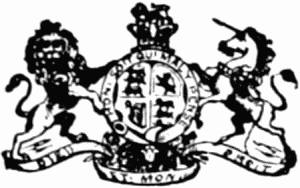 APPOINTMENT
APPOINTMENT
ARTISTS' COLOURMEN TO THEIR MAJESTIES THE KING AND QUEEN AND TO H.M. QUEEN ALEXANDRA
WINSOR & NEWTON LTD.
MANUFACTURERS OF FINEST WATER COLOURS FOR HERALDIC BLAZONING, ILLUMINATING, ETC.
Cake Colours, Moist Colours in Glass Pots. Gold and Silver Shells, Saucers and Tablets, Gold Paper, Vellums, Brushes, and all requisites for the Art
BOXES FITTED WITH COLOURS AND MATERIALS

ILLUSTRATION OF "GUINEA" BOX OF MOIST COLOURS IN GLASS POTS, WITH MATERIALS
Larger and more complete boxes 1½, 2, 3 and 5 guineas
Winsor & Newton's Colours and Materials may be obtained from the principal dealers throughout the world.
Offices: RATHBONE PLACE, LONDON, W.
GOVERNMENT CONTRACTORS W. M. WHEATLEY & SONS
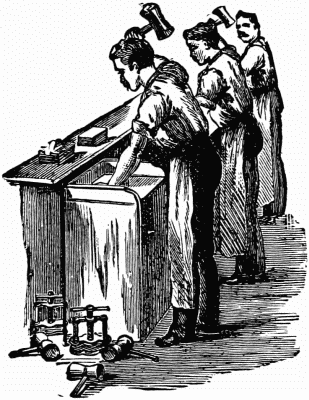
(Established a Century)
GOLD AND SILVER BEATERS AND BRONZE POWDER MANUFACTURERS
38 Devonshire Street Queen Square LONDON, W.C.
Gold Leaf in all Shades. Speciality for Bookbinders.
Telephone: Central 7206 Registered Trade Mark
NEW VOLUME IN THE PRESS
COSTUME: ITS ESSENTIALS AND POSSIBILITIES, BASED ON HISTORIC EXAMPLES. By TALBOT HUGHES. A Handbook on Historic Costume from early times, containing over 600 Figures, 31 Collotype Reproductions of 100 specimens of Genuine Dresses, besides 80 Scaled Patterns, taken from Antique Apparel, together with over 400 Illustrations of Head-dresses and Foot-wear.
JOHN HOGG
13 Paternoster Row, London
THE ARTISTIC CRAFTS SERIES
BOOKBINDING AND THE CARE OF BOOKS. By DOUGLAS COCKERELL. 122 Drawings by NOEL ROOKE. 8 Pages Collotype Reproductions. 352 pp. 5s. net. (Third Edition.)
Extract from The Times.
"... A capital proof of the reasoned thoroughness in workmanship, which is the first article in the creed of those who ... are attempting to carry into practice the industrial teaching of Ruskin and William Morris."
SILVERWORK AND JEWELLERY. By H. WILSON. 280 Diagrams by the Author. 32 Pages of Collotype Reproductions. 500 pp. 6s. 6d. net. (Second Edition.)
Containing special chapters, fully illustrated, based on demonstrations and with notes by Professor Unno Bisei and Professor T. Kobayashi, of the Imperial Fine Art College at Tokyo, giving the traditional method of Casting, Damascening, Incrustation, Inlaying, Engraving, and Metal Colouring still practised in Japan, also on Niello, the Making of Boxes and Card Cases, with chapters on Egyptian and Oriental methods of work.
By the same Author.
"ON WORKMANSHIP." A Lecture. 1s. 6d. net.
JOHN HOGG, 13 Paternoster Row, London
See following pages.
THE ARTISTIC CRAFTS SERIES
WOODCARVING: DESIGN AND WORKMANSHIP. By GEORGE JACK. 79 Drawings by the Author. 16 Pages of Collotype Reproductions. 320 pp. 5s. net.
Extract from The Builders' Journal.
"Undoubtedly the best guide to Woodcarving extant.... A practical work, written with clearness and literary power by a practical man ... of great artistic talent.... The illustrations are excellent."
STAINED GLASS WORK. By C. W. WHALL. 73 Diagrams by Two of His Apprentices. 16 Pages of Collotype Reproductions. 392 pp. 5s. net.
Extract from The Scotsman.
"It provides an exposition at once instructive and interesting of the workshop practice of the craft ... of Stained Glass, animated throughout by an encouraging and cheerful sense of the dignity and the elevating influence of such an occupation."
JOHN HOGG, 13 Paternoster Row, London
THE ARTISTIC CRAFTS SERIES
EMBROIDERY AND TAPESTRY WEAVING. By Mrs. A. H. CHRISTIE. 178 Diagrams and Illustrations by the Author. 16 Pages of Collotype Reproductions. 420 pp. 6s. net. (Third Edition.)
Extract from The Pall Mall Gazette.
"Mrs. Christie has performed her task to admiration, ... and her lucid explanations of various kinds of stitches ... should be of value to all workers at embroidery or tapestry weaving and to novices anxious to learn."
WRITING AND ILLUMINATING, AND LETTERING. By EDWARD JOHNSTON. 227 Illustrations and Diagrams by the Author and NOEL ROOKE. 8 Pages of Examples in Red and Black. 24 Pages of Collotype Reproductions. 512 pp. (Fifth Edition.)
Extract from The Athenæum.
"... This book belongs to that extremely rare class in which every line bears the impress of complete mastery of the subject. We congratulate Mr. Johnston on having produced a work at once original and complete."
JOHN HOGG, 13 Paternoster Row, London
See next page
THE ARTISTIC CRAFTS SERIES
HAND-LOOM WEAVING. By LUTHER HOOPER. 125 Drawings by the Author and NOEL ROOKE. Coloured and Collotype Reproductions. 368 pp. 6s. net.
Extract from The Morning Post.
"... Every phase and process in weaving is described with so clear and careful an exactitude, that, helped as the text is by the Author's sketches and diagrams, the reader should have no difficulty in conquering with its aid the rudiments of the craft."
PORTFOLIOS (in the Series) already issued.
SCHOOL COPIES AND EXAMPLES. Selected by W. R. LETHABY and A. H. CHRISTIE. 12 Drawing Copies (1 in colours), with Descriptive Letterpress. 3s. 6d. net.
MANUSCRIPT AND INSCRIPTION LETTERS. For Schools and Classes and the Use of Craftsmen. By EDWARD JOHNSTON. With 5 Plates by A. E. R. GILL, 16 Plates in all. Full Notes and Descriptions by the Author. 3s. 6d. net. (Second Edition.)
(Plaster Casts of the originals of Plates 13, 14 and 15 can be had of the Publisher. Write for Prospectus.)
Other Volumes and Portfolios in Preparation.
JOHN HOGG, 13 Paternoster Row, London
Transcriber's Notes
Changes to the text are limited to corrections of typographical errors and are listed as follows:
Page 26 (index of text illustrations) #105: changed "S'afford" to "Stafford" (Edward Stafford bishop of Exeter)
Page 309: changed "Wootton-under-Edge" to "Wotton-under-Edge". This same mis-spelling is also corrected in the caption to Figure 185 and in the list of illustrations on page 31. Note that it was spelled correctly in the Index.
Page 426: changed "A" to "AT" (PRINTED AT THE BALLANTYNE PRESS)
Plate XXIX caption: changed "ob," to "ob." (Justice in Eyre of Forests, ob. 1460.)

